FOOD sOVereIGnTY
DIreCTOr
Clara Oloriz
InsTruCTOr
Jose Alfredo Ramirez Galindo
Eduardo Rico-Carranza
TeChnICal InsTruCTOr
Daniel Kiss
Elena Luciano Suastegui
MeMbers
Meike
Chenxu
Jiamin
Jingru
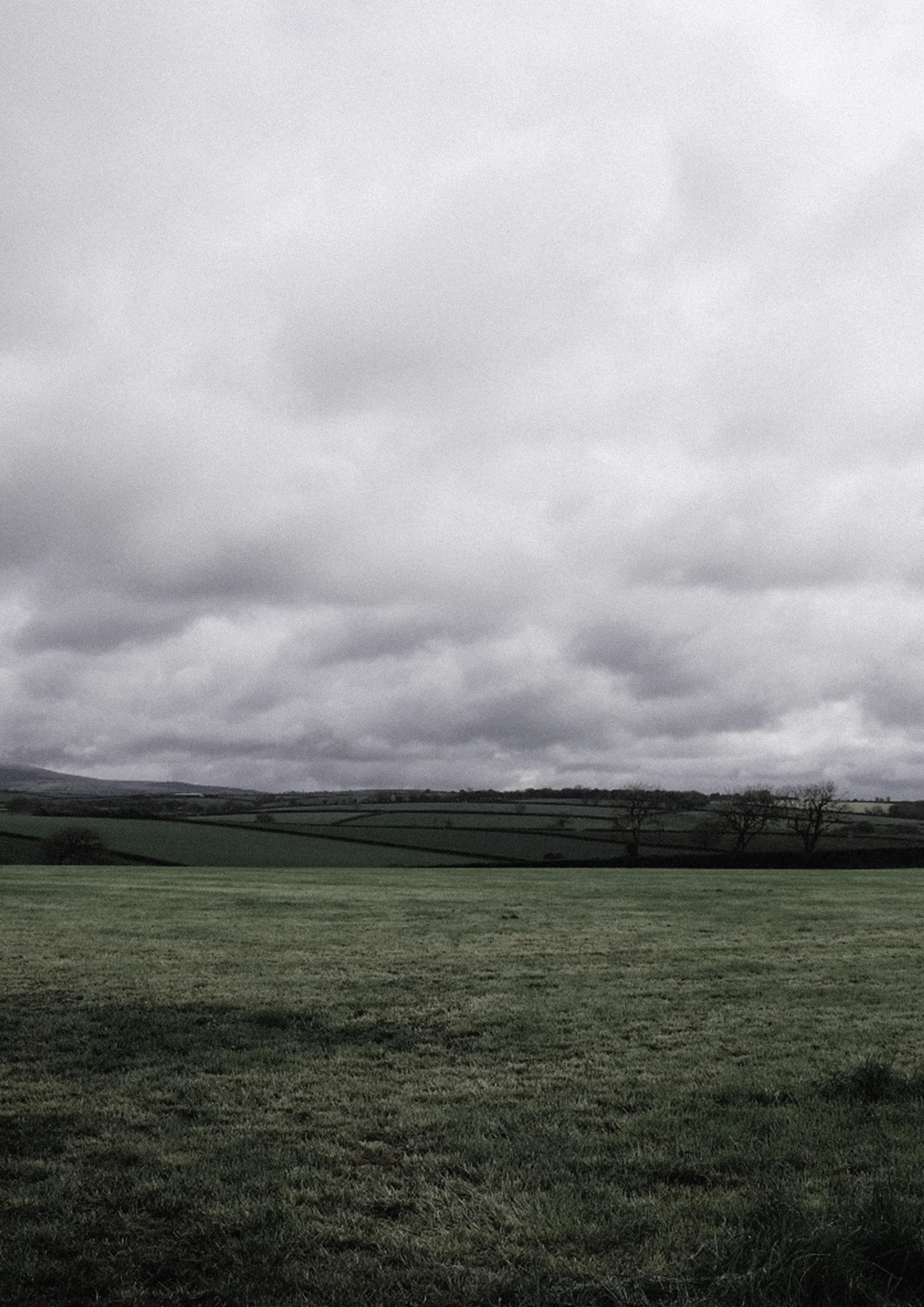
Yihan
Lei Chen(msc)
Hu(msc) Yang(msc) Gu(msc)
1.2 Development
1.3 Reference
4.2.1 Pembrokeshire
4.2.2 Ashford
4.2.3 Kent
4.3.1 Other food parks
4.3.2 Organisations


2.1 Changes in the potato diet
2.1.1 Potato history
2.1.2 Potato dishes of different periods
2.1.3 Modern diet
2.2 Impact and reasons
2.2.1 Changes in potato cultivation
2.2.2 Attitudes of potato eaters
2.2.3 Potatoes and politics
2.3 Reference
CRISIS CAUSED BY MODERN FOOD SYSTEM
3.1 Modern food system
3.1.1 Operation
3.1.2 Chanllenges of planting
3.1.3 Chanllenges of processing
3.1.4 Chanllenges of retailing
3.1.5 Comparision
3.2 Controllers
3.2.1 Industry monopolies
3.2.2 Global dispersion
3.2.3 Bad deeds
3.3 What modern food system brings
3.3.1 Food waste
3.3.2 Damage on environment
3.3.3 Species monoculture
3.3.4 Delimmas of small potato farmers
3.3 Reference
02 03 04
OPPORTUNITIES FOR CHANGE
4.1 Inspiration for the project
4.1.1 Special potatoes
4.1.2 Pembrokeshire
4.1.3 The food park
6.2.1 Strucutre
6.2.2 Function
6.3.1 Strucutre
6.3.2 Function
6.5.1 Generation
6.5.2 Companion plants
6.5.3 Seasonal changes
2 3 [CONTENTS] FOOD SOVEREIGNTY HISTORY AND CHANGES OF THE POTATO DIET IN UK 01
05 06 07
SITE PLANNING AND ANALYSIS DESIGN AND STRATEGIES FUTURE VISIONS
Definition 6 14-19 20-25 26 30-38 39-42 43-47 48-49 52-57 58-59 60-61 63 66 67 68-69 70-71 72 76 77 78-79 80-81 82-85 86-89 90 94 95 96-97 98-99 100 102-105 7-9 11
1.1
5.1 Initial idea of food park 6.1 Manual and policy on facilities 7.1 A new complementary food
7.2 Regional influences
Promotion 7.4 The future vision 7.5 Reference 7.6 Appendix 5.2 Site analysis 6.2 Processing workshop 6.3 Laboratory 6.4 Field kitchen 6.5 Fields 6.6 Overview sections 5.3 Construction process and supporting policies 5.4 Plan of food park 4.2 Field trips 4.3 Additional references
system
7.3
4.3 Reference 5.5 Reference 6.7 Reference
"Food sovereignty is the right of peoples to healthy and culturally appropriate food produced through ecologically sound and sustainable methods, and their right to define their own food and agriculture systems. It puts the aspirations and needs of those who produce, distribute and consume food at the heart of food systems and policies rather than the demands of markets and corporations."1
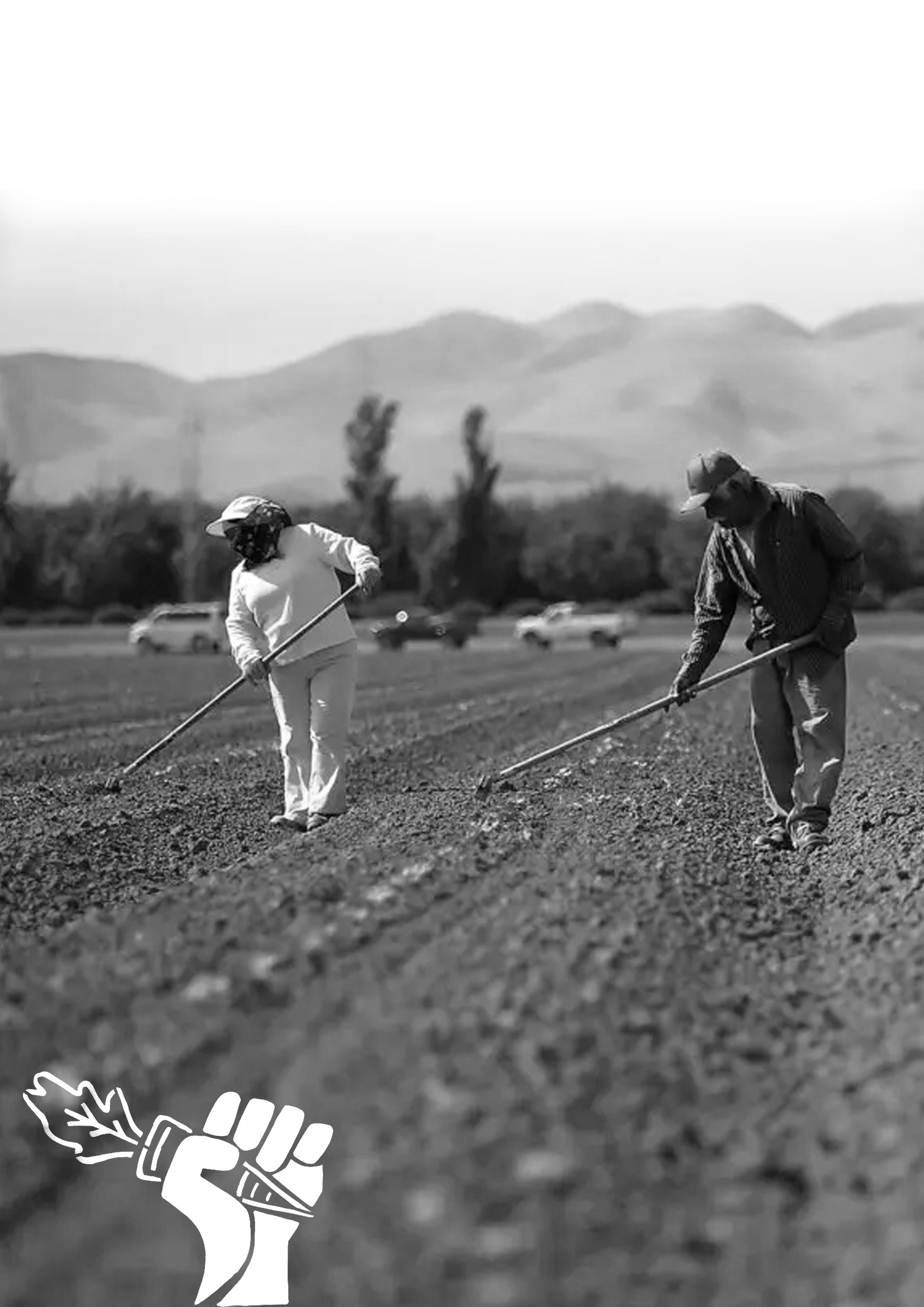
FOOD SOVEREIGNTY 01
OBJECTIVES
Food sovereignty is not a widely known concept, so in the initial stages we aim to look at the definition of food sovereignty and we need to know what rights naturally belong to all.
CONCLUSIONS
We learn that food sovereignty is the right of producers and consumers to grow and consume freely. Many farmers' organisations have arisen around the world to protect food sovereignty.
5
[1.1 Definition] [1.2 Development]
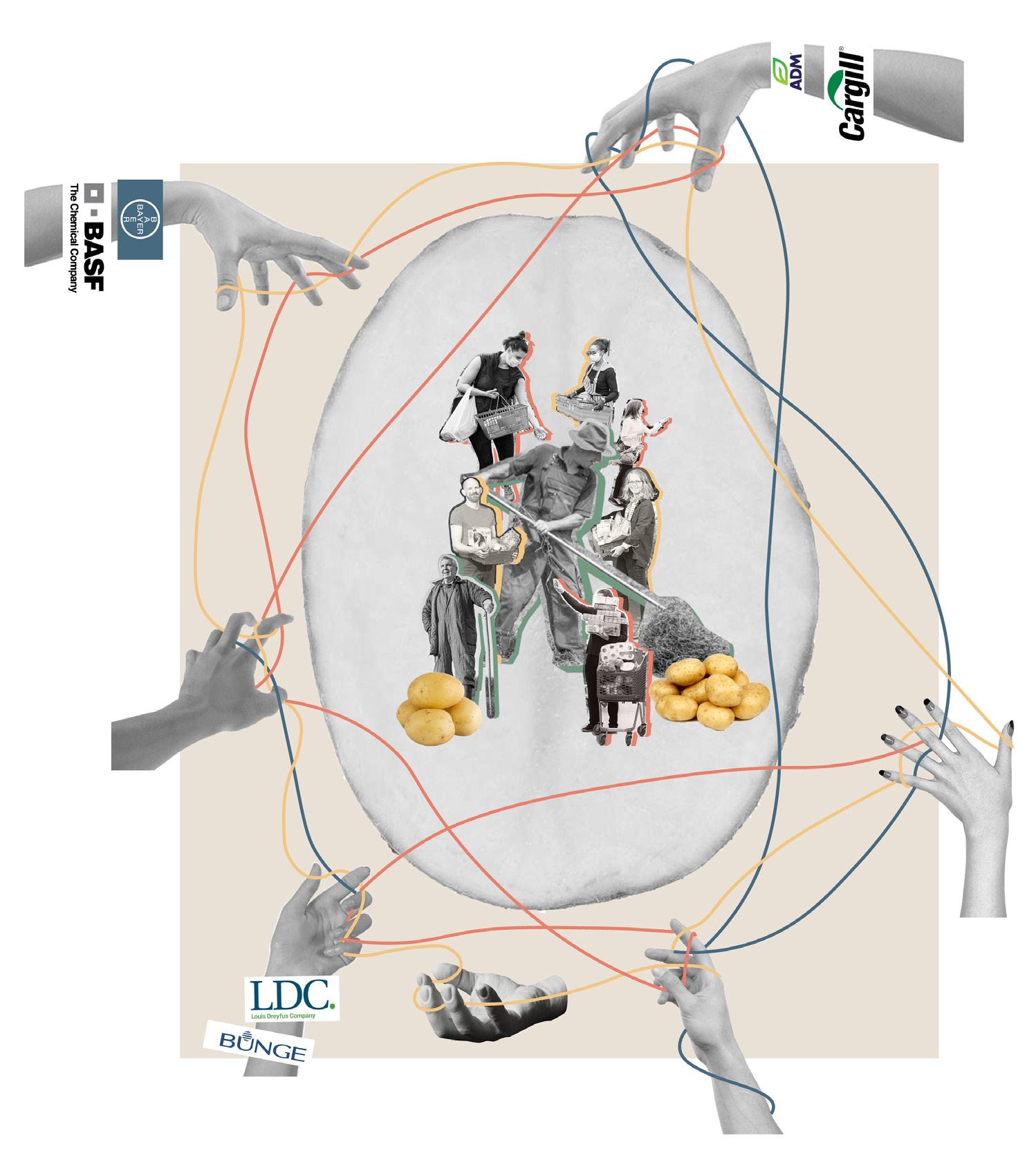
Food sovereignty means equitable access to food, and it emphasises putting producers, distributors, and consumers at the heart of the food system, rather than markets and corporations2

The idea of protecting food sovereignty first emerged in Belgium, and in 1993, 182 organisations from 81 countries formed the first international farmers' organisation, La Vía Campesina, to defend food sovereignty.3
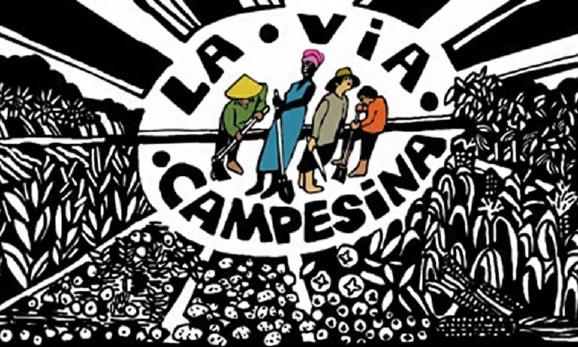
At the 2007 Forum on Food Sovereignty in Seringey, Mali, 500 delegates from more than 80 countries adopted the "Declaration of Nyéléni".4
In September 2008, Ecuador became the first country to incorporate food sovereignty into its constitution, followed by Venezuela, Mali, Bolivia, Nepal, Senegal, and Egypt"4

6 7
FIG1-1 food sovereignty crisis by Meike Lei
FIG1-3 food sovereignty movement
FIG1-2 food sovereignty movement by Meike Lei
FIG1-4 food sovereignty movement
The first campaign for food sovereignty in the UK was launched in 2012. This was followed in 2014 and 2015 by two more gatherings of protesters in the UK to rally farmers to help each other and express resistance.
The longest-running food sovereignty organisation in the UK is WARONWANT, founded in 1951. 2008 onwards saw the emergence of many organisations that help farmers, workers, and communities. London and Scotland are important strongholds.1

8 [1.2 Development]
FIG1-5 food sovereignty movement in UK by Meike Lei
1. “What Is Food Sovereignty? | Food Sovereignty Now!” n.d. Foodsovereigntynow.org.uk. https://foodsovereigntynow.org.uk/ foodsov/.
2. “Via Campesina.” Wikipedia, 17 Mar. 2022, en.wikipedia.org/wiki/ Via_Campesina#cite_note-Members-1. Accessed 19 Apr. 2022.
3. Maitreuweb. “DECLARATION of NYÉLÉNI - Nyeleni - via Campesina - Newsletter, Bulletin, Boletin.” Nyeleni.org, nyeleni.org/spip. php?article290.
4. Wikipedia Contributors. “Food Sovereignty.” Wikipedia, Wikimedia Foundation, 1 Feb. 2019, en.wikipedia.org/wiki/Food_sovereignty.
Fig1-2 “Food Sovereignty.” Wikipedia, Wikimedia Foundation, 1 Feb. 2019, en.wikipedia.org/wiki/Food_sovereignty.
Fig1-5 "Food Sovereignty Now!" Foodsovereigntynow.org.uk, foodsovereigntynow.org.uk/. Accessed 21 Apr. 2022.
Heath, Yali Banton. "Why We Need a UK Food Sovereignty Movement." Landworkers Alliance, 16 June 2021, landworkersalliance.org.uk/why-we-need-a-uk-foodsoveriegntymovement/. Accessed 21 Apr. 2022.
"A New Movement Is Born: Food Sovereignty in the UK." Global Justice Now, 12 July 2012, www.globaljustice.org.uk/news/ a-new-movement-is-born-food-sovereignty-in-the-uk/. Accessed 21 Apr. 2022.
10 11
[1.3 References]
HISTORY AND CHANGES OF THE POTATO DIET IN UK 02
OBJECTIVES
To research the history of the spread and consumption of potatoes in Britain. I hope to understand how the potato dish has differed over time and how the food embodies different aspects of life and social culture. It is hoped that this will ultimately reveal how the situation of food sovereignty has changed.
CONCLUSIONS
Through my research into the history of potato diet, I have found that food sovereignty should not be isolated; it is linked to the farm and the table, influencing the landscape and the culture of society. And that eating habits can easily be changed by powerful forces, suggesting that food can become a tool.
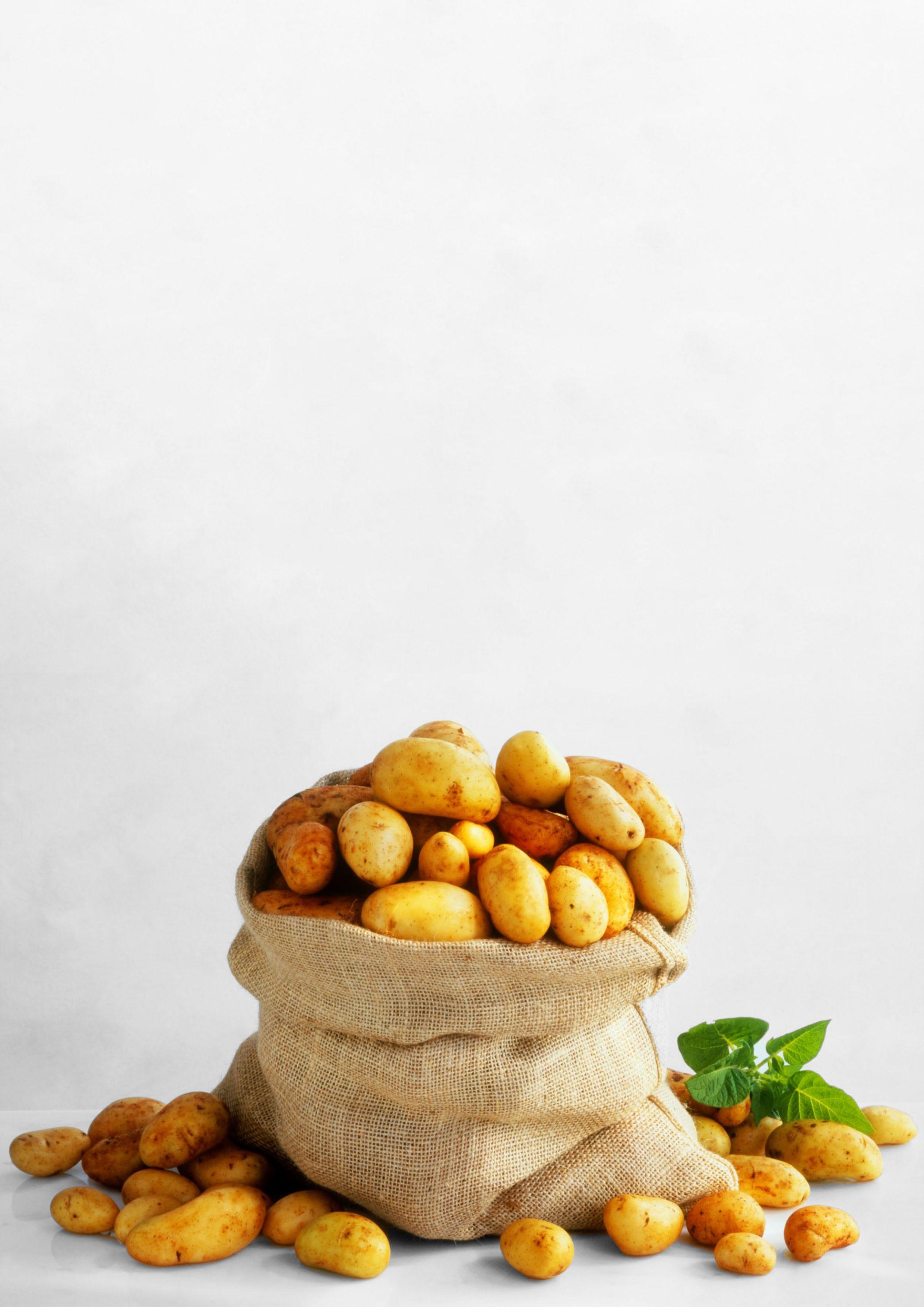
13
[2.1 Changes in the potato diet]
2.1.1 Potato history
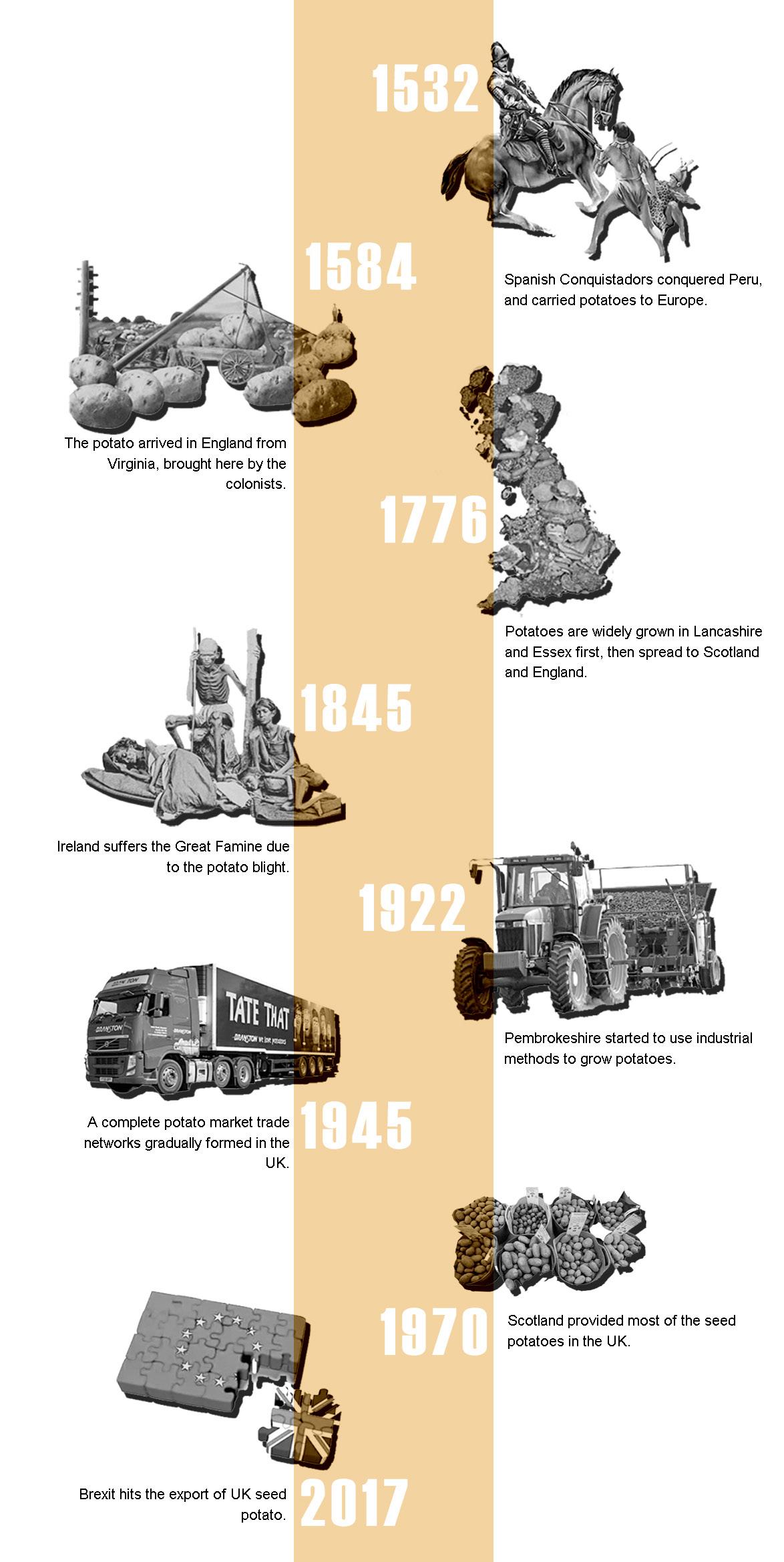
The potato has been on the British mainland for 430 years, since 1584, when colonists brought it to England. The potato originated in Peru and was introduced to England from Virginia. The first potatoes were grown in Lancashire and Essex, but gradually they spread throughout the country, and in 1945 a complete potato market was formed.
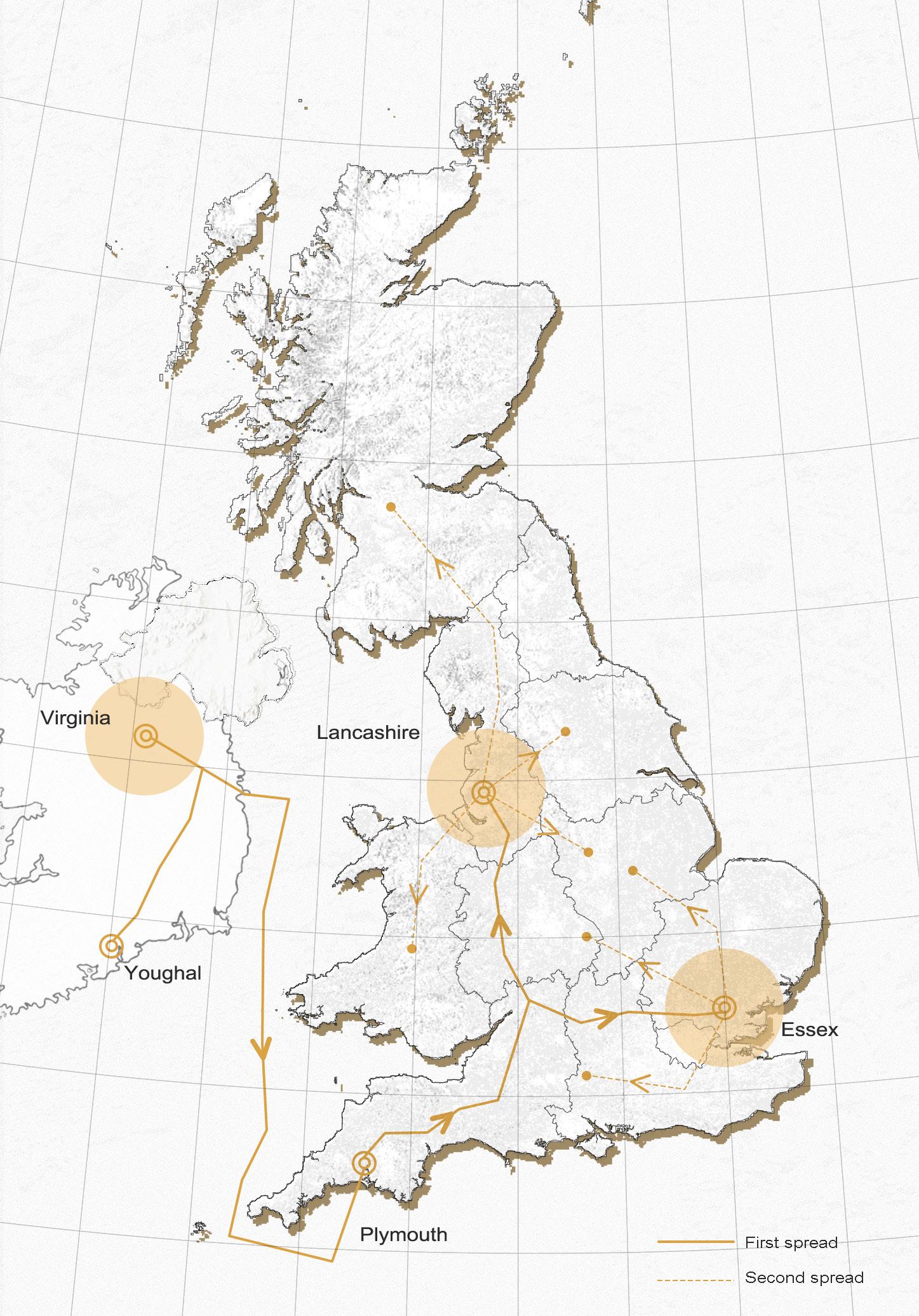
15
FIG2-1 potato history by Meike Lei, Jiamin Hu
2.1.2 Potato dishes of different periods
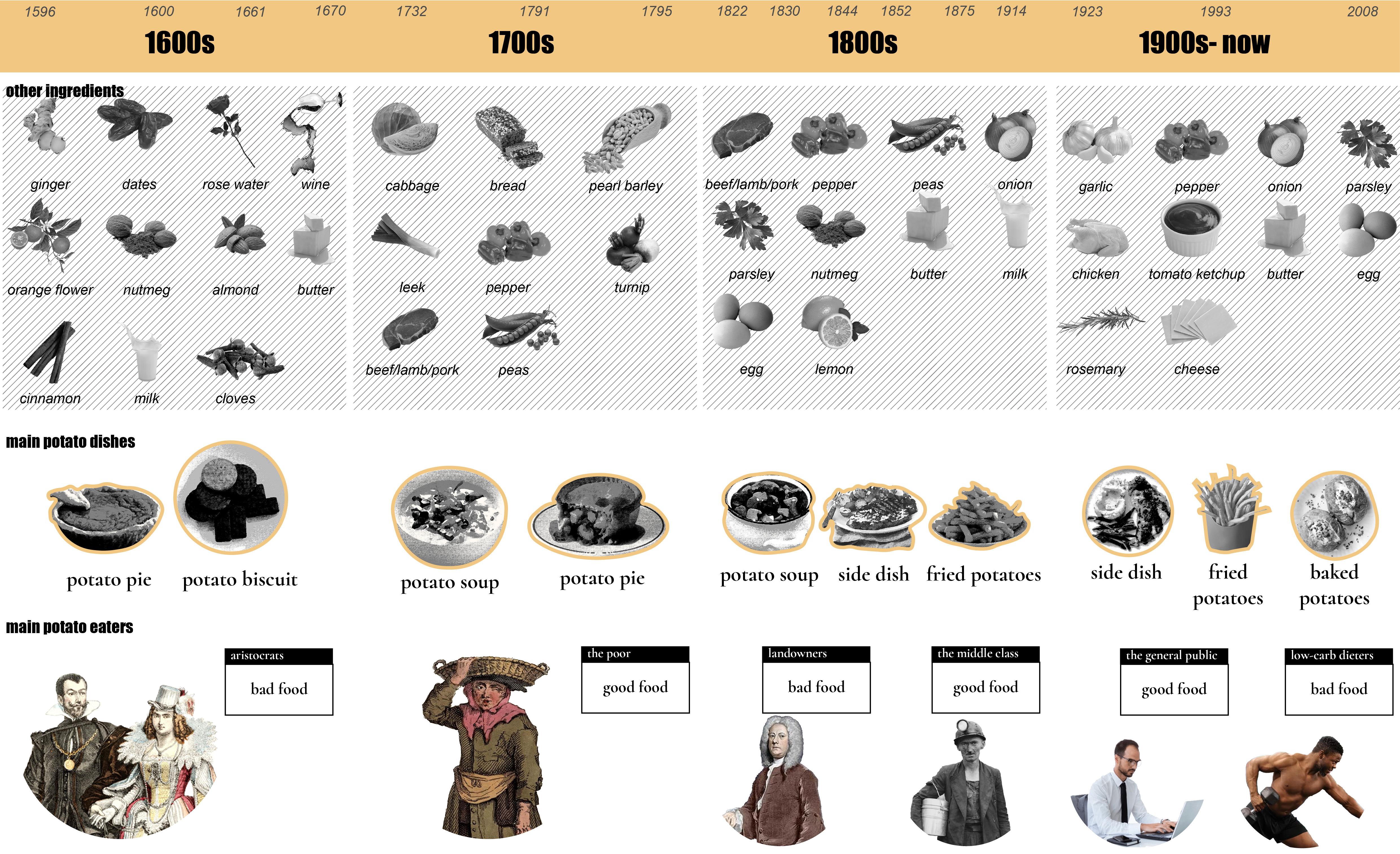
when I look into this history, I find that the potato has undergone several radical changes in the British diet. They were cooked with different ingredients, made into different dishes, and then eaten by different people. Each period has its own characteristics.
In the first period, spices were an important ingredient in potato dishes, as the nobility were the main potato eaters of this period, and for them the potato was a valuable alternative to the turnip.
In the second phase, soup was the predominant potato dish, as large numbers of poor people began to consume potatoes, and they were more concerned with the satiety potatoes provided.
In the third period, the potato was promoted and as a result many new potato dishes were created to serve the middle class. The poor and the rich had different attitudes towards potatoes.
The development of the food processing industry at the beginning of the 20th century once again changed the type of potato dish.
16 17
FIG2-2 potato dishes of different periods by Meike Lei
2.1.3 Modern diets
Eighty years ago, the shopping cart of an average British family would have been filled with fresh and nutritious foods such as white bread, animal offal and ham salad. Now, shopping carts are dominated by chips, pizza and other fast food items. Modern eating habits have changed dramatically.

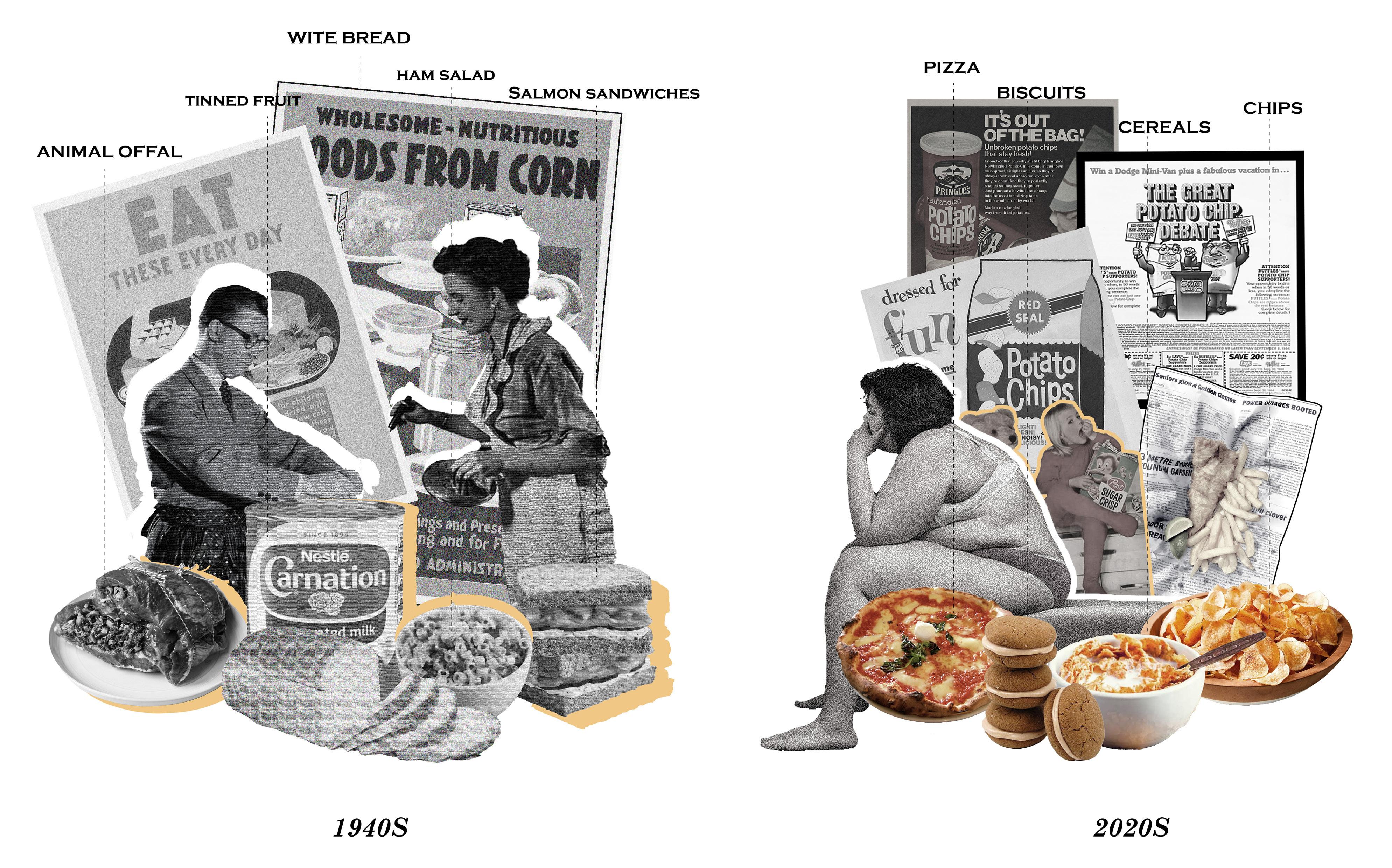
Potatoes are still the most popular vegetable in the UK. However, it should not be overlooked that sales of fresh potatoes have been declining, in contrast to the steady increase in sales of processed potatoes, which have been outstripping those of fresh potatoes.
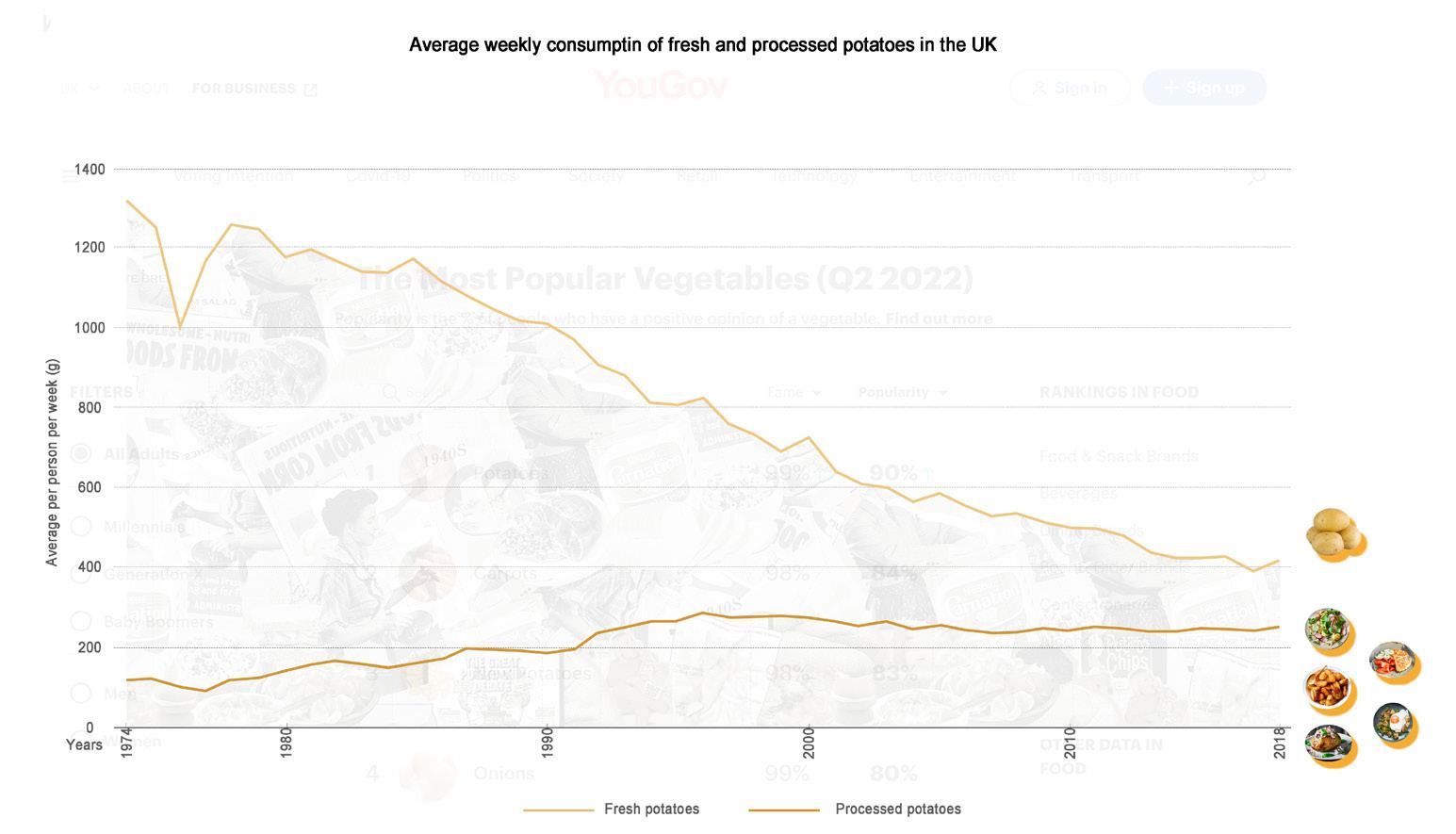
19
FIG2-3 dietary change by Meike Lei, Chenxu Chen
FIG2-4 popular vegetables in UK source: https://yougov.co.uk/ratings/food/popularity/vegetables/all
FIG2-5 consumption of fresh and processed potatoes in UK by Jiamin Hu
[2.2 Impact and reasons]
2.2.1 Changes in potato cultivation
The way potatoes were cultivated changed along with the diet. Initially, small quantities of potatoes were grown in the gardens of the aristocracy for family consumption only. After the second period, as the poor also began to eat potatoes, they were transplanted to open fields.

The third period coincided with the onset of the Industrial Revolution, when small amounts of machinery and fertiliser were used in potato farming. Finally, industrial farming became widespread, large amounts of machine pesticides were necessary and farmland was dominated by a single crop.
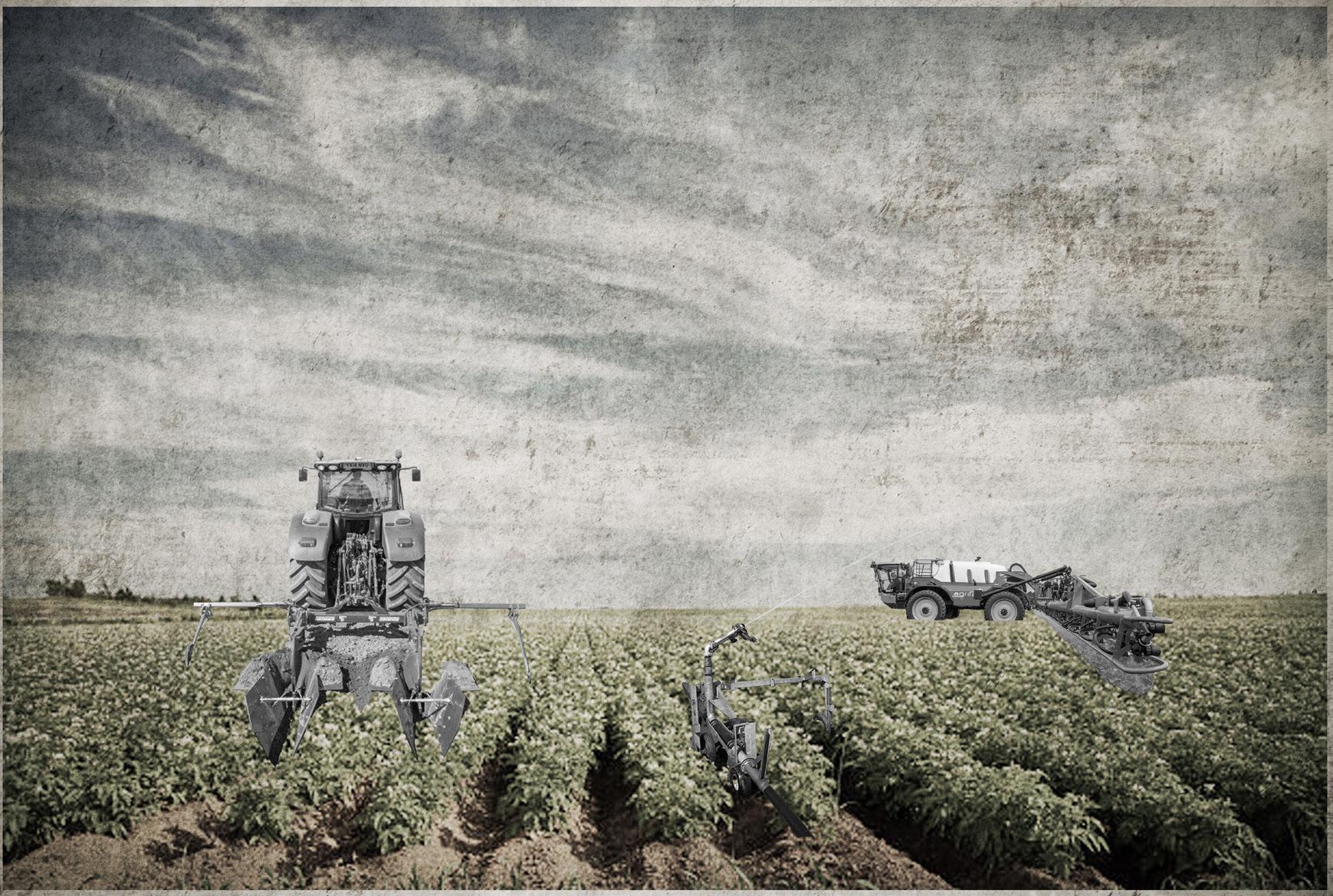
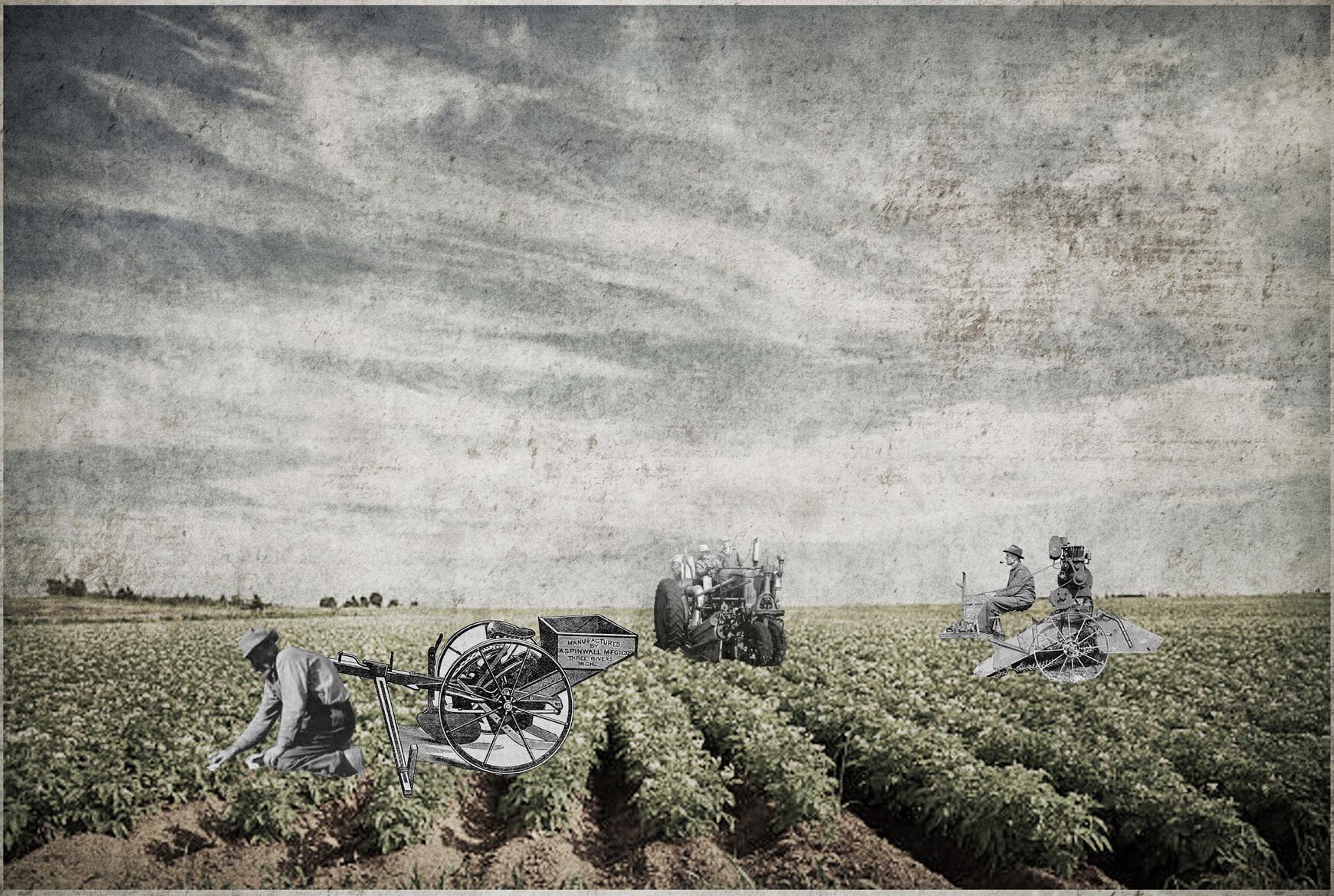

20 21
FIG2-9 potato cultivation in 2000s by Meike Lei
FIG2-6 potato cultivation in 1600s by Meike Lei
FIG2-7 potato cultivation in 1700s by Meike Lei
FIG2-8 potato cultivation in 1800s by Meike Lei
2.2.2 Attitudes of potato eaters
The attitude of potato eaters towards potatoes has also been changing.
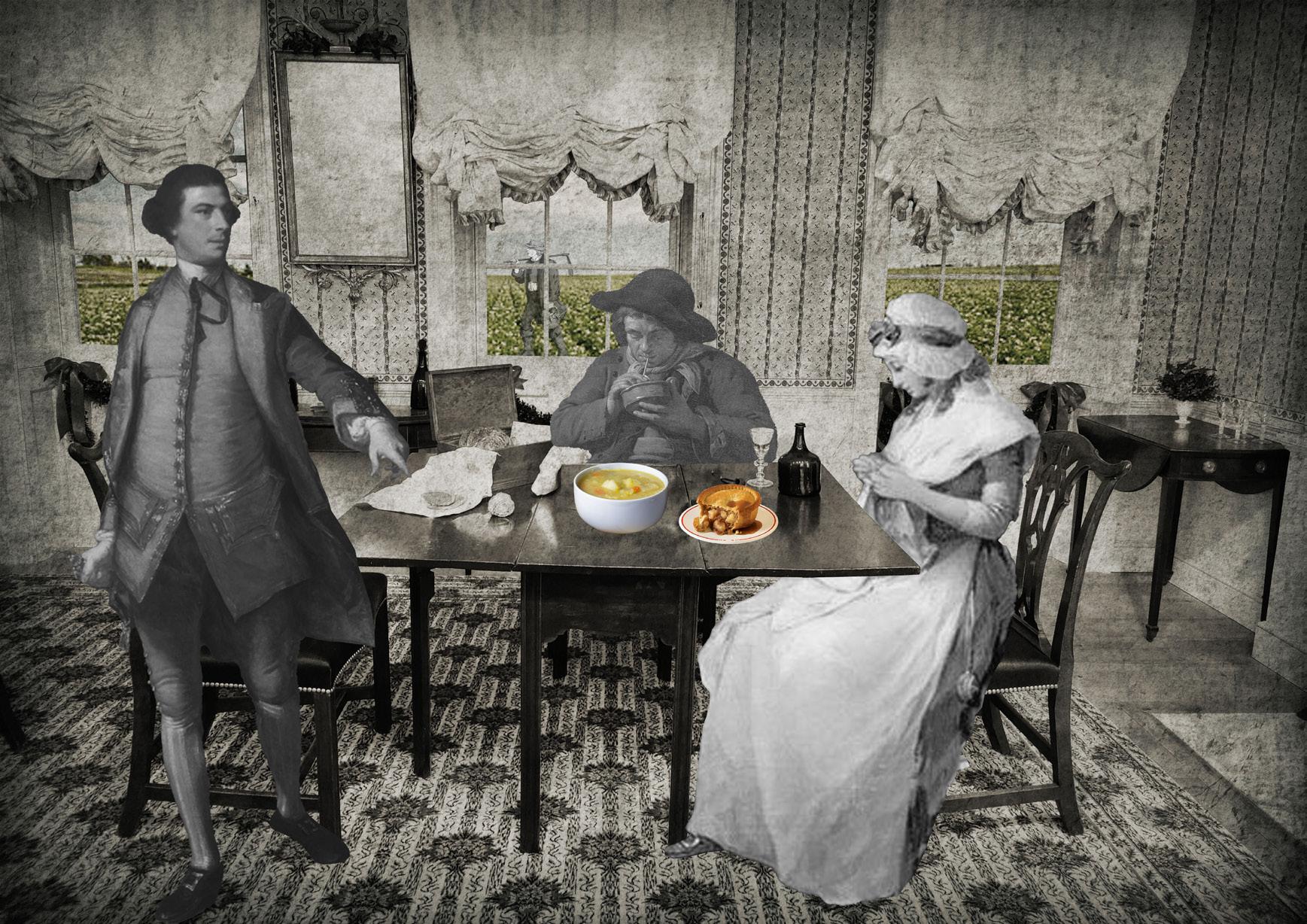
Initially, although potatoes were a valuable substitute for turnips, the nobility did not love them and potatoes would not be cooked in an easily recognisable way.
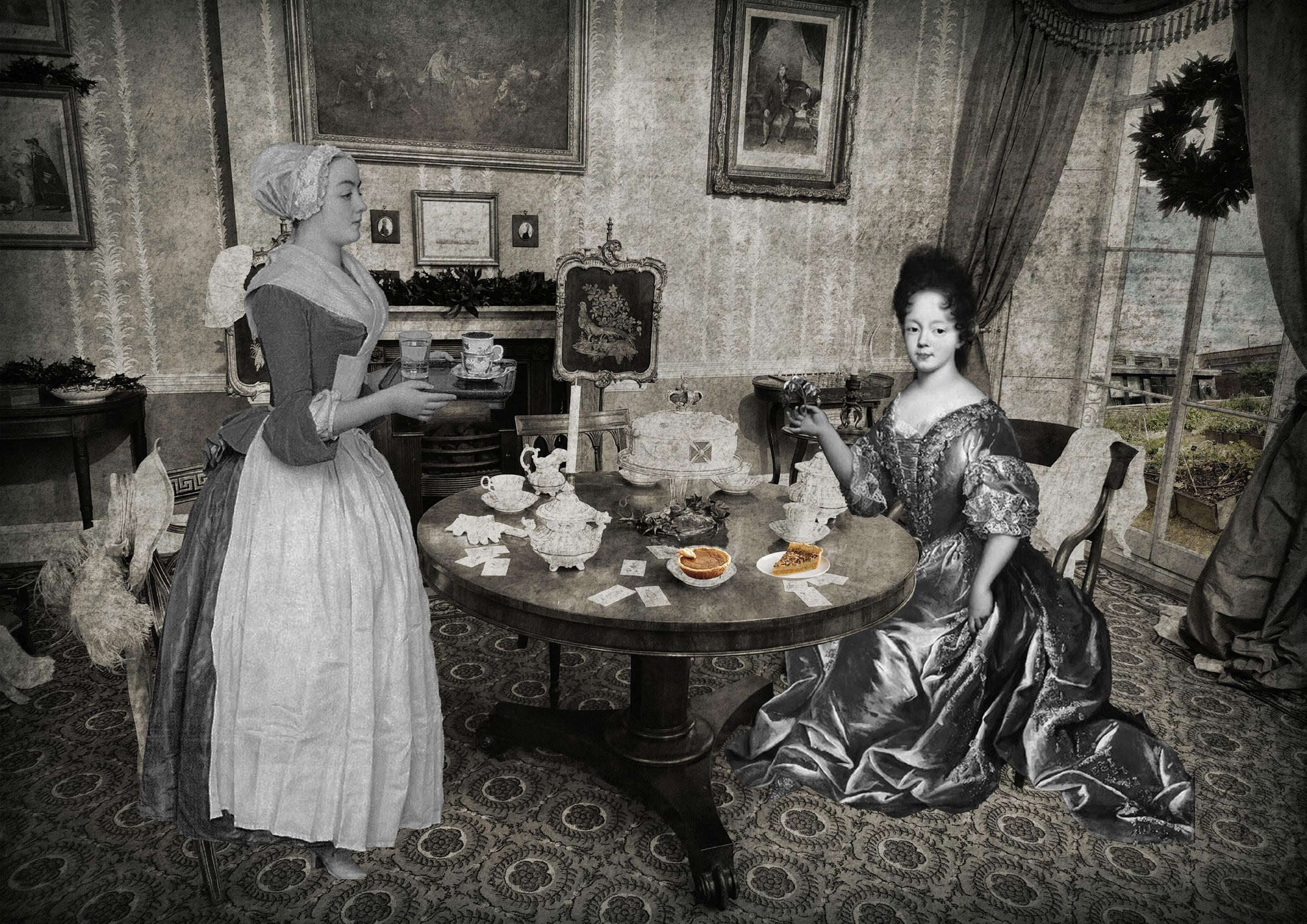
Potatoes to me were associated with backwardness and uneconomic practices 2

What a treasure is a milch cow and a potato garden, to a poor man with a large family!3
Beat the potatoes so finely as not to be discovered what they are.1
Potatoes were considered to be the food that brings happiness and were praised a lot. But the rich, and especially the landowners, hated potatoes, which they believed made the labourers so self-sufficient that they had no incentive to work, and took nutrients from the soil.
Potatoes were still popular with workers as they work 12 hours a day and potato became the best food to provide energy. But the negative attitude of the landowners towards the potato intensified in the mid-19th century. politicians criticised potato eaters with "lazy potato blood".
22 23
LAZY POTATO BLOOD!4
FIG2-10 table and attitude in 1600s by Meike Lei
FIG2-11 table and attitude in 1700s by Meike Lei
FIG2-12 table and attitude in 1800s by Meike Lei
2.2.3 Potatoes and politics
Potatoes were seen as the fruit of the devil in the early days of European consumption, with the first turnaround occurring during the Enlightenment in the 17th century.
"Everyday eating practices acquired a new political importance during the Enlightenment because statesmen and scientists, philosophers and philanthropists, became ever more convinced that there was a correlation between diet and national prowess."5

Potatoes were naturally valued by politicians as a crop that combined ease of cultivation, high yield and high calorie content.
As a result, the potato became the focus of international planning in the 18th century, with various European countries taking measures against the potato to promote its cultivation and consumption.

For example, the rulers of Stockholm and Spain both issued decrees encouraging the cultivation of potatoes; the Finnish Economic Society distributed potato seed potatoes free of charge; and economic societies in St Petersburg, Wales and Scotland held great potato harvest competitions.6
The promotion of politicians is the reason why many potato recipes for the poor arose in this period. Immediately afterwards, the massive population fed on potatoes sparked the industrial revolution.
Because of the promotion of the potato by politicians the potato was cultivated on a large scale and, together with the industrial revolution, the middle class, especially the workers, became the main potato eaters. In turn, the industrial revolution changed the way potatoes were cultivated.
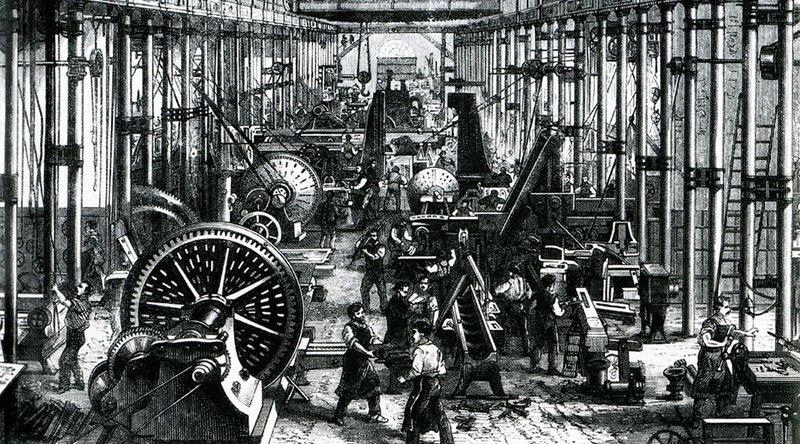
According to statistics from 1974 to 2013, the purchase of processed potatoes showed an upward trend, while fresh potatoes, on the contrary, declined significantly.7
They use newspapers, television, and celebrity influence to promote the deliciousness of their products. There are fish and chip shops everywhere in the UK, no matter what type of restaurant they will serve chips.
These ubiquitous promotions have changed our eating habits, making people more inclined to consume fast and convenient foods, and as a result, many physical problems such as obesity have occurred, affecting our health.
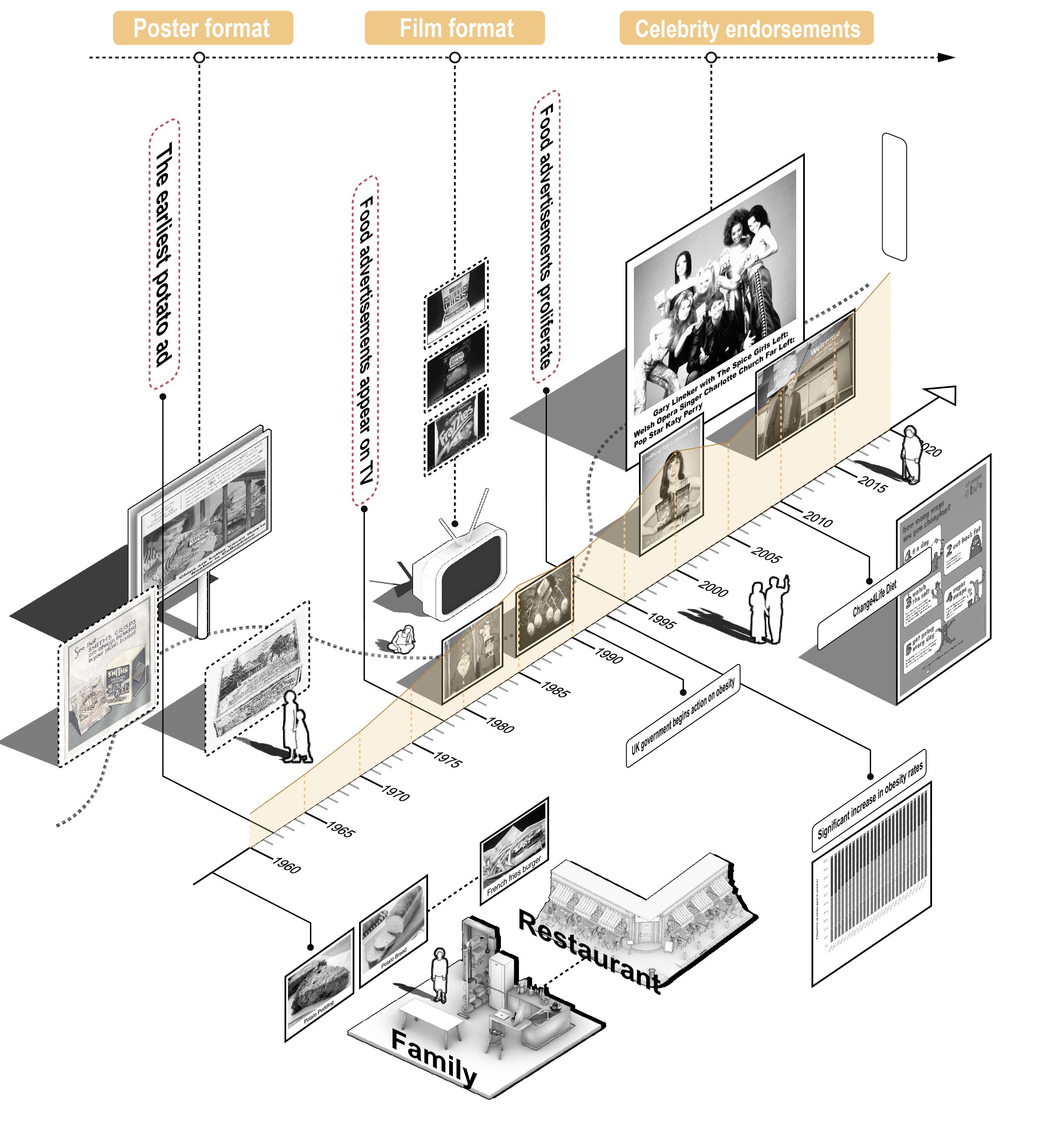
24 25
FIG2-13 the Enlightenment source: wiki pedia
FIG2-15 the Industrial Revolution source: https://baristaguild.coffee/
FIG2-14 historical european map by Meike Lei
FIG2-16 the impact of film and ads by Chenxu Chen
1. Robert Smith (cook. 1725. Court Cookery: Or, the Compleat English Cook.
2, 4, 5, 6. Earle, Rebecca. 2020. “Feeding the People,” June. https://doi. org/10.1017/9781108688451.
3. William Buchan, 1797.
7. “What Is Food Sovereignty? | Food Sovereignty Now!” n.d. Foodsovereigntynow.org.uk. https://foodsovereigntynow.org.uk/ foodsov/.
FIG2-1 Digimap, http://digimap.edina.ac.uk/.
Wikipedia Contributors. 2019. “History of the Potato.” Wikipedia. Wikimedia Foundation. April 4, 2019. https:// en.wikipedia.org/wiki/History_of_the_potato.
FIG2-2 Byron, May. 1914. Pot-Luck.
Dawson, Thomas, and Maggie Black. 1596. The Good Housewife’s Jewel. Lewes, East Sussex: Southover Press. May, Robert, and W W. 1600. [the Accomplisht Cook ... ]. London.
More, Hannah. 1795. The Cottage Cook; Or, Mrs. Jones’s Cheap Dishes, Etc. [Signed: Z., I.e. Hannah More.].
Wooley, Hannah. 1670. The Queen-like Closet; Or, Rich Cabinet; Stored with All Manner of Rare Receipts for Preserving, Candying, and Cookery.
FIG2-5 Department of Environment Food and Rural Affairs (2020). (DEFRA) Family Food Datasets. GOV.UK.
FIG2-6, 10, 11 The museum of the home, London.
26 27 [2.3
Reference]
CRISIS CAUSED BY MODERN FOOD SYSTEM 03
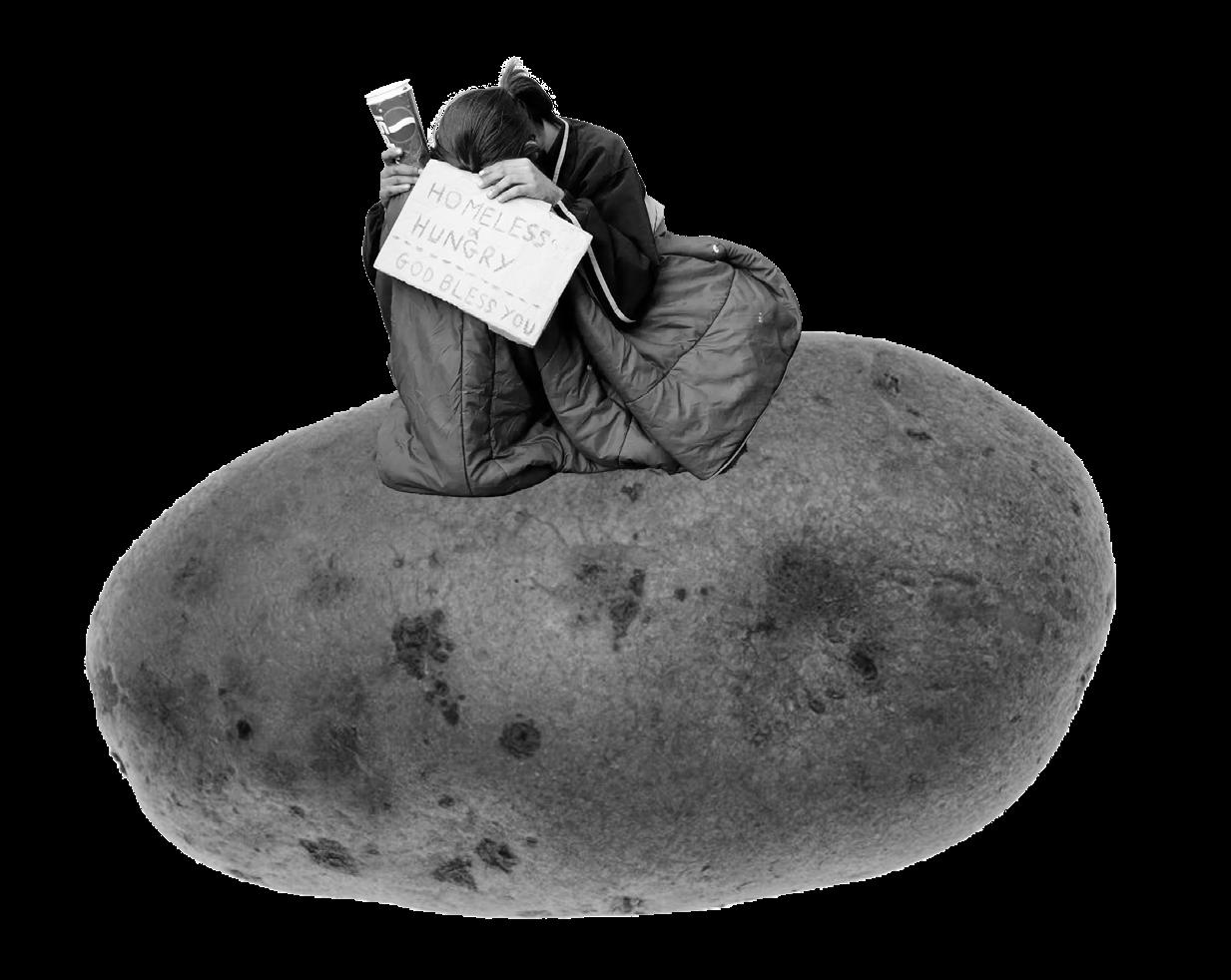
OBJECTIVES
After learning about the importance of food and modern eating habits, I wanted to know how the modern food system works, who directs it and what potential risks exist in such a food system.
CONCLUSIONS
I got surprising results; the food system now has efficiency and economy as its main goal, with high yields but also a lot of waste. Large food companies are the winners of this model, which takes away from small farmers and harms consumers.
28 29
[3.1 Morden food system]
3.1.1 Operation
This is a simplified diagram of how the modern food system works.
The producer and the consumer are separated by multiple segments and companies, from the seed to the final shop where the finished product is sold. The producer has to rely on the goods provided by the giant companies at every step of the way. In this way the giant companies take deep control of the food system and capture a large amount of profit, which they receive far more than the producers.
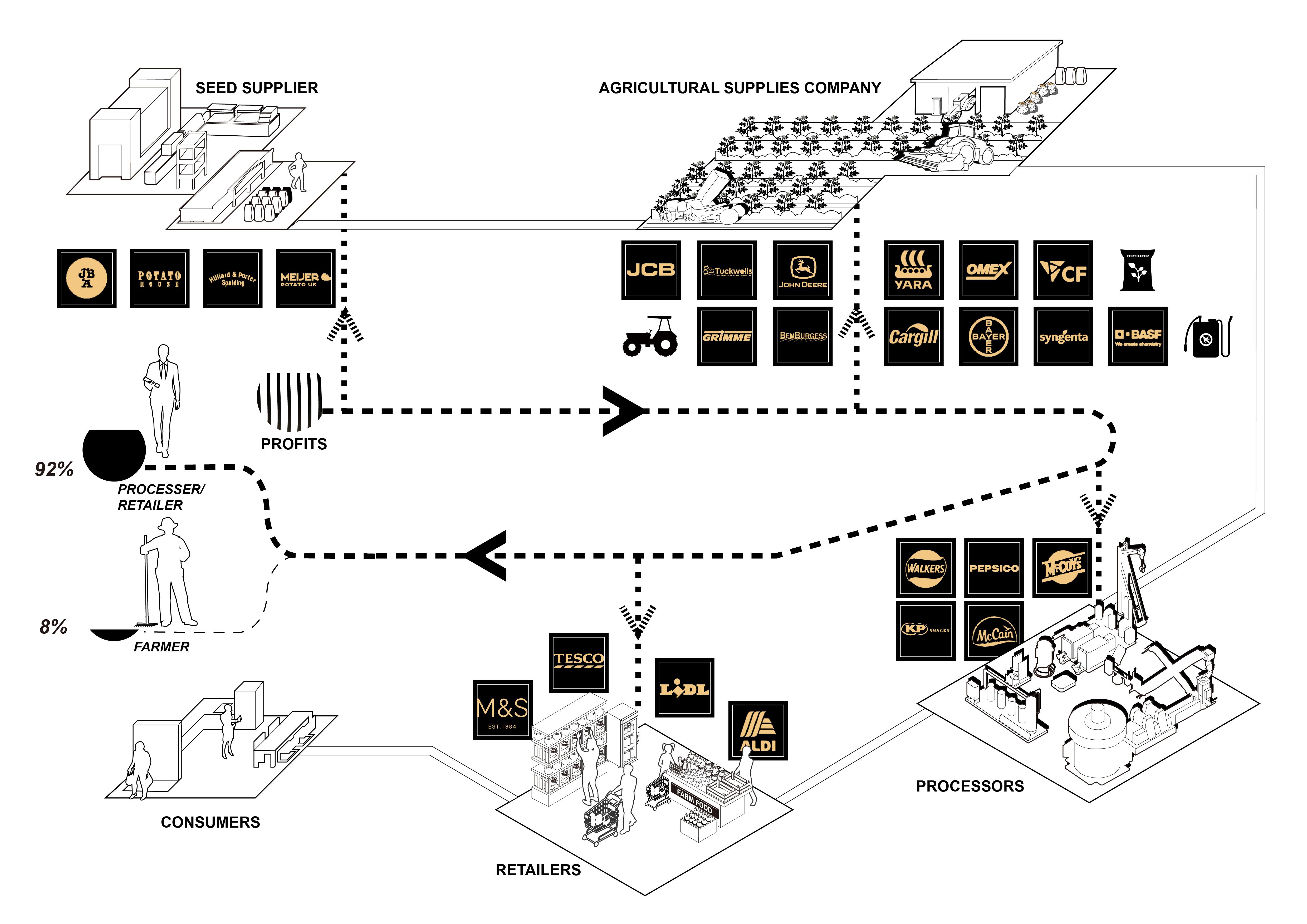
30 31
FIG3-1 how the modern food system works by Meike Lei, Jiamin Hu
The potato is a crop that is found throughout the UK and its production chain also involves several sectors. The UK produces 5M tonnes potatoes each year and 13,000 people work in the industry.1 The dilemma of producing potatoes is hidden in the complexity of the process.

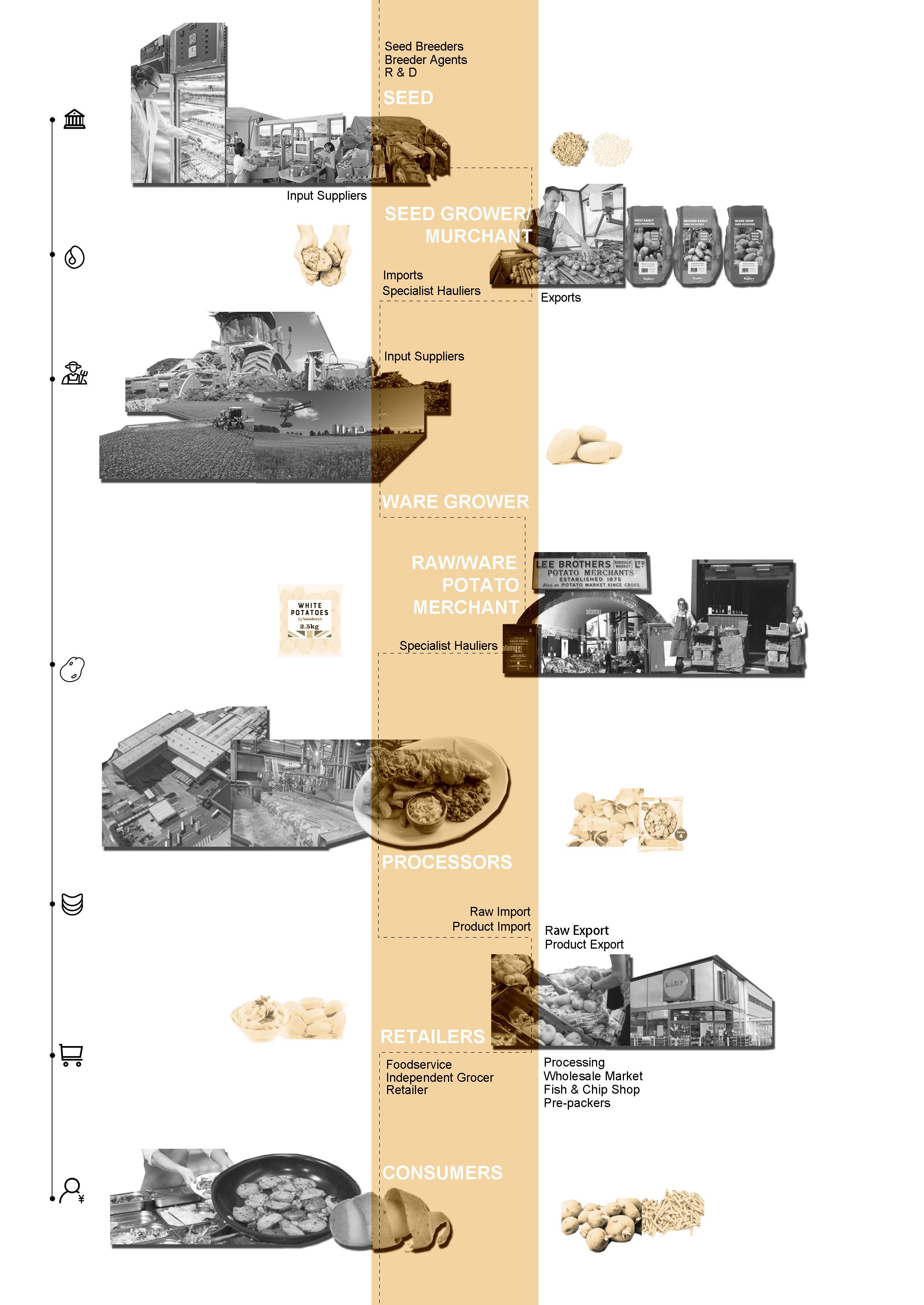 FIG3-2 potato supply chain by Meike Lei, Jiamin Hu, Yihan Gu
FIG3-2 potato supply chain by Meike Lei, Jiamin Hu, Yihan Gu
3.1.2 Chanllenges of planting

From the very beginning of the production chain, starting from seeds, farmers have fallen into the trap of monopoly.
Almost all potato seeds in the UK come from Scotland, and farmers pay double the price for certain varieties of potatoes due to patents.2
For a large farm, a lot of machinery and fertiliser is a must. Preparing for the planting stage requires plowing and turning the soil, using a stone separator to separate the stones from the soil.3 When planting, seed potatoes into the soil with a seeder. A large amount of nitrogen fertilizer, which is important for potatoes, is applied before planting.

Potatoes are collected with a harvester and graded by machine or by hand to ensure their quality, and small or damaged potatoes are removed along with the loose soil. The harvested potatoes are stored in special warehouses, and the temperature, airflow, and air quality are strictly controlled.

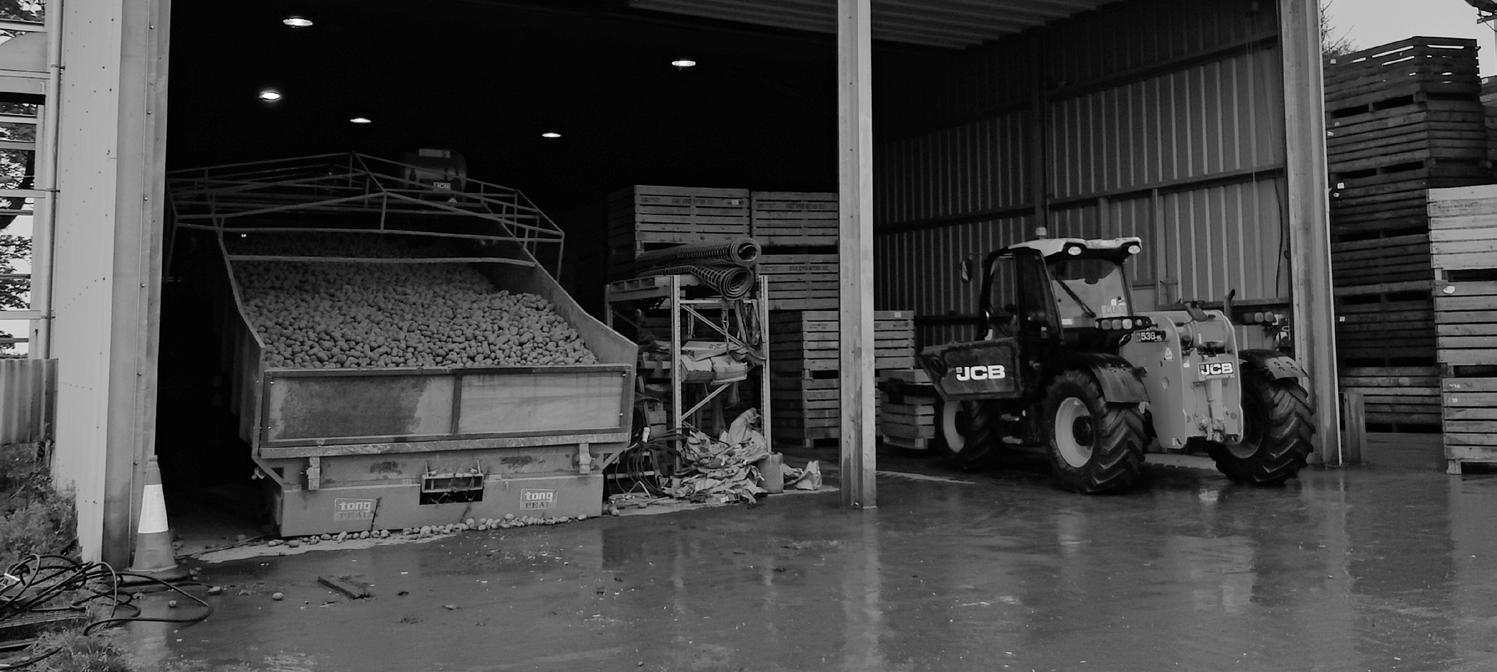
34 35
FIG3-3 planting potatoes by Jiamin Hu
FIG3-4 photos by Team
3.1.3
The production and sale of processed food almost monopolizes the market and affects all aspects of the potato supply chain.Potatoes wasted during processing accounted for 46% of production, apart from those that did not meet the standard, a large part was potato skins.4 The processor owner doesn't care where the wasted potato skins go, and we as consumers will only be bemoaned by the wasted fried potatoes on the plate when we eat these chips.
Farmers on the farm believe that consumers do not know how to appreciate food and do not appreciate the waste caused by food,5 but the truth is that processors are profit-oriented production methods. Consumers have become scapegoats, and what is wasted is not only food, but also the time cost and money cost of farmers' labor, and the opportunity for those in difficulty to obtain healthy food.
Supermarkets are the dominant players in the fresh potato market.Farmers who cannot afford to take production risks have to sign contracts in advance with supermarkets6, which often require farmers to overproduce and screen their potatoes to exacting standards in order to ensure competitiveness.The farmers cannot turn to other markets or refuse unreasonable orders and have to suffer losses.
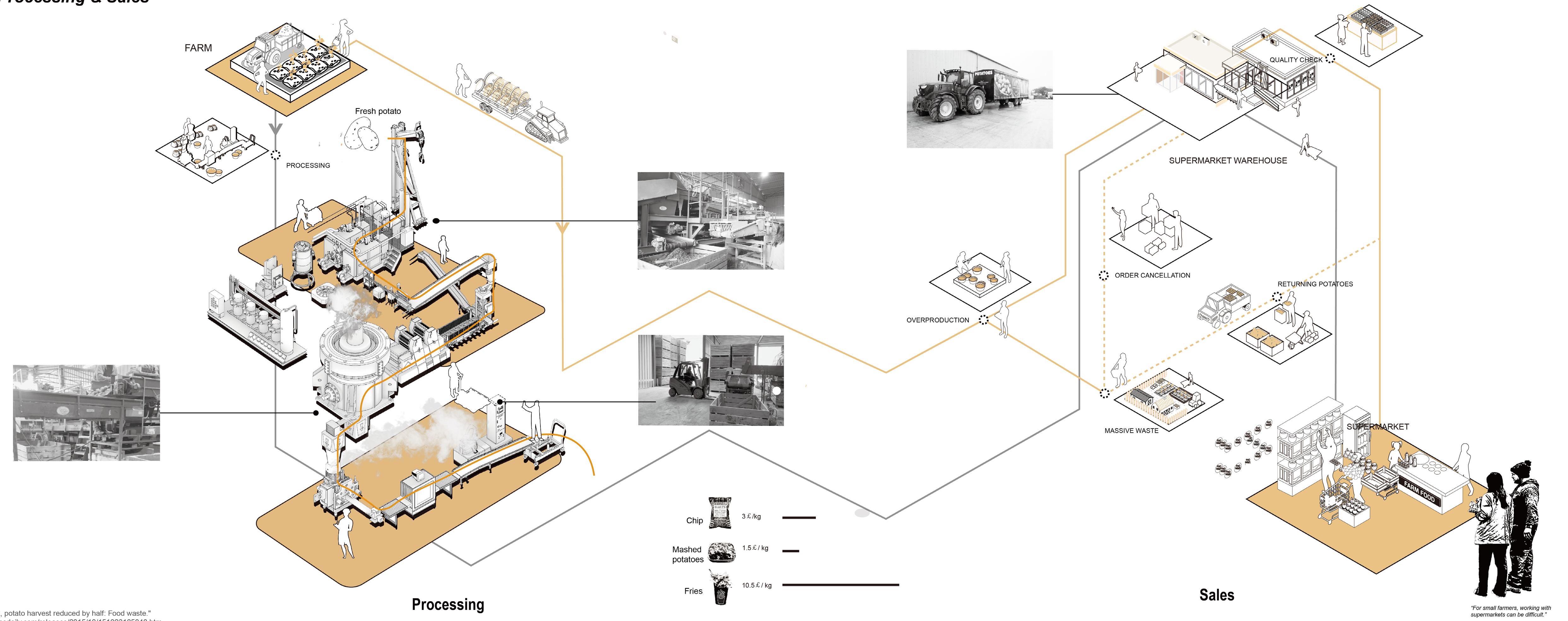
36 37
Chanllenges of processing
FIG3-5 processing and selling potatoes by Meike Lei, Jiamin Hu, Chenxu Chen, Jingru Yang
3.1.4 Chanllenges of retailing
There is no doubt that different farming methods go hand in hand with different food systems and idyllic landscapes.
In the past we used traditional farming methods, so we had diverse farm landscapes and free food chains, and consumers could buy an abundance of produce at the market or on the farm.

Nowadays, industrial food systems deliver food to every corner of the world, consumers can buy food in supermarkets in the city and the farming landscape becomes highly uniform.

[3.2 Controllers]
3.2.1 Industry monopolies
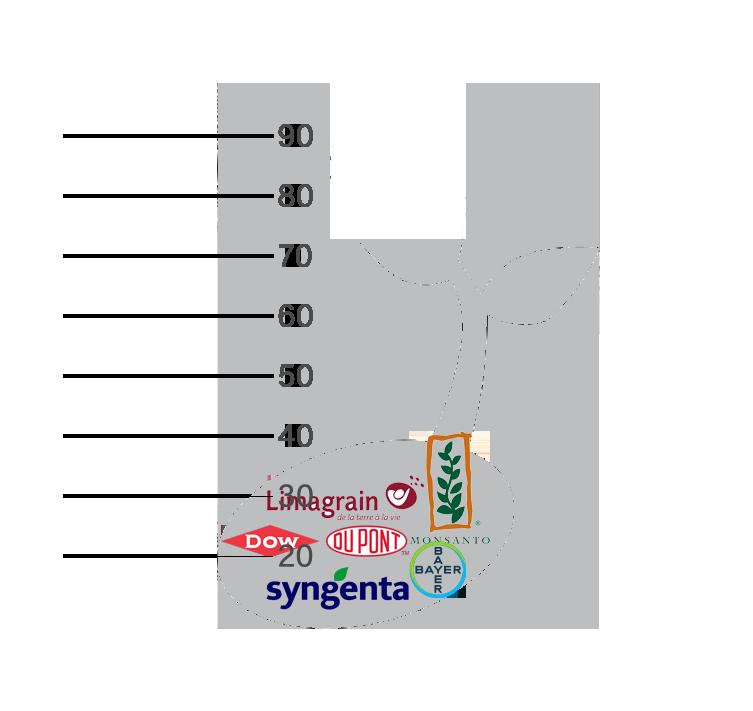
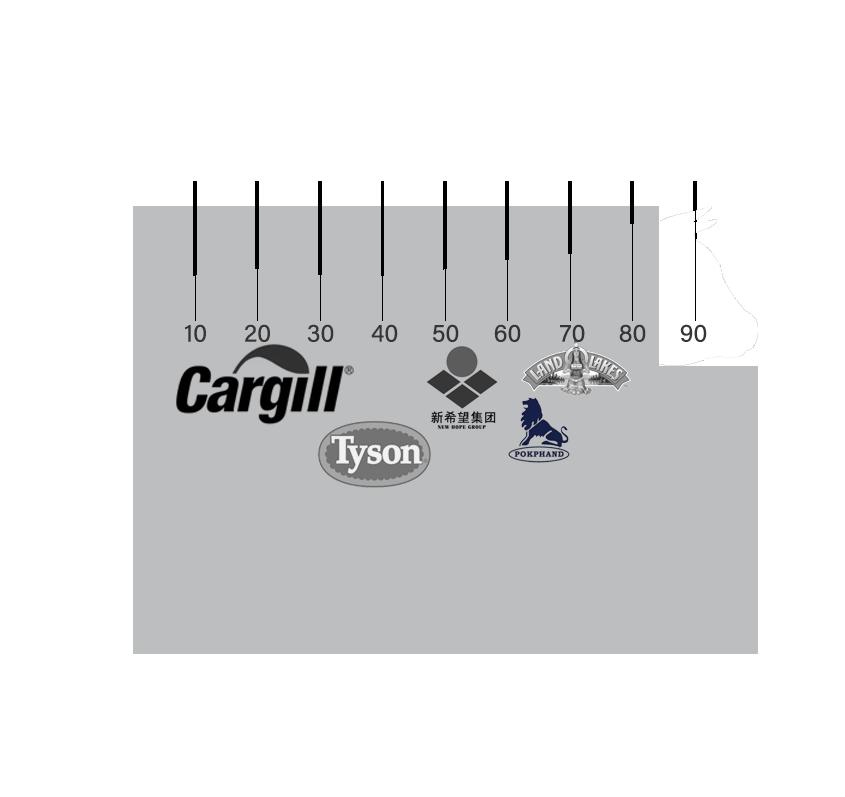
The world's largest grain traders: ADM, Bunge, Cargill, Louis Dreyfus, known as ABCD, accounted for 75% to 90% of the global grain trade a decade ago.
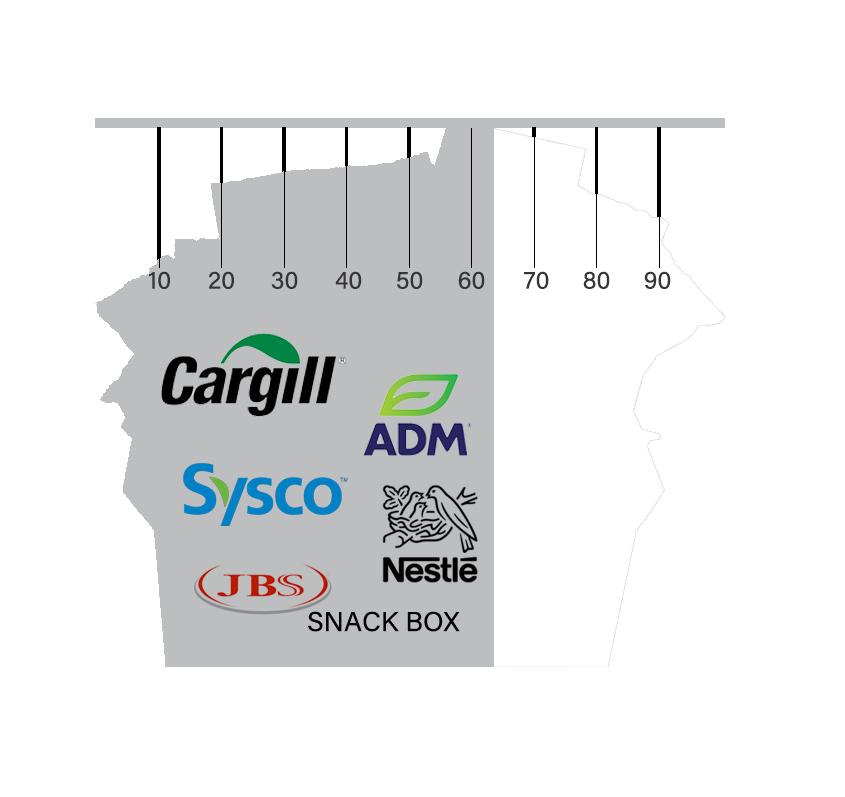
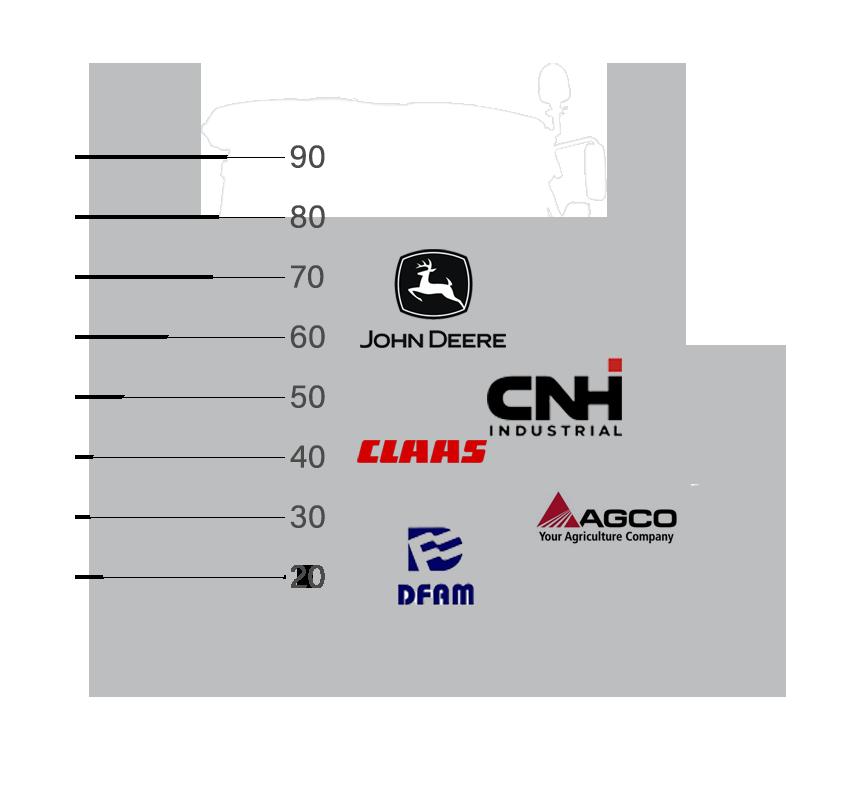
Top 10 seed companies now account for 73% of the world’s commercial seed market (the top three companies alone account for over half)8.The top four companies in harvest machinery and tractor attachments control 80% of sales. The largest eight firms sell over half of all fertilizers, and the eight top chemical companies control 64% of total chemical sales.8

But the food system held by giant companies is not efficient because they uses at least 70% of the world’s agricultural resources and is a major source of GHG emissions, but provides food to less than 30% of the world’s people.7
It is small farmer who should be the leader in the food system.
38 39 3.1.5 Comparision
FIG3-6 the peasant food web vs the industrial food chain Source: ETC Group, Who Will Feed Us?
FIG3-7 resources consumption and outputs by Meike Lei
FIG3-8 machine market share of giant companies by Meike Lei
FIG3-8 cattle market share of giant companies by Meike Lei
FIG3-8 seed market share of giant companies by Meike Lei
FIG3-8 snack market share of giant companies by Meike Lei
In today's globalised world food has become a dangerous weapon controlled by the giant multinational food companies. They spread over the world, plunder global resources and control 90% of the global food trade. They use free trade to oppress countries in the world's South, destroy local food systems and drive out indigenous farmers.

3.2.2
Global dispersion
FIG3-9 global control by Meike Lei
“The present food system is clearly unsustainable. A number of extremely powerful corporations have transformed the production of food – something as essential to human survival as air and water– into a money-making activity, in which the only goal is to produce profit for shareholders. Spreading out across the globe, these corporations are taking advantage of trade liberalisation to dump their crops on foreign markets, often ruining local farmers in the process.They are enticing local farmers to use their‘technology packages’, knowing that in this way they will make the farmers forever dependent on them.”9
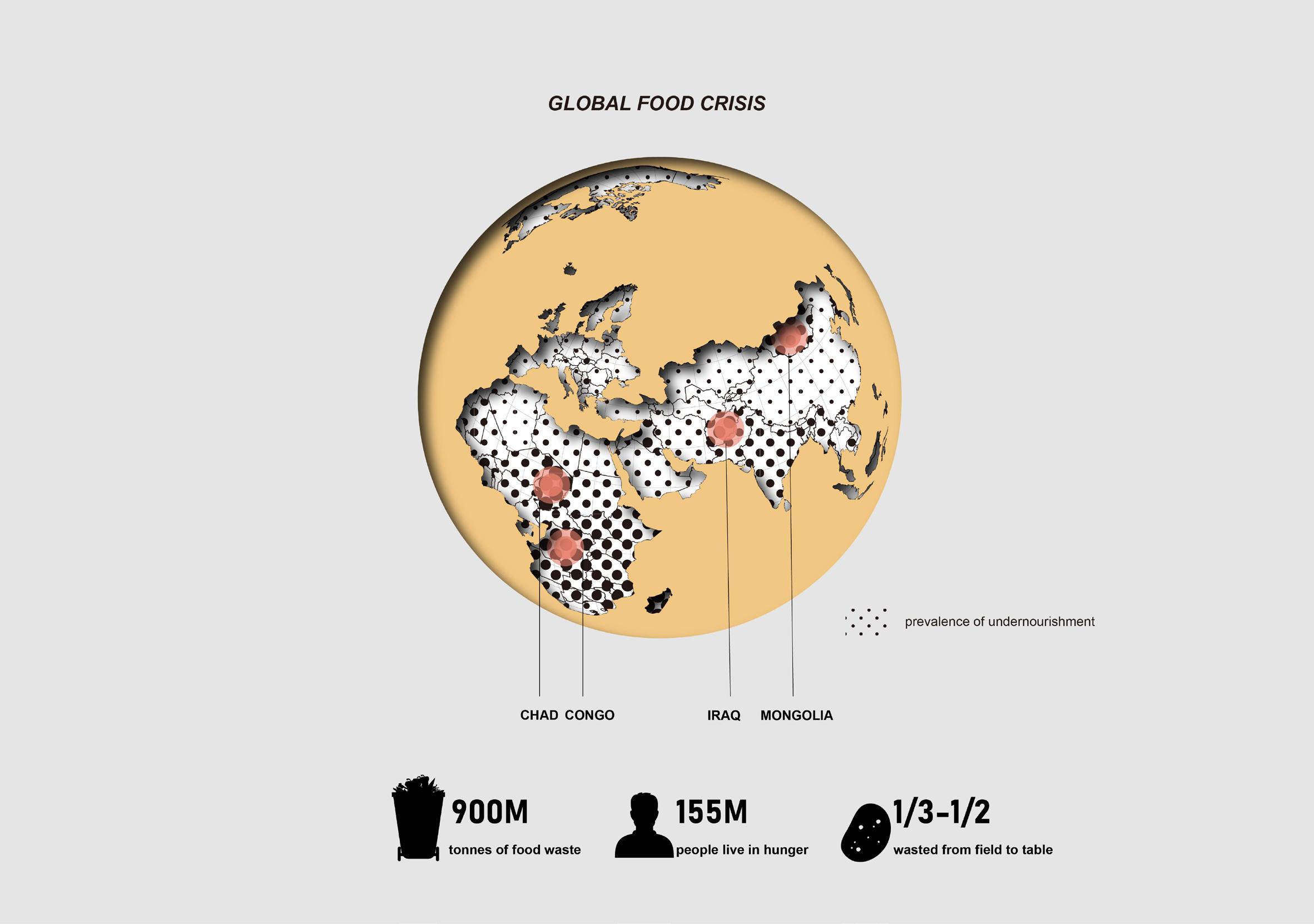
[3.3 What modern food system brings]
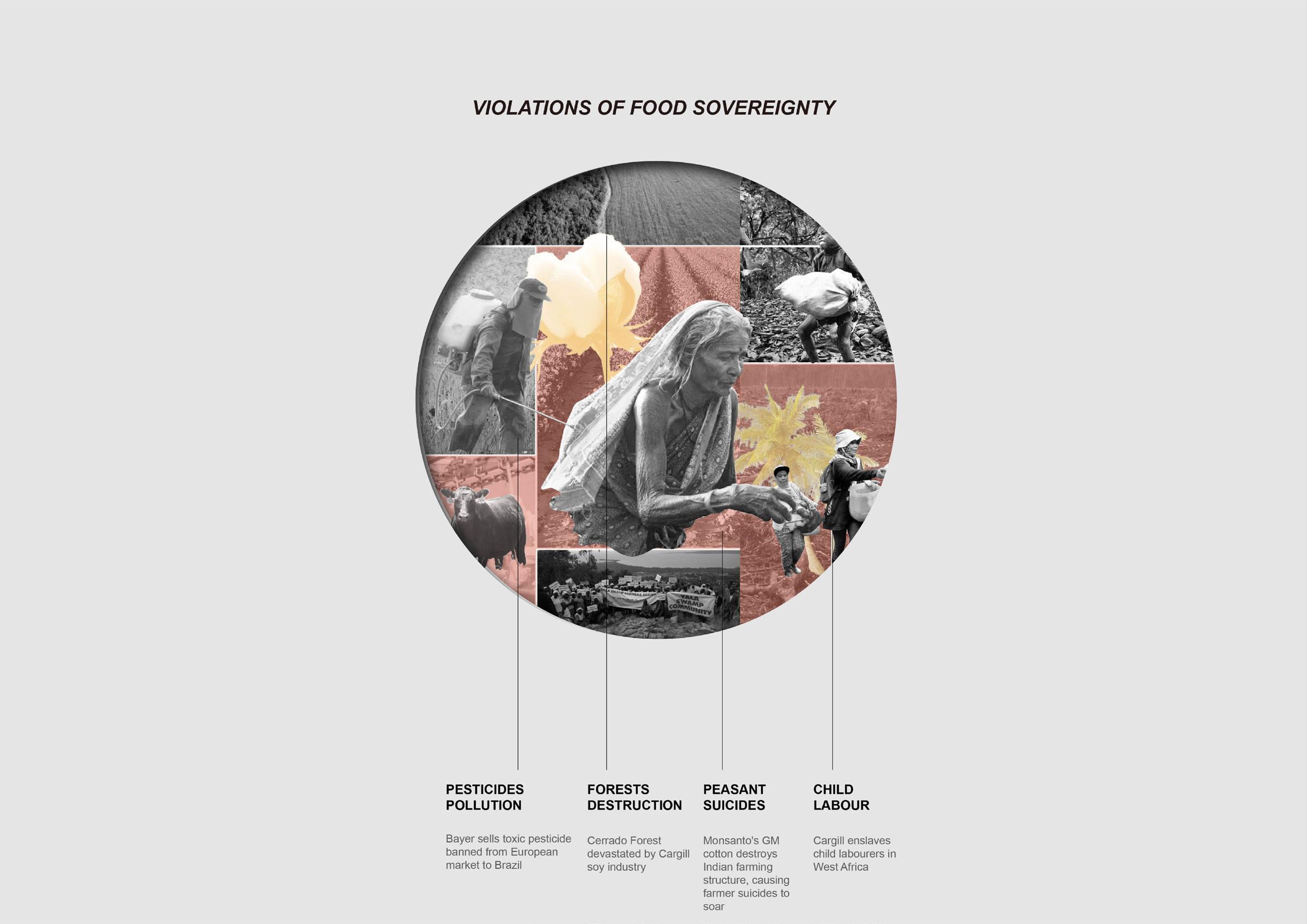
3.3.1 Food waste
Between 1/3 and 1/2 of the food from farm to table is thrown away10 because of lack of manpower, overly strict standards, machine processing, etc. Potatoes are the most wasted food in Britain, but even so, farmers are still forced to produce large quantities of potatoes that neither bring in enough profit for the farmers nor feed people who are starving - the downside of the modern food system.
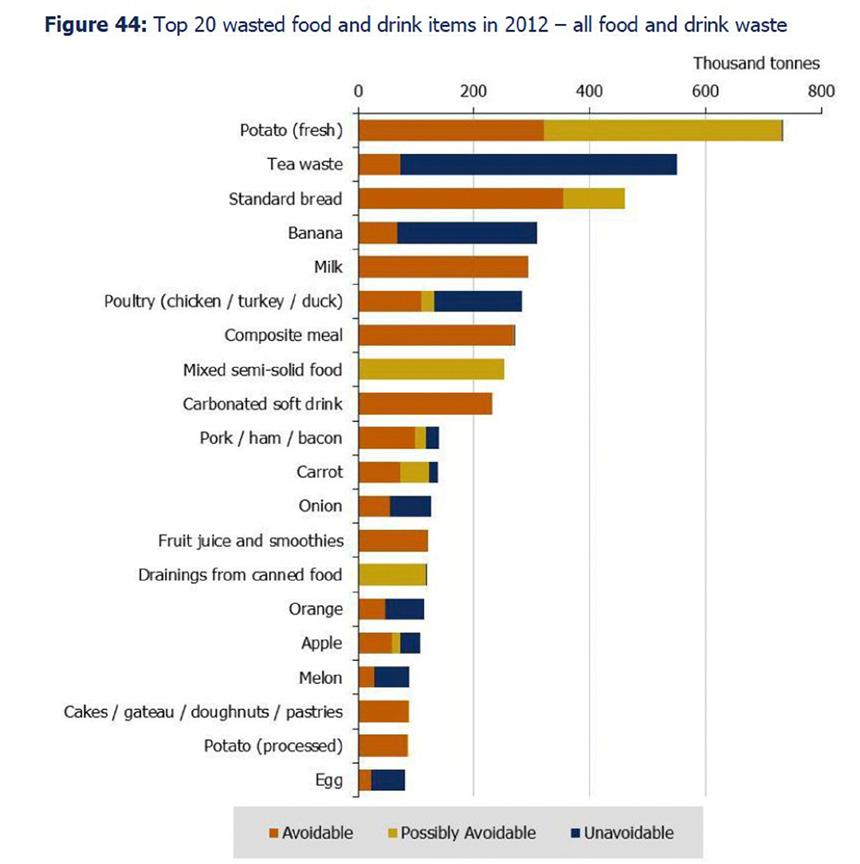
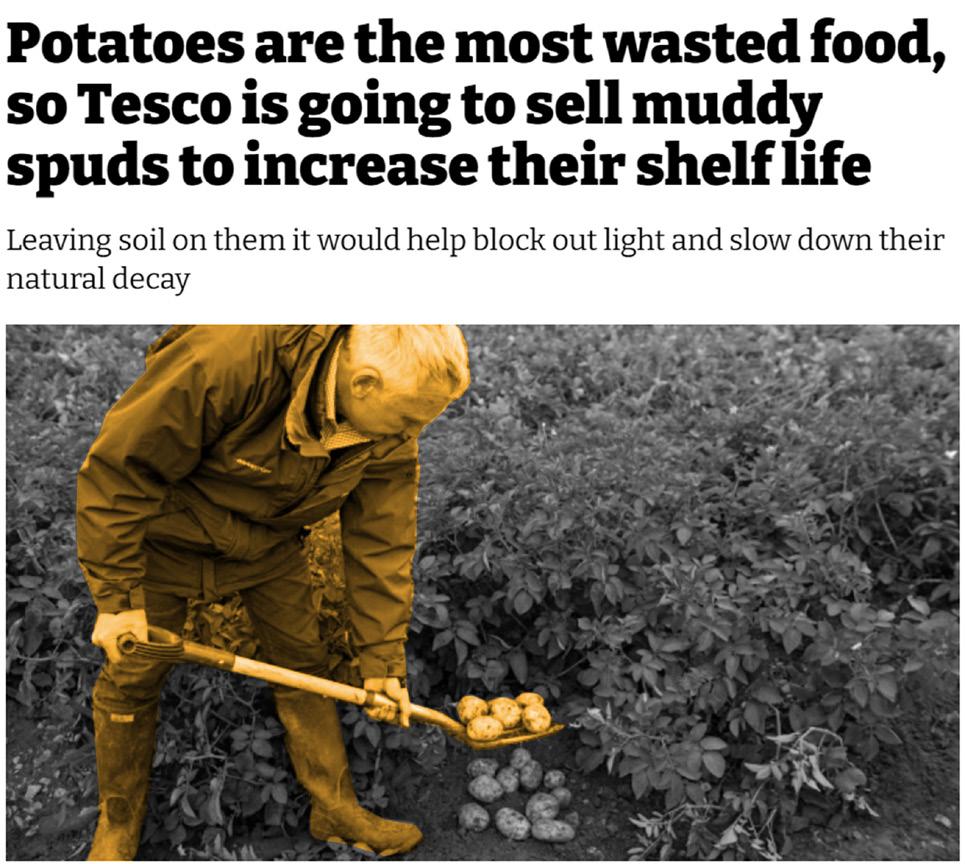
42
3.2.3 Bad deeds
FIG3-10 violations of food sovereignty by Meike Lei
FIG3-13 food waste and hunger in UK by Meike Lei
FIG3-11 potato waste source: https://inews.co.uk/
FIG3-12 potato waste source: https://www.theguardian.com/news/
3.3.3
The environmental damage caused by industrial agriculture is enormous and often involves the application of chemical fertilizers to crops or the routine, harmful use of antibiotics on animals. Industrial farms can grow a single crop on the same piece of land year after year, depleting the soil of nutrients and leading to heavy fertilisation, while manure from poultry farms can easily pollute water and air.
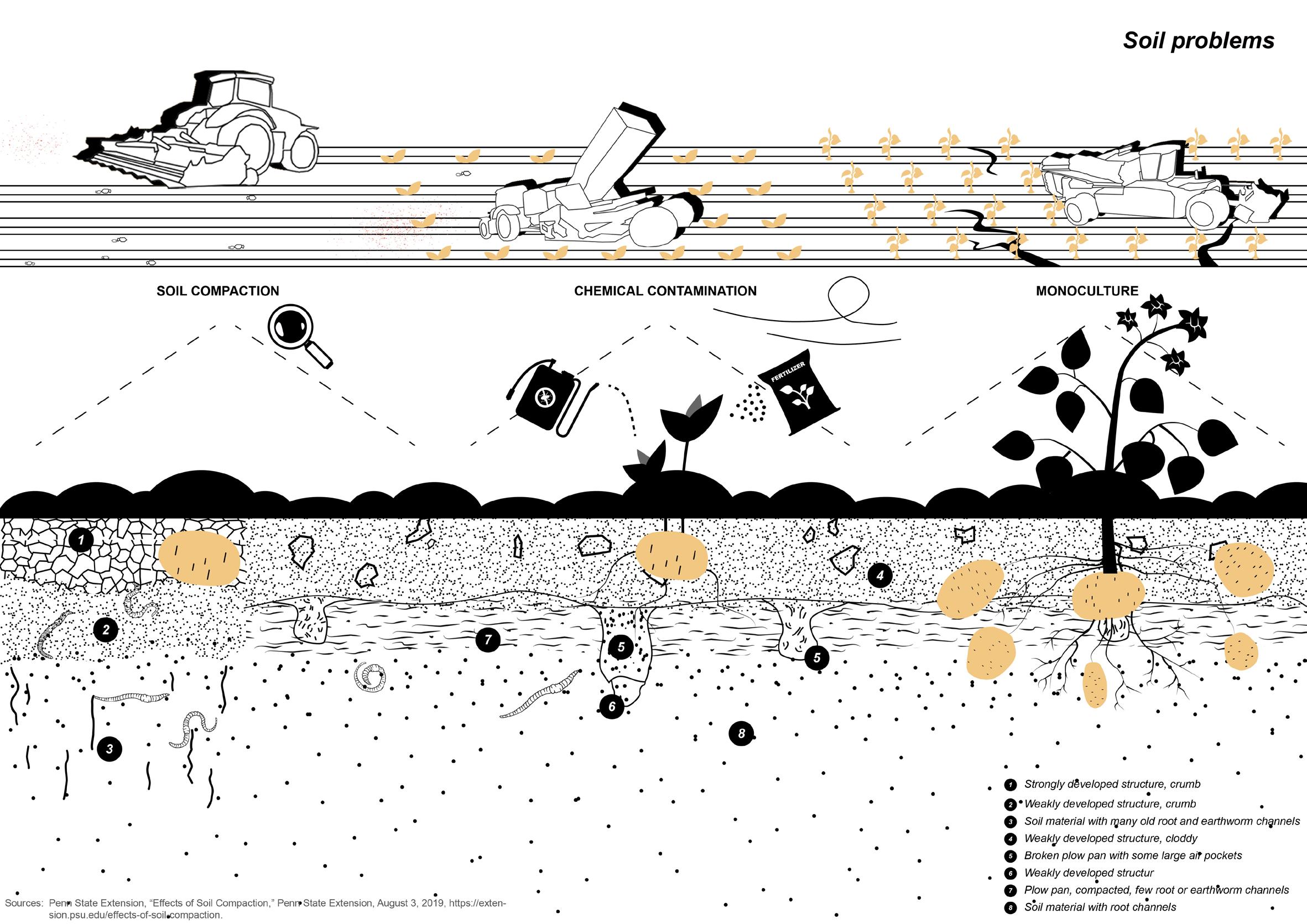

Farmers care about the soil, but industrial farming practices hurt it. Large, heavy machines compact the soil; fertilisers and pesticides contaminate it; and long-term monoculture leaves it vulnerable to erosion.
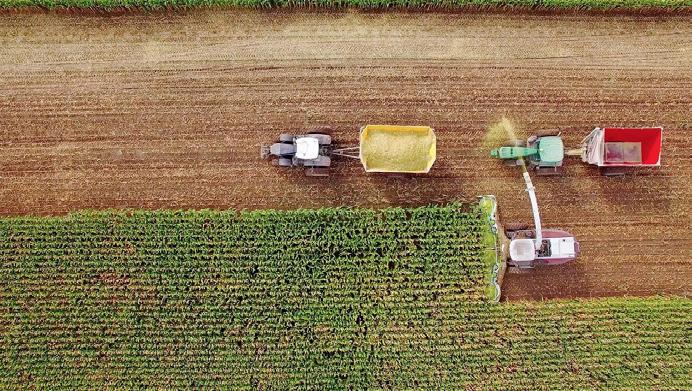

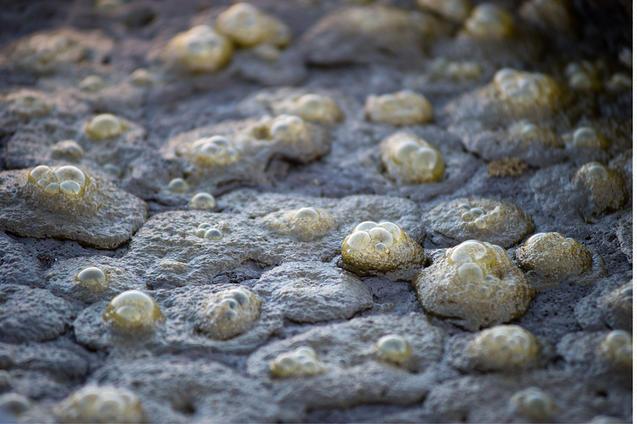
3.3.3
It's an amazing fact that in the UK we have 500 varieties of potatoes, but you can only buy the most common ones in supermarkets. The figures from the AHDB also prove that the maris pipper is grown on far more acreage than the second place. This suggests that even when targeting cash crops, farmers have a single option.

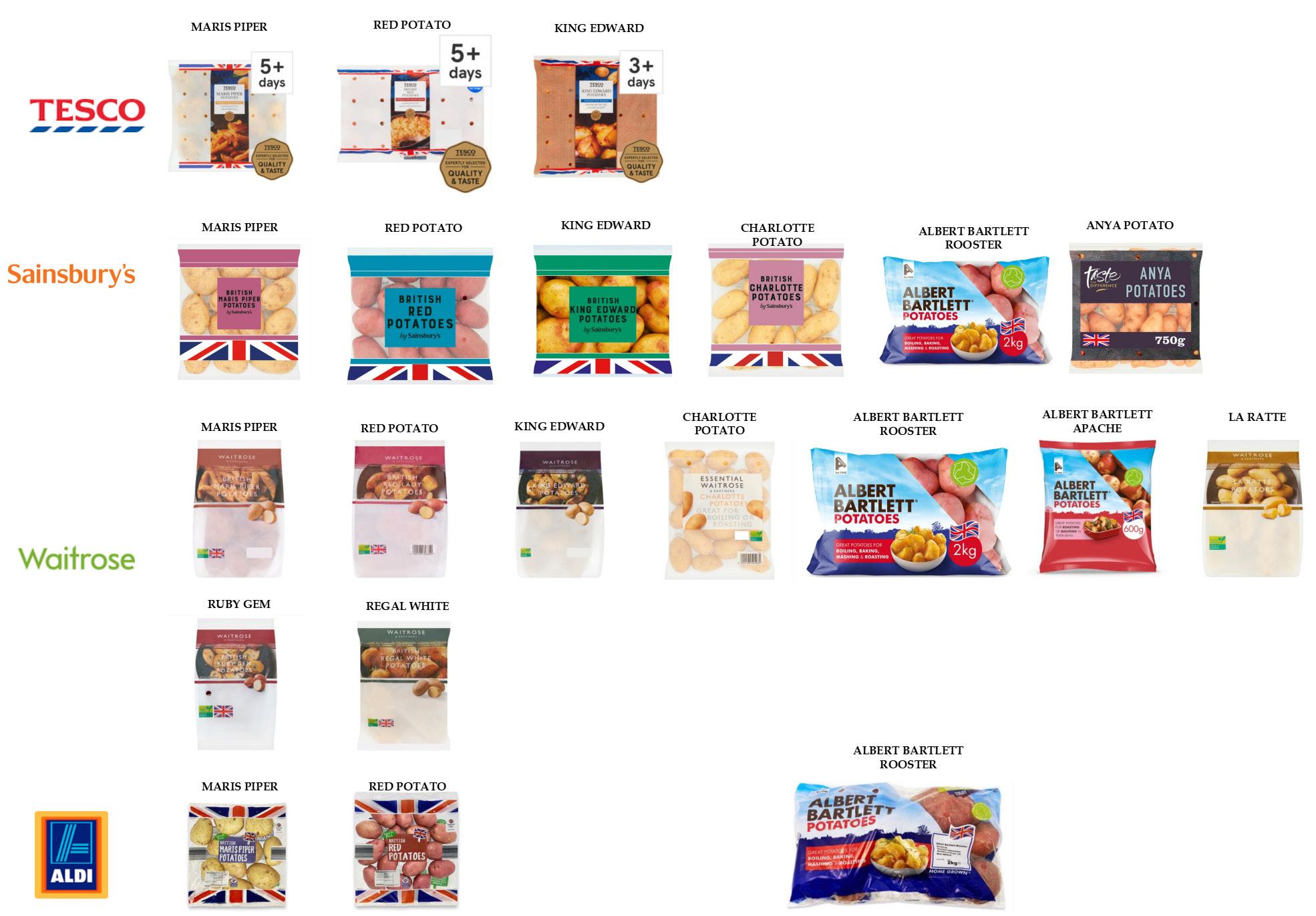
44 45
POTATO PLANTED AREA BY VARIETY (TOP50)
Species monoculture
Damage on environment
FIG3-14 industrial agricultural pollution source: https://www.nrdc.org/stories/industrial-agriculture-101
FIG3-15 soil problems by Meike Lei
FIG3-16 potato planted area source: AHDB
3.3.4 Delimmas of small potato farmers
Now in Britain, potato farmers are facing a shrinking industry. there are fewer potato farmers, the number of which has fallen from 70,000 to 3,000 since 1960,11 which also means that fewer young people are taking up farming. On the other hand, the farms are getting bigger and this is a heavy burden for the small farmers.
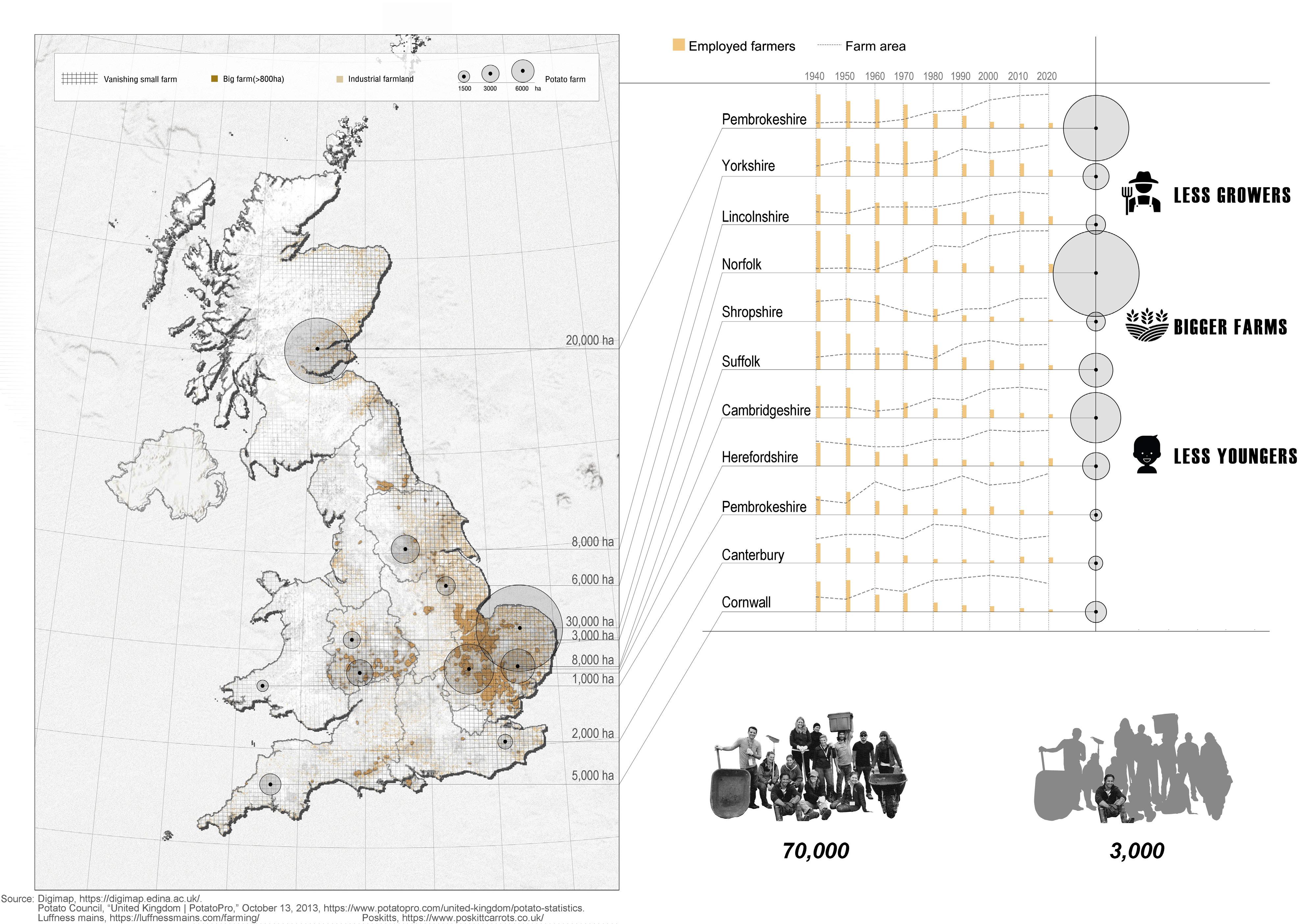
46 47
FIG3-17 dissappearing potato growers by Meike Lei, Yihan Gu
1. “Five Reasons Why a Portion of Potatoes Helps the UK Economy.” n.d. CHAP. https://chap-solutions.co.uk/blogs/five-reasons-why-tuckinginto-a-portion-of-potatoes-helps-the-uk-economy/.
2. Goffart, Jean-Pierre, Anton Haverkort, Michael Storey, Norbert Haase, Michel Martin, Pierre Lebrun, Daniel Ryckmans, Dominique Florins, and Kürt Demeulemeester. 2022. “Potato Production in Northwestern Europe (Germany, France, the Netherlands, United Kingdom, Belgium): Characteristics, Issues, Challenges and Opportunities.” Potato Research, January. https://doi.org/10.1007/ s11540-021-09535-8.
3. “A Potatoes Journey: From Field to Fork.” n.d. Robert Lindley Ltd. https://www.robertlindleyltd.co.uk/a-potatoes-journey-from-fieldto-fork/.
4. EIT Food. 2020. “Potato Loss and Waste in the UK Supply Chain and at Home.”
5. Gould, Ptrick. 2020. “The Potato Wasters: A Sociological Study of the UK Potato Industy.” THE UNIVERSITY OF MANCHESTER.
6. Thompson, Isabella, Rebecca Laughton, and Tony Little. 2021. “Vocal for Local: Why Regional Food Systems Are the Future.” The LANDWORKERS’ ALLIANCE.
7. ETC Group. Who Will Feed Us? 3rd ed., 15 Aug. 2017, etcgroup.org/ whowillfeedus.
8, 9, 10. Lawrence, Felicity. 2011. “The Global Food Crisis: ABCD of Food – How the Multinationals Dominate Trade | Felicity Lawrence.” The Guardian. June 2, 2011. https://www.theguardian.com/globaldevelopment/poverty-matters/2011/jun/02/abcd-food-giantsdominate-trade.
War on Want. Food Sovereignty Report. 11 Jan. 2011, www. waronwant.org/resources/food-sovereignty-report.
11. “United Kingdom | PotatoPro.” 2013. PotatoPro. October 13, 2013. https://www.potatopro.com/united-kingdom/potato-statistics.
FIG3-1 "Calculating the Cost of Growing Spuds," Farmers Weeky, Cctaber 16,2012htos:/wwwfw.c.ukiarablelcalculating-the cost of gixxing ots.
"Potato Costs Set to Rise by 30%," w.armninglfe.com,February 17,2012, inds)www.faming lie comicountyand-famingpotato-costsset-oriseby-30.3572327.
FIG3-2 Digimap, https://digimap.edina.ac.ukl .Rufus Pilgrim, The Future of the UK Potato Industry (AHDB Potatoes, 2017). Yell, https://www.vell.com/s/potato+suppliers-uk.
FIG3-3 “A Potatoes Journey: From Field to Fork.” n.d. Robert Lindley Ltd. https://www.robertlindleyltd.co.uk/a-potatoes-journey-fromfield-to-fork/. Digimap, https://digimap.edina.ac.uk/. Grimme, https://www.grimme.com/uk/products/ kartoffeltechnik.
“A Potatoes Journey.: From Field to Fork "Robert Lindley Ltd, n.d., https:/lwww.robertlindley'td.co.uxd/a-potatoes-journey -fromfeld-o-fore.
FIG3-5 ETH Zurich."Field to fork, potato harvest reduced by half: Food waste."ScienceDaily. www.sciencedaily.com/ releases/2015/10/151023105848.htm(accessed June 12,2022). https:/Awww.fwi.co.uk/prices-trends#/.
FIG3-7 ETC Group. Who Will Feed Us? 3rd ed., 15 Aug. 2017, etcgroup. org/whowillfeedus.
FIG3-8 War on Want. Food Sovereignty Report. 11 Jan. 2011, www. waronwant.org/resources/food-sovereignty-report.
FIG3-9 Digimap, https://digimap.edina.ac.uk/.
“Cargill Worldwide | Cargill.” Www.cargill.com, www. cargill.com/page/worldwide.
“Our History | Bunge.” Bunge.com, 2015, www.bunge.com/ whowe-are/our-history.
“A Journey through the History of Bayer.” Www.bayer.com, www.bayer.com/en/history.
“Our Heritage and Story at LDC || Louis Dreyfus Company.” Global, www.ldc.com/who-we-are/about-us/heritage/.
FIG3-10 Jordan, et al. “Cargill: The Company Feeding the World by Helping Destroy the Planet.” Unearthed, 25 Nov. 2020, unearthed. greenpeace.org/2020/11/25/cargill-deforestationagriculturehistory-pollution/.
Hertzler, Doug. “Important Victories against Agribusiness Land Grabs in Kenya.” ActionAid USA, 31 Aug. 2016, www. actionaidusa.org/blog/important-victories-agribusiness-landgrabskenya/. Accessed 20 Apr. 2022.
FIG3-13 Digimap, https://digimap.edina.ac.uk/. The Food Security Information Network (FSIN)
FIG3-17 Potato Council,"United Kingdom | PotatoPro,"October 13,2013, https:/www.potatopro.comlunited-kingdom/potatostatistcs.Luffness mains, https://luffnessmains.com/farmingl. Poskitts, https:/www.poskittcarrots.co.uk/.
48 49 [3.3 Reference]
OPPORTUNITIES FOR CHANGE 04
OBJECTIVES
The aim was to deepen our understanding of the UK potato growing industry and to find inspiration for improvements through data collection, case studies and field research
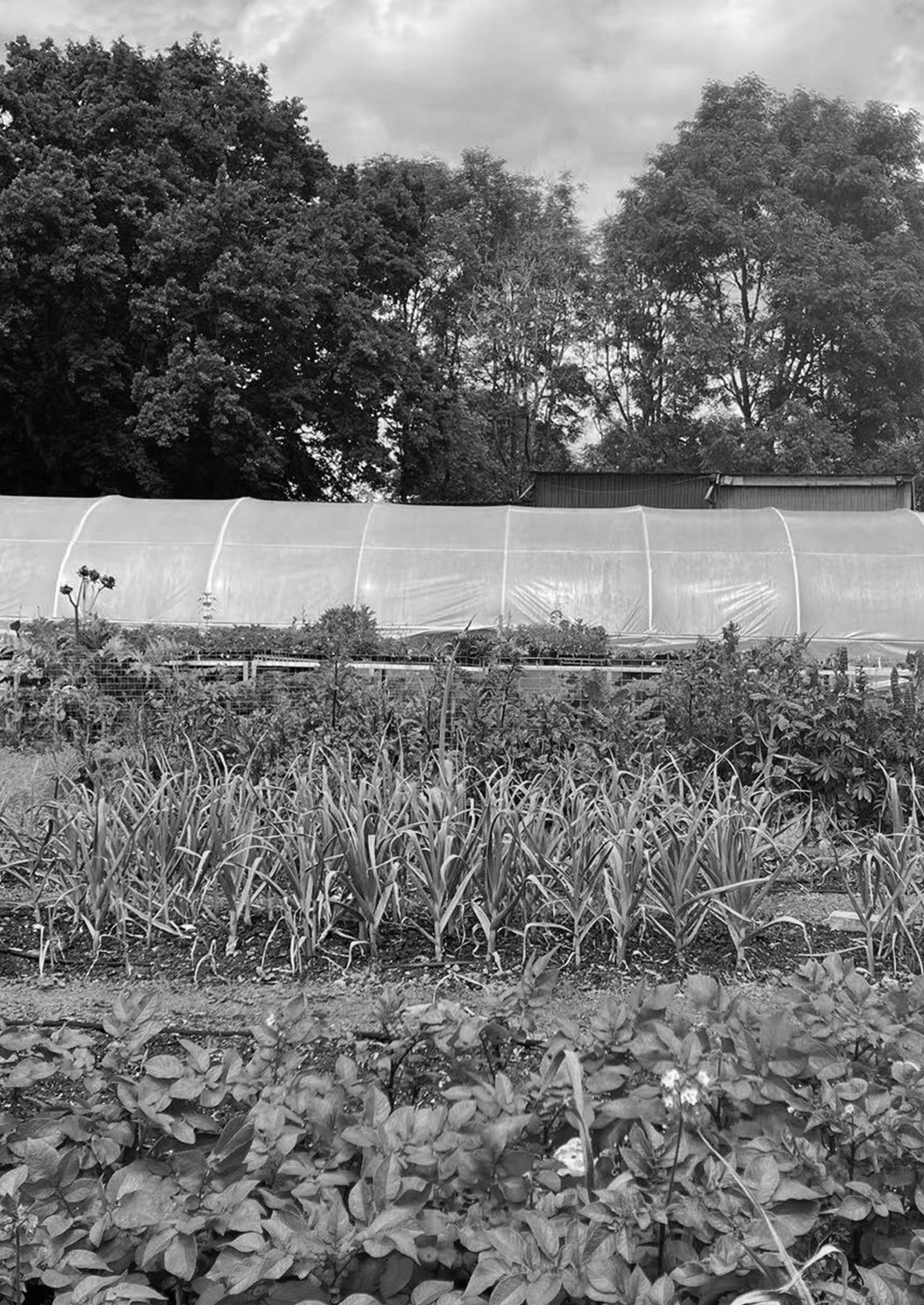
CONCLUSIONS
There are many organisations working to protect the rights of farmers, but we also have special potato varieties and projects in the pipeline that can be combined to form a system that will help small farmers and change their eating habits and nourish a new food culture.
51
[4.1 Inspiration for the project]
4.1.1 Special potatoes
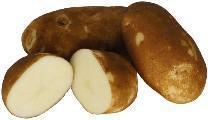
baking, roasting, steaming
We have 500 varities of potatoes in UK.1 They are grown on special soils and bred to take on special shapes, colours and flavours. We also have some native British heritage potatoes which are perfect for a certain type of cooking.

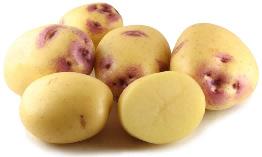
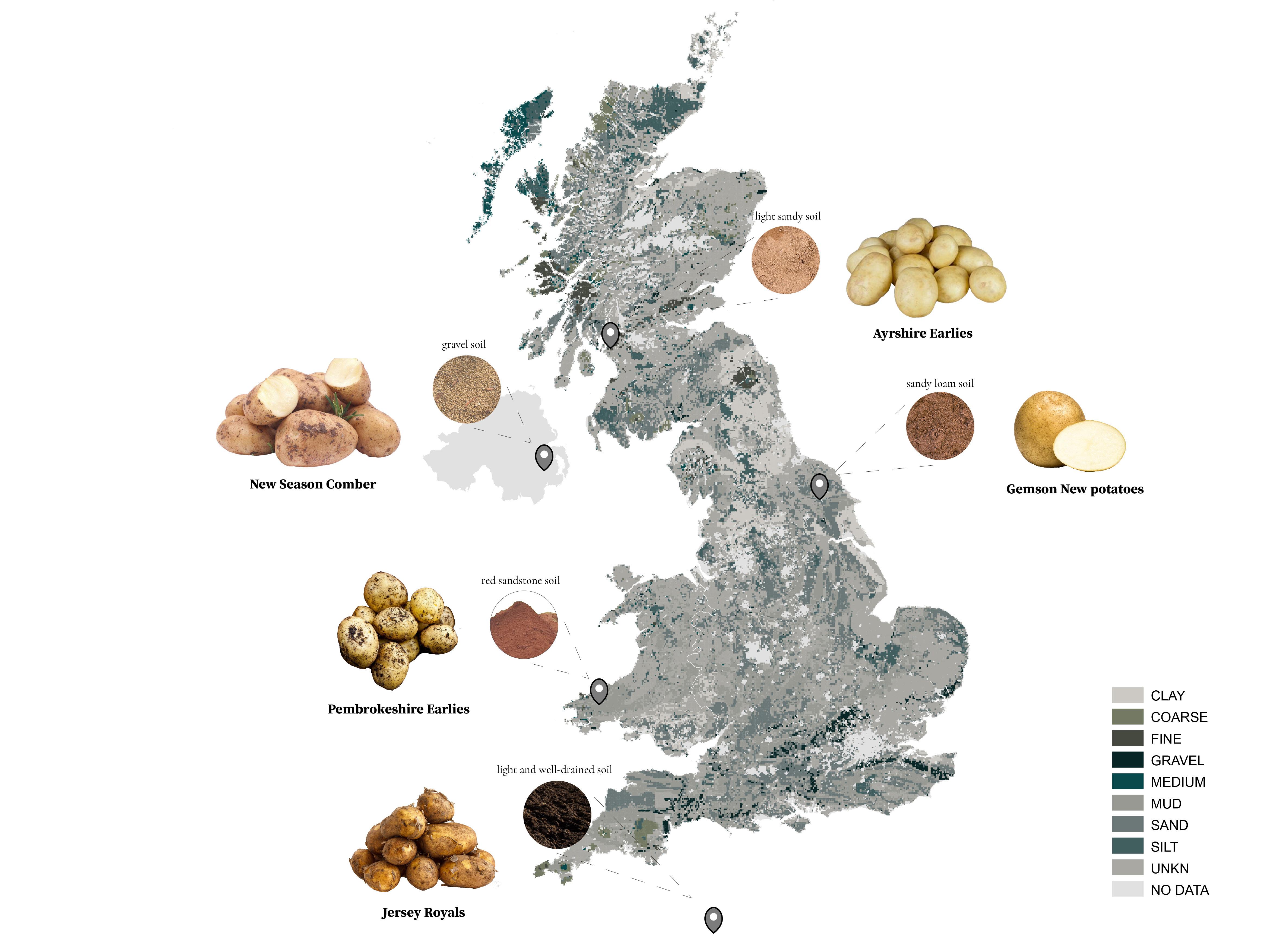
Very few farmers grow these special potatoes and if consumers want to taste them, it is difficult to find a source to buy them unless they grow them themselves. So some heritage potatoes are on the verge of extinction, but most people are completely unaware of this.
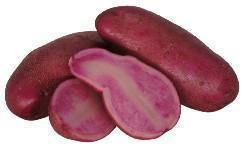
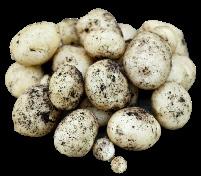
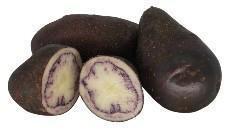
eating straight salads
roasting, steaming
all mashed baking, roasting, frying
baking, roasting, boiling, frying
52 53
SHETLAND BLACK
KESTREL
FOREMOST
BRITISH QUEEN
GOLDEN WONDER
HIGHLAND BURGUNDY RED
FIG4-1 the map of special potatoes by Meike Lei
While researching special potatoes I noticed the Pembrokeshire Earlies from Pembrokeshire, so I found Pembrokeshire to be a place full of potential. In addition to the unique potato variety, it is also the site of a food company made up of small local potato farmers, and a food park planned by the Welsh Government in haverfordwest to help small local food processors.
These conditions show that there are already forces from the government and the private sector helping the potato farmers here, and that the special potato can also be a source of a new food culture.

54 55
4.1.2 Pembrokeshire
FIG4-2 conditions of Pembrokeshire by Meike Lei, Chenxu Chen
The Welsh Government is planning to build a food park on a 23 hectare site. They intend to serve local small businesses by creating an industrial park that will allow them to produce and process their own food.
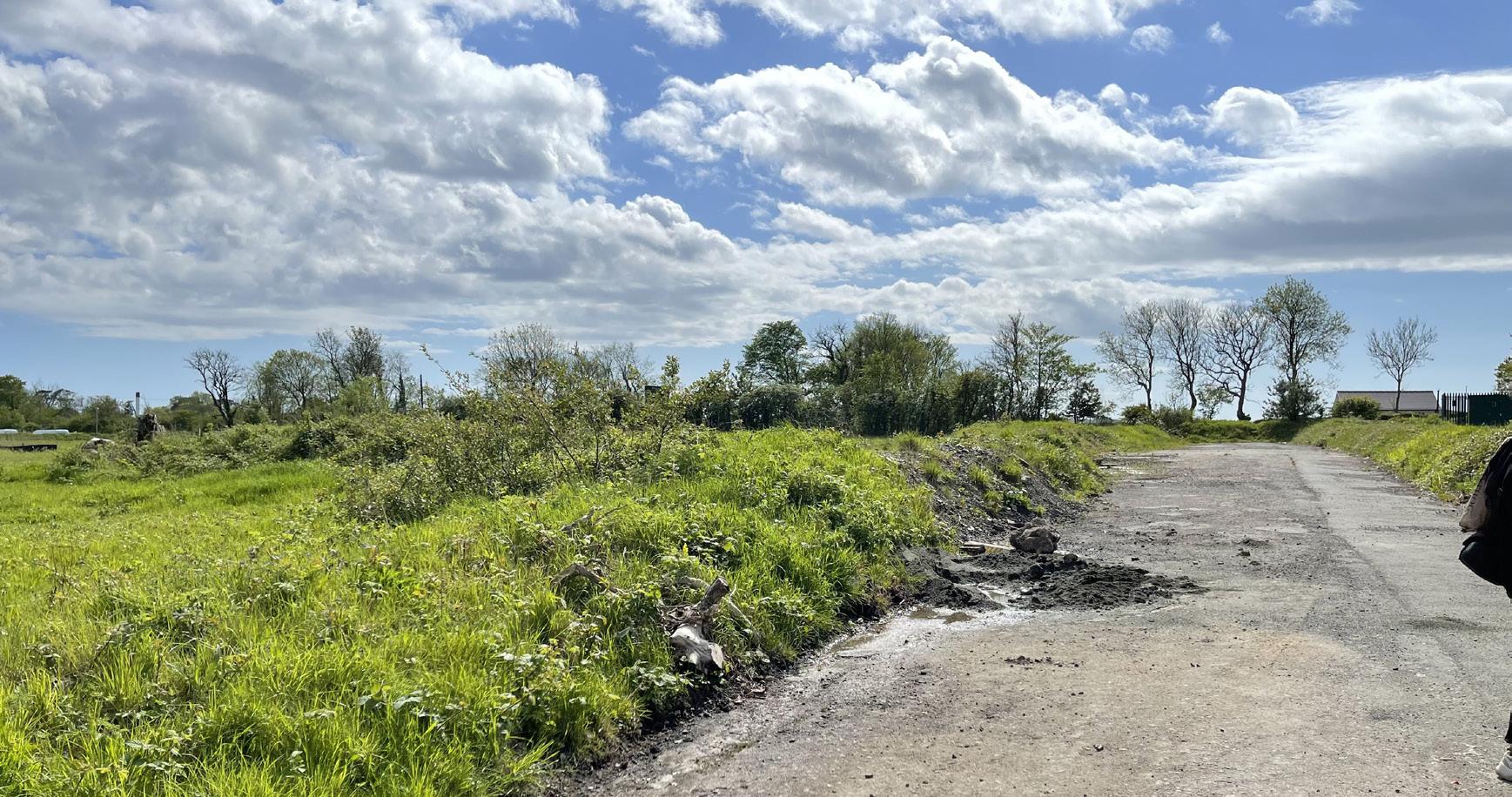

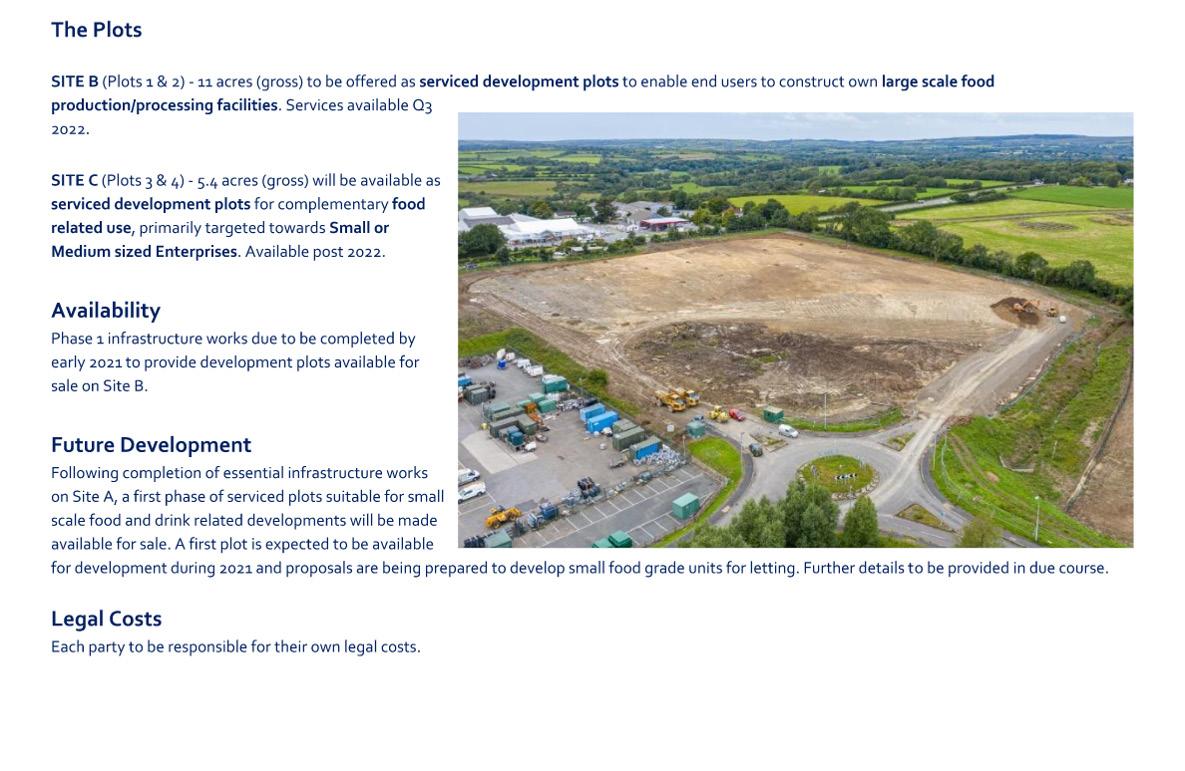

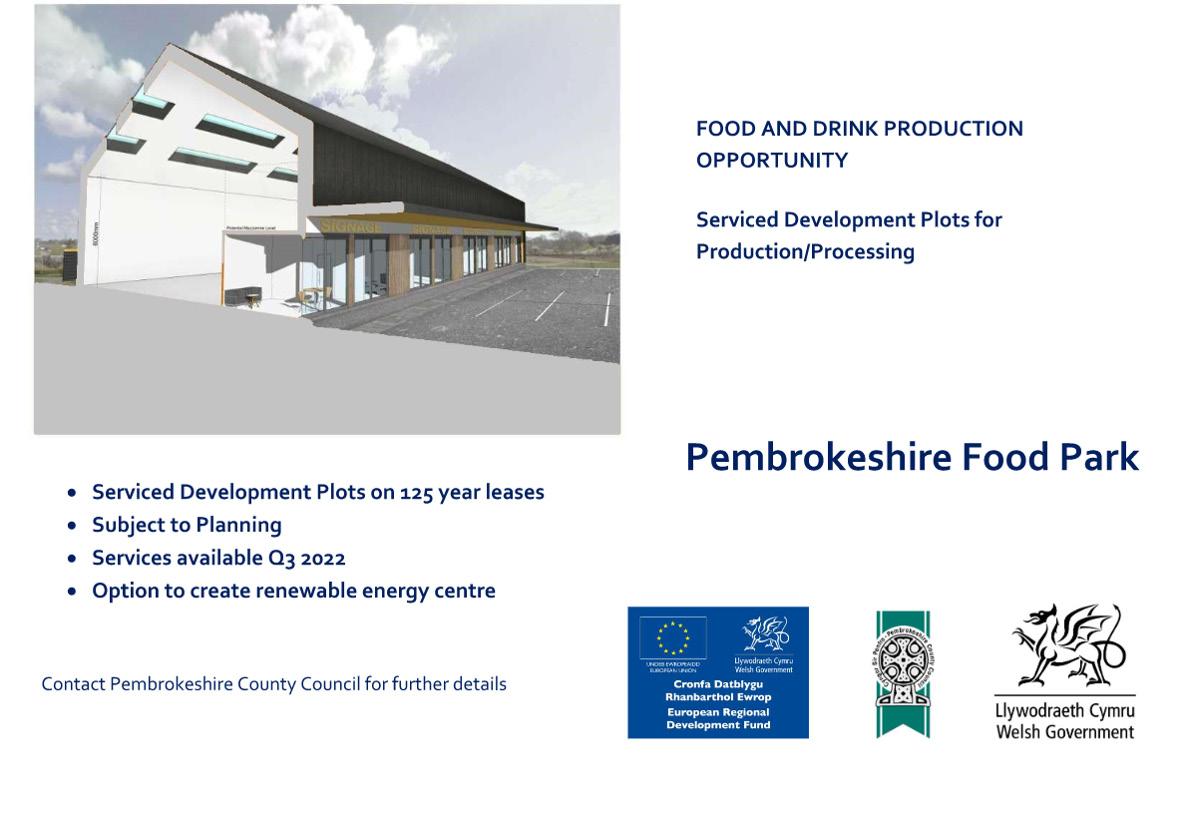
When we arrived there, in April 2022, unfortunately the park was still wilderness and construction had not yet begun.
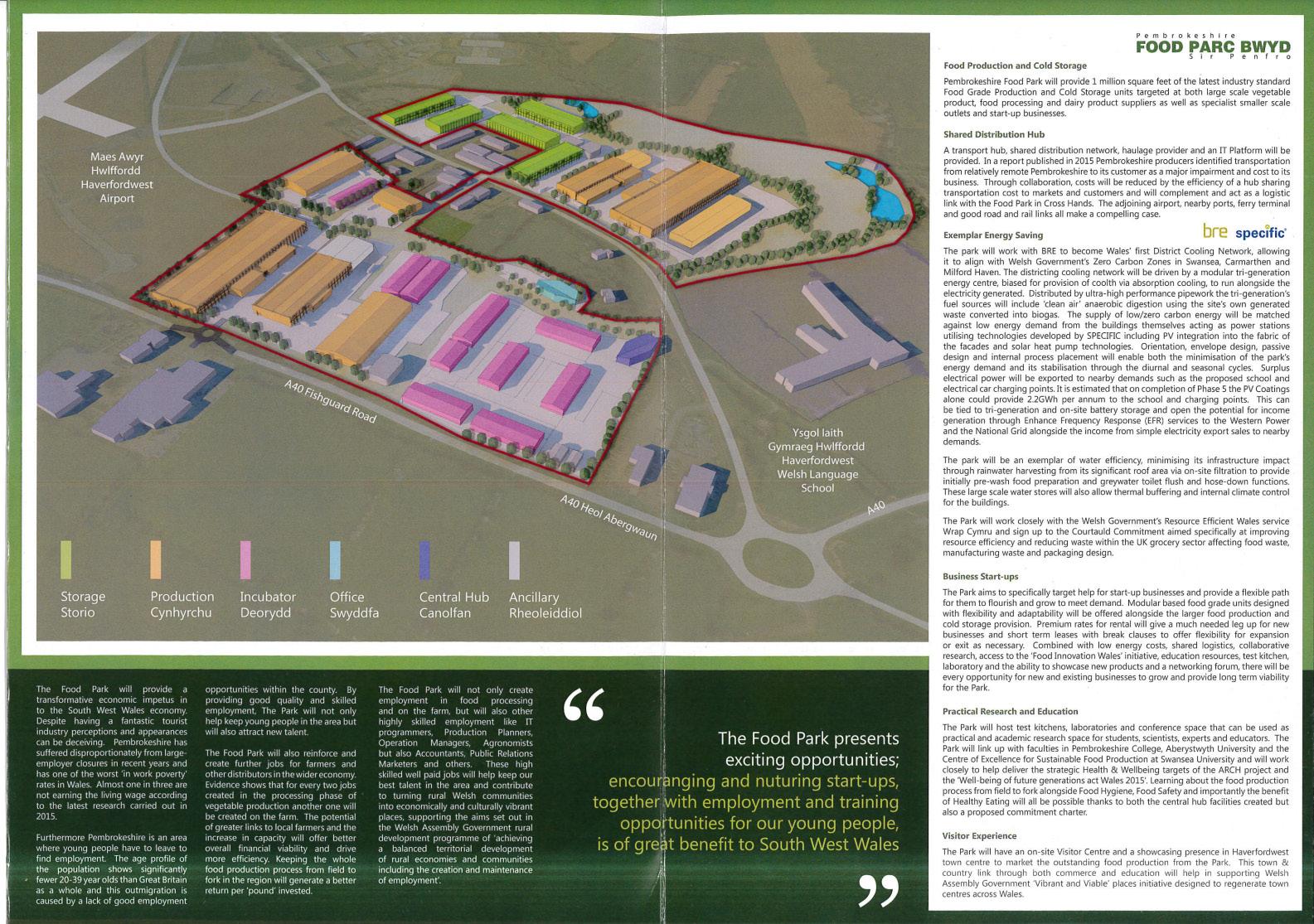
56 57
4.1.3 The food park
FIG4-3 the food park in Pembrokeshire source: https://www.pembrokeshire.gov.uk/
FIG4-4 the photo of food park by Team
FIG4-3 the food park in Pembrokeshire source: https://www.pembrokeshire.gov.uk/
[4.2 Field trips]
4.2.1 Pembrokeshire
In Pembrokeshire we spoke to the farmer of the largest potato farm in the area, who works with local company Puffin Produce and also supplies potatoes to supermarkets.
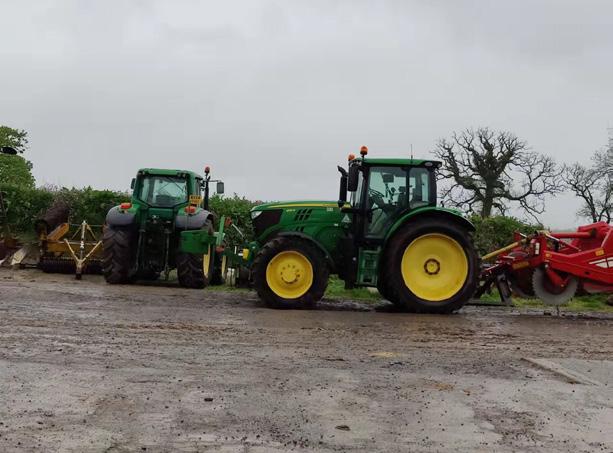
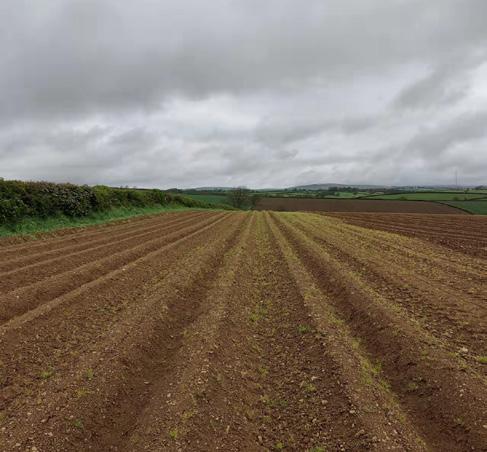
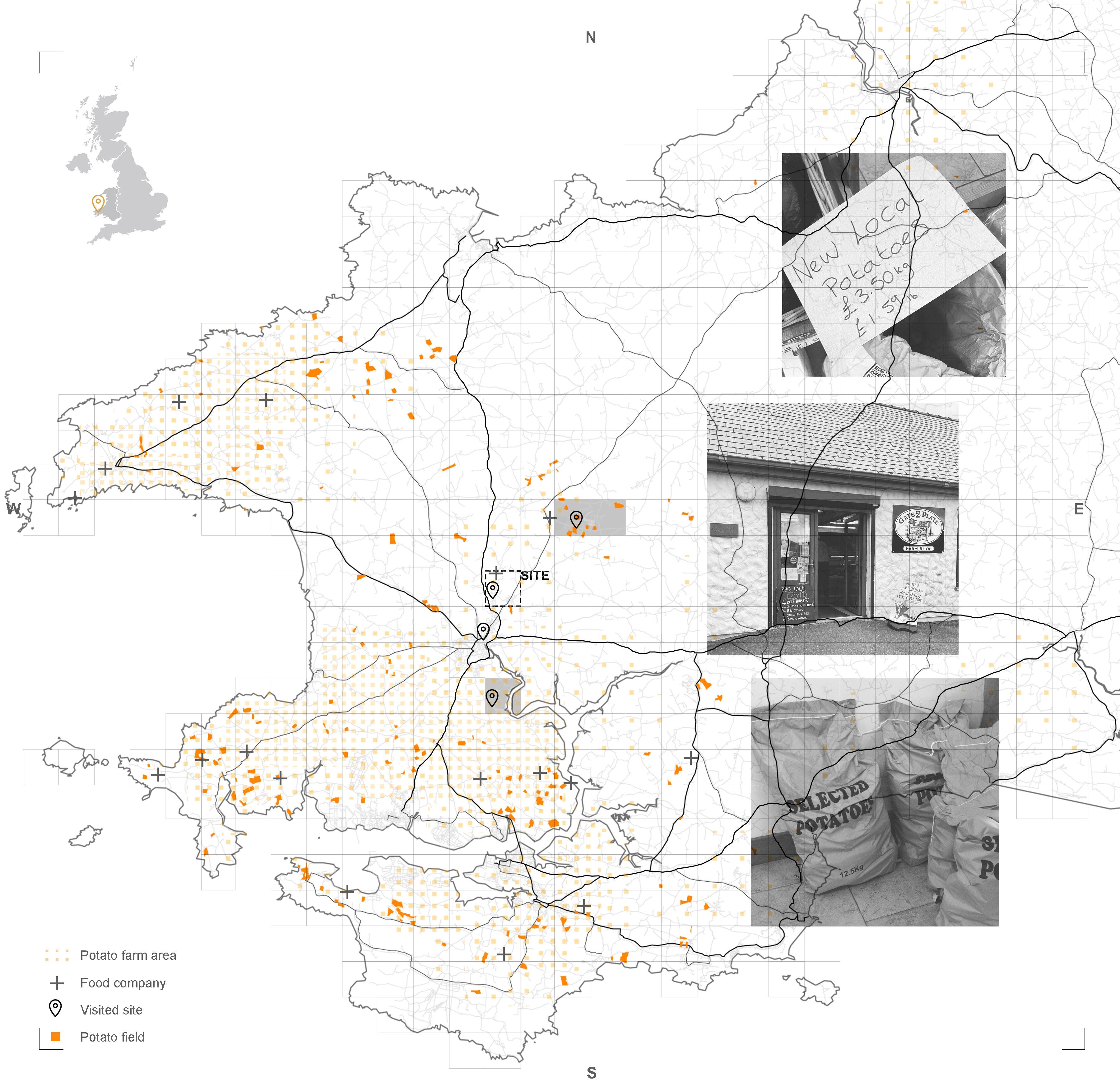
We also visited the local farm shop, where we found a strong foodie scene, with banners and billboards around the city advertising local food and upcoming food festivals.

Farmers in Kent run a medium-sized farm and every weekend they sell their potatoes at the Farmers Market in London, where customers are curious about their special potatoes.
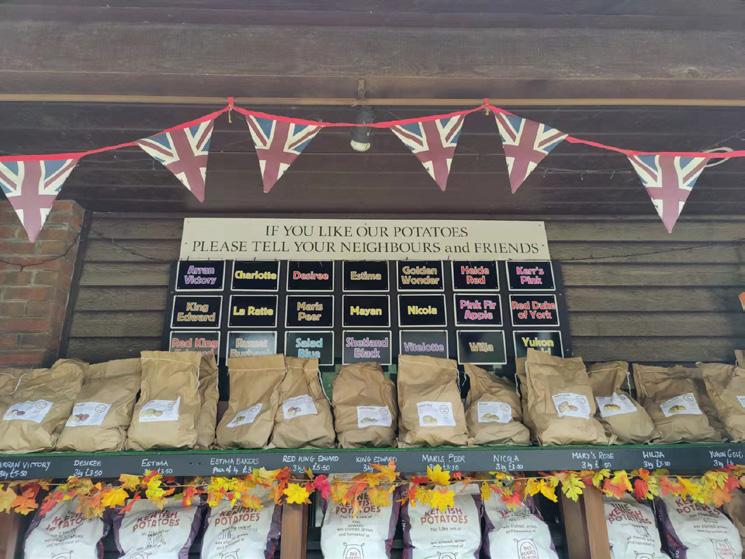

The small farm in Ashford had no processing facilities, just food that had been simply packaged, yet the packaging was biodegradable and very friendly to the environment. There are also no mechanical facilities on the farm, which is basically all hand tools. In addition, the farmer has created his own brand and all the food he produces is sold under this brand name.
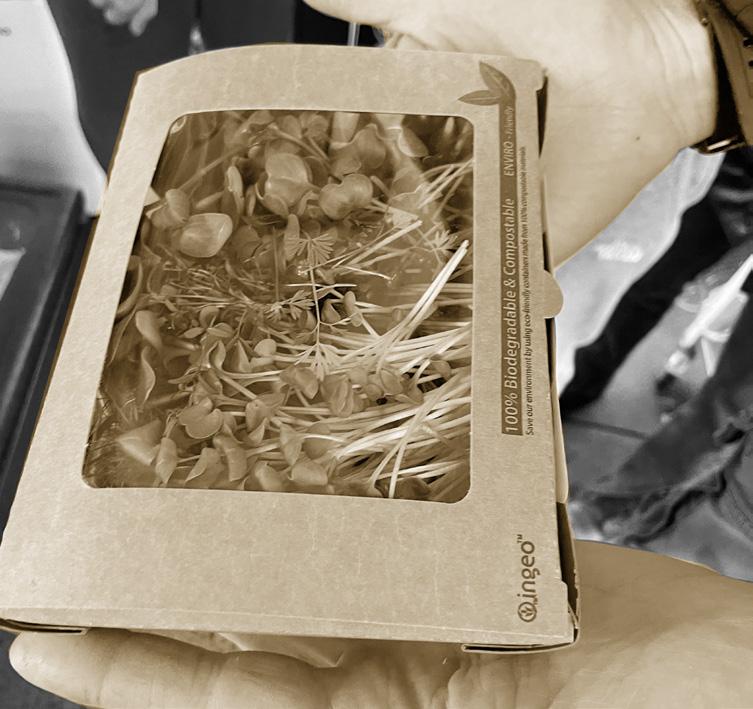
The farmer has a small poly tunnel where visitors, surrounded by crops, could have a cup of coffee.
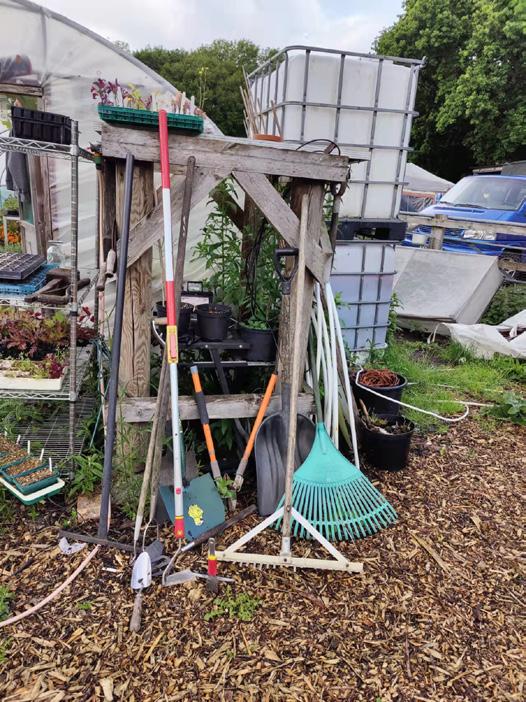
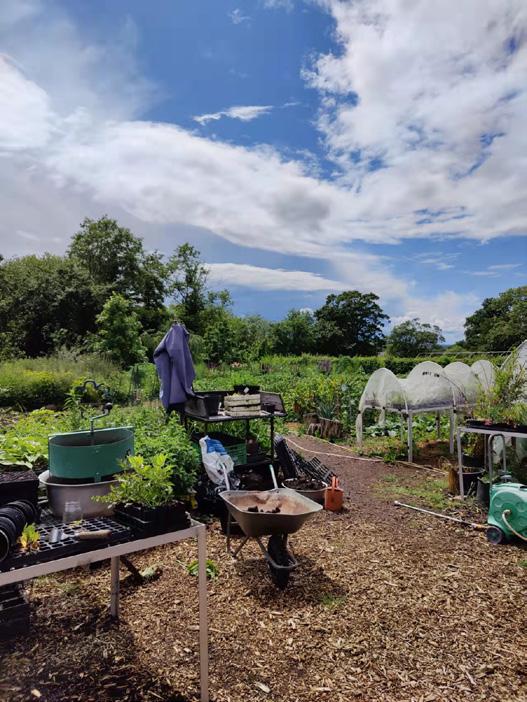
I went to Kent to visit the growers of these potatoes and I was then told that they were the only special potato growers in the South East part of England.
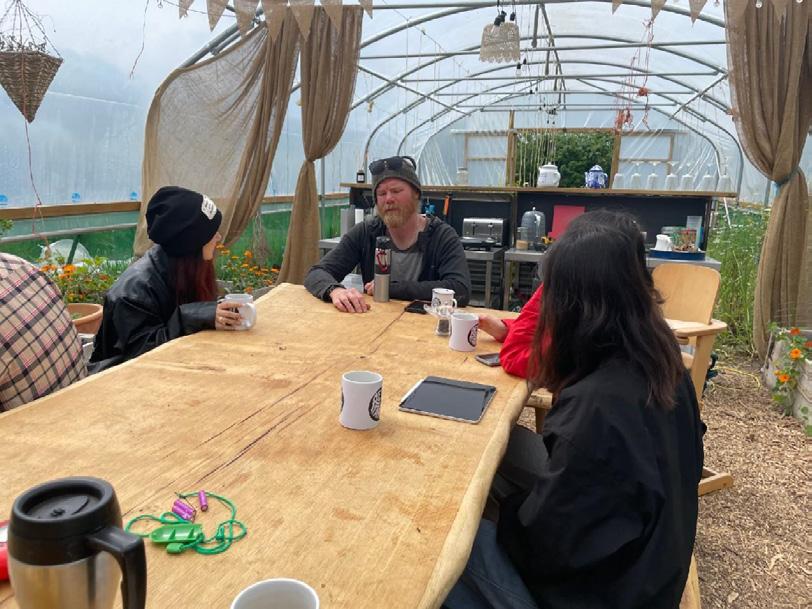
58 59
4.2.2 Ashford
4.2.3 Kent
FIG4-5 map of visited sites by Jiamin Hu, Chenxu Chen
FIG4-6 photos of Pembrokeshire by Team
FIG4-8 photos of Kent by Meike Lei
FIG4-7 photos of Ashford by Team
4.3.1 Other food parks
Apart from Pembrokeshire, food parks have already been spreading in the UK in different styles. Currently, most food parks position their core at the consuming level, serving consumer groups through community kitchens, markets, and food processing.
The functions are all relatively homogeneous, commercial or industrial, and mainly serve the consumer.
4.3.2 Organisations
According to the report, many smallholder farmers need more infrastructures to sell their food and, more importantly, lack access to platforms, funding and government policies to support them.
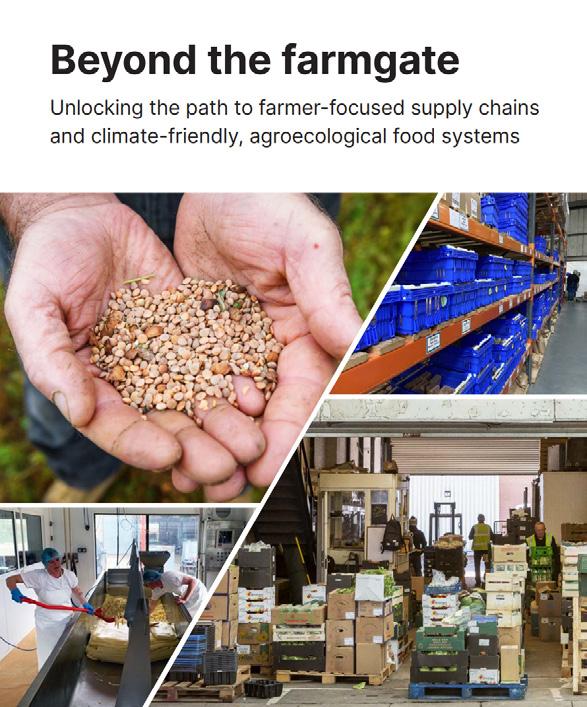
I also found the existing community organizations and land trusts, consumer groups and community kitchens helps to develop local food supplies, but they are not fully supported by policy, and most of them are so limited in scale and distribution.
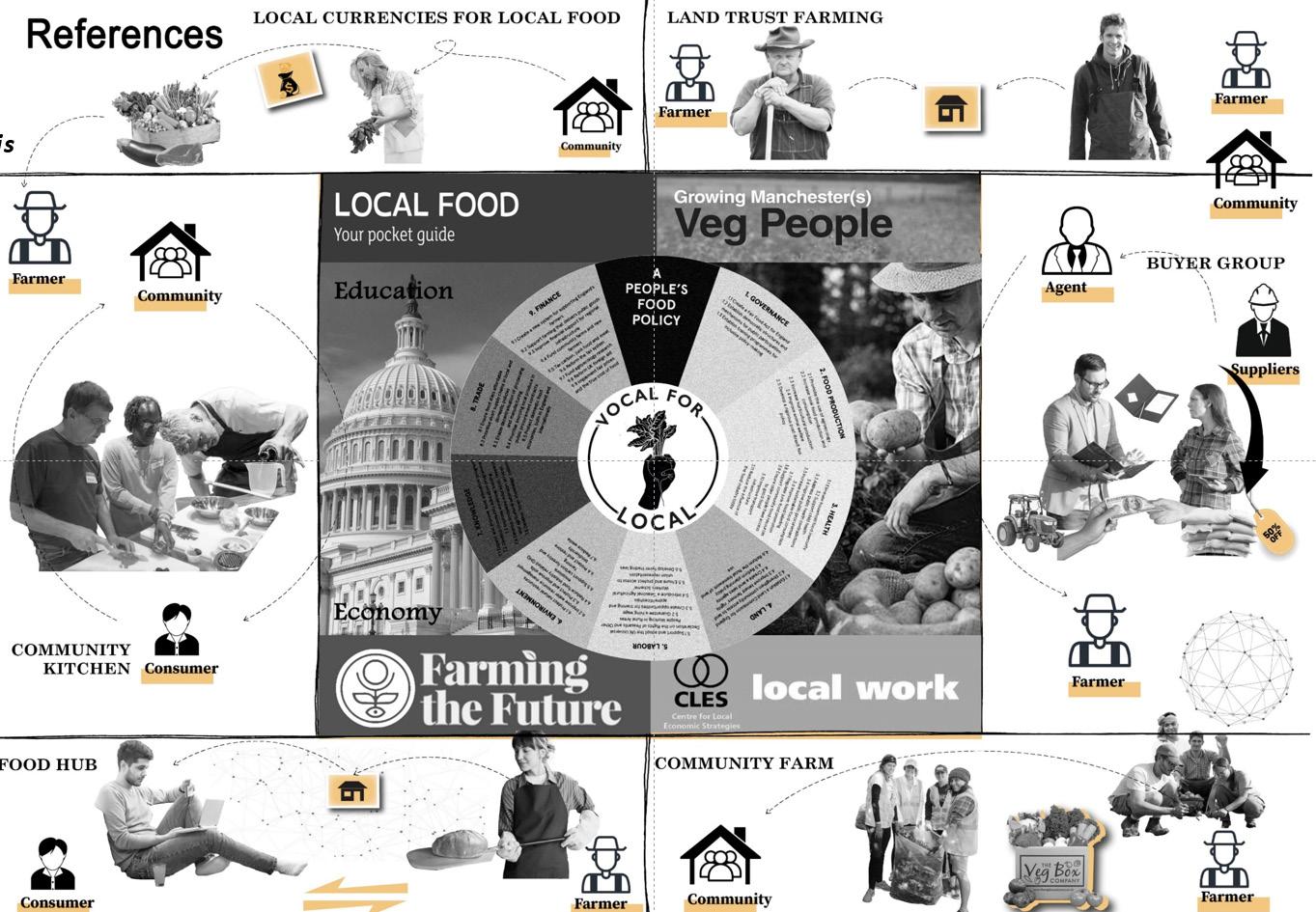
Another drawback is that most organisations lack an interest in eating habits and food culture, which is a very important part of food sovereignty.
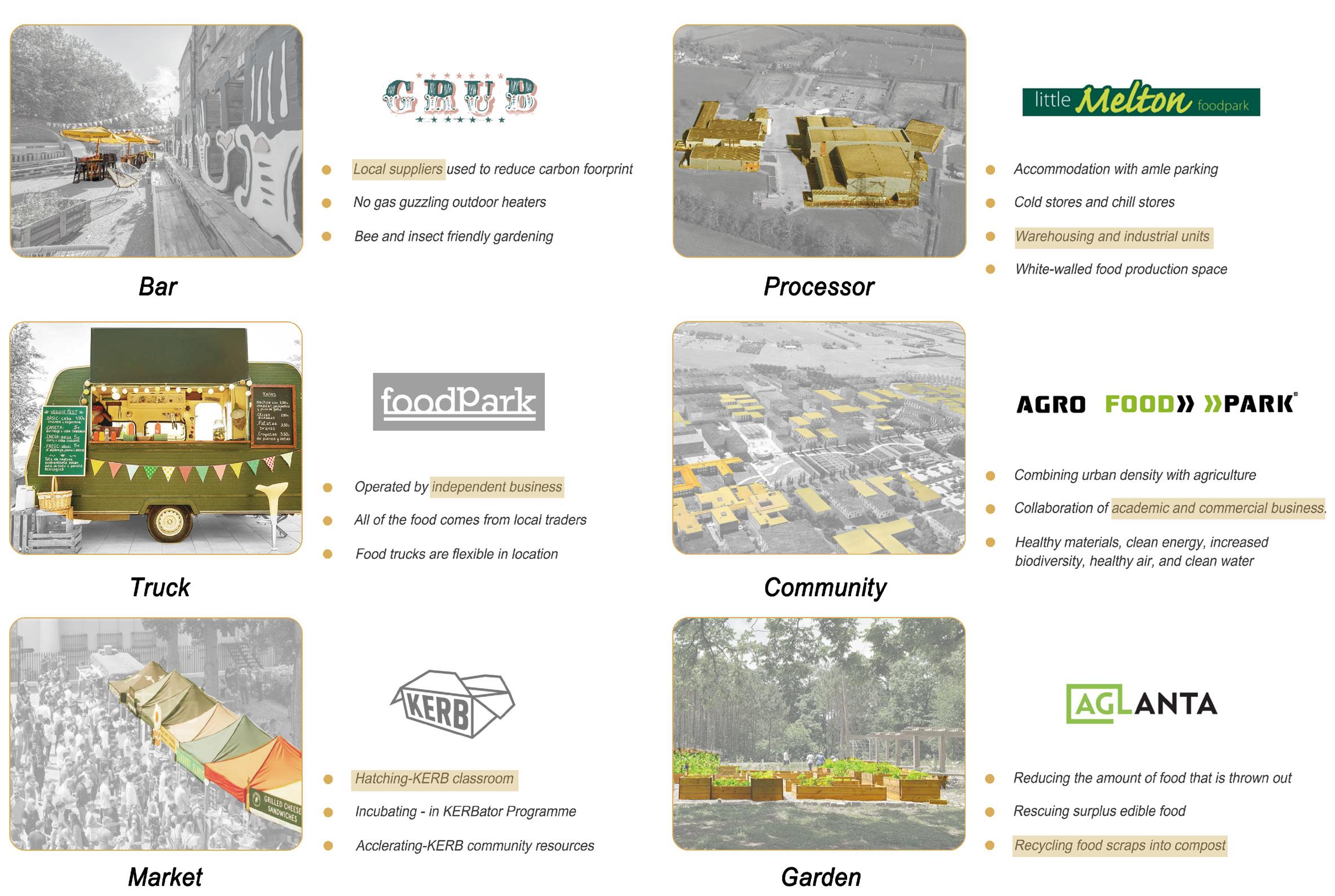
60 61 [4.3 Additional references]
FIG4-9 models of other food parks by Yihan Gu, Jingru Yang
FIG4-10 organisations by Meike Lei
FIG4-11 beyond the farmgate source: Beyond the farmgate: Unlocking the path to farmer-focused supply chains and climate-friendly, agroecological food systems, 26pp - 2021
1. Green, Author Liana. 2020. “Types of Potatoes - Know Which Potato Varieties to Use When!” Liana’s Kitchen. September 1, 2020. https:// lianaskitchen.co.uk/types-of-potatoes/.
FIG4-1 Digimap, https://digimap.edina.ac.uk/. maghera. 2017. “Old-Fashioned Potato Varieties.” Maghera Heritage Centre. July 15, 2017. https://www.maghera-heritage.org. uk/tag/old-fashioned-potato-varieties/.
FIG4-2 Digimap, https://digimap.edina.ac.uk/. "Pembrokeshire Food Park".https://www.pembrokeshire. gov.uk/property-detail/pembrokeshire-food-parkwithybushhaverfordwest.
FIG 4-10 "Southernfarmers".https://southernfarmers.co.uk/ "Biodynamic Land Trust".https://biodynamiclandtrust.org. uk/ "The Community Farm".https://www.thecommunityfarm. co.uk/
''Made In Hackney''.https://madeinhackney.org/ "The Great British Food Hub".https:// thegreatbritishfoodhub.com/
62 63 [4.3 Reference]
SITE PLANNING AND ANALYSIS 05
OBJECTIVES
Through a series of previous research and analysis I have been inspired by the plight of small potato farmers in a market controlled by giant corporations, the unique potato varieties of Pembrokeshire and the government's plans for a food park, I now wish to clarify the site conditions for the food park and then combine the previous conditions to complete the design of the food park.

CONCLUSIONS
The food park is a, on the one hand, collaborative effort with other organisations and government support to improve farmers' interests, and it is being built in conjunction with government policies and regular farmers' meetings to improve farmers' real plight.
On the other hand, On the other hand, the food park is also responsible for connecting the field to the table, and it will promote the food culture of the region through a wide range of crops and creative recipes.
65
https://www.common-wealth.co.uk/
Synthesising previous research, the core of the proposed food park is to provide small farmers who farm with certain equipment and access to information, giving them greater autonomy; to provide an additional place for producers and consumers to trade fresh, unfashionable food; and to connect FIELD and TABLE, gradually changing the eating habits of the community and the farmland landscape.
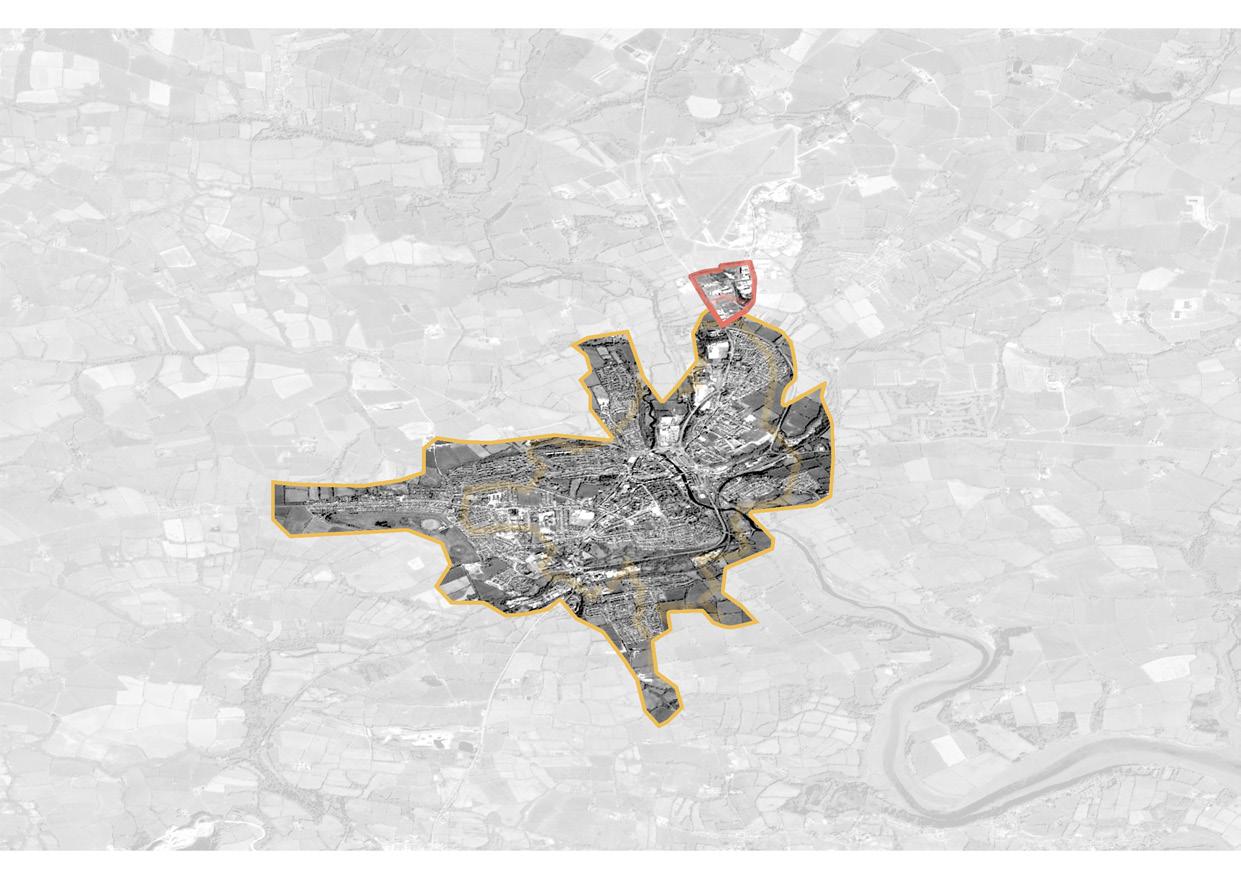
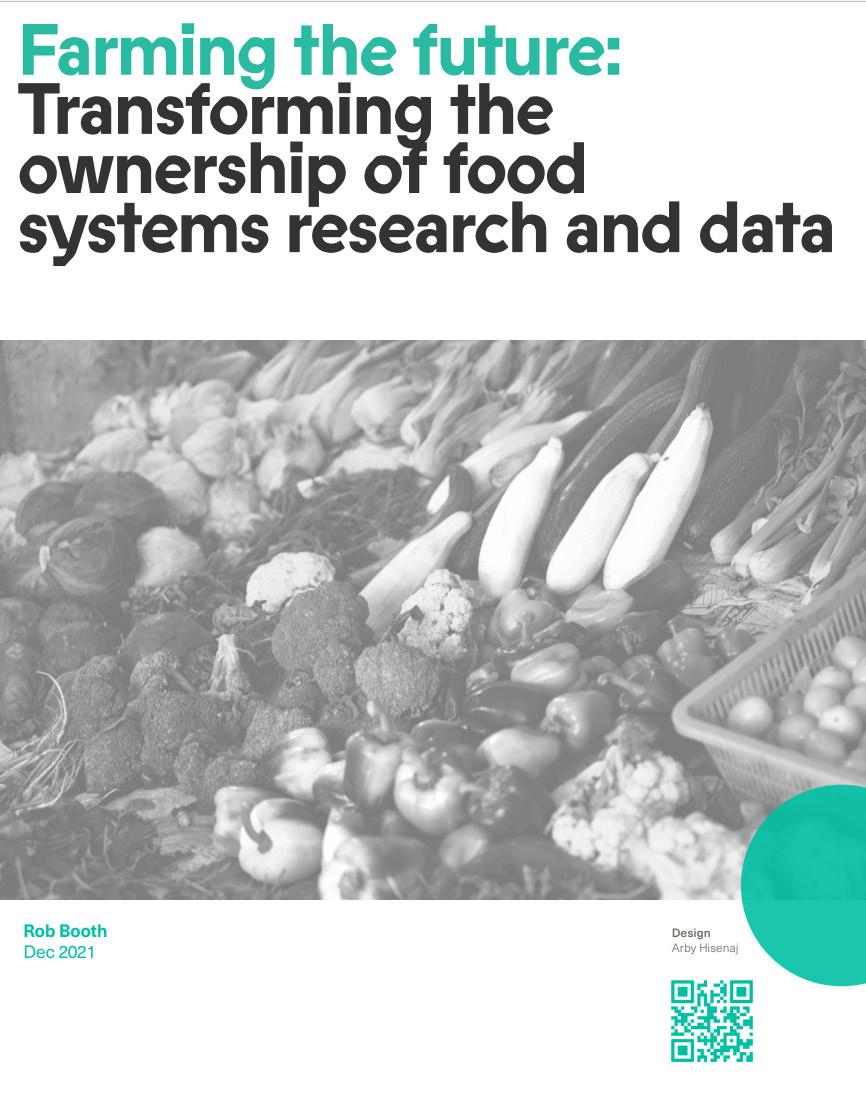
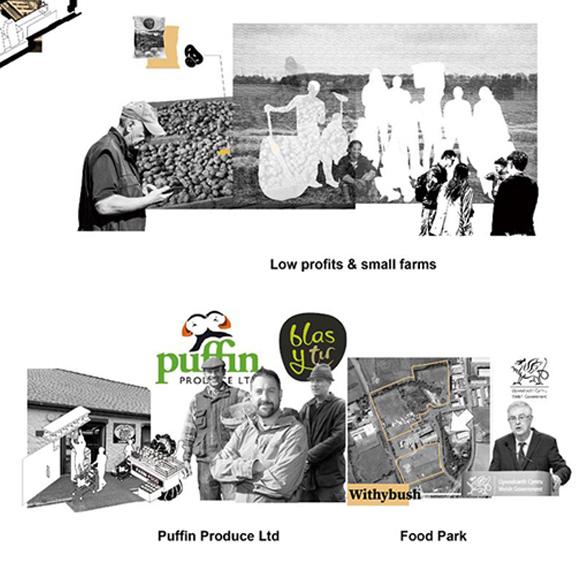
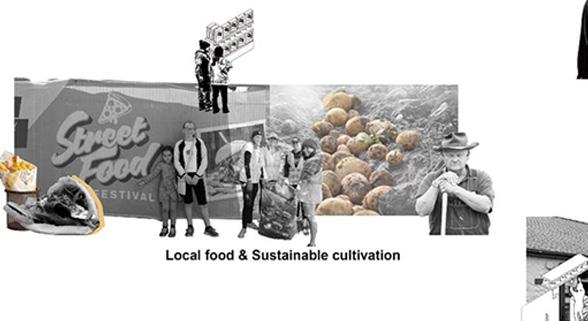
The policies and the main idea of the project draws partly on Farming the Future by Rob Booth.



The site is located on the edge of the urban area of haverfordwest, close to the main transport routes. The site is surrounded by mostly car sales and kitchen furniture shops, with an agricultural machinery shop to the east and a high school to the south east, with which the food park could start a partnership.
A water channel runs into the site.
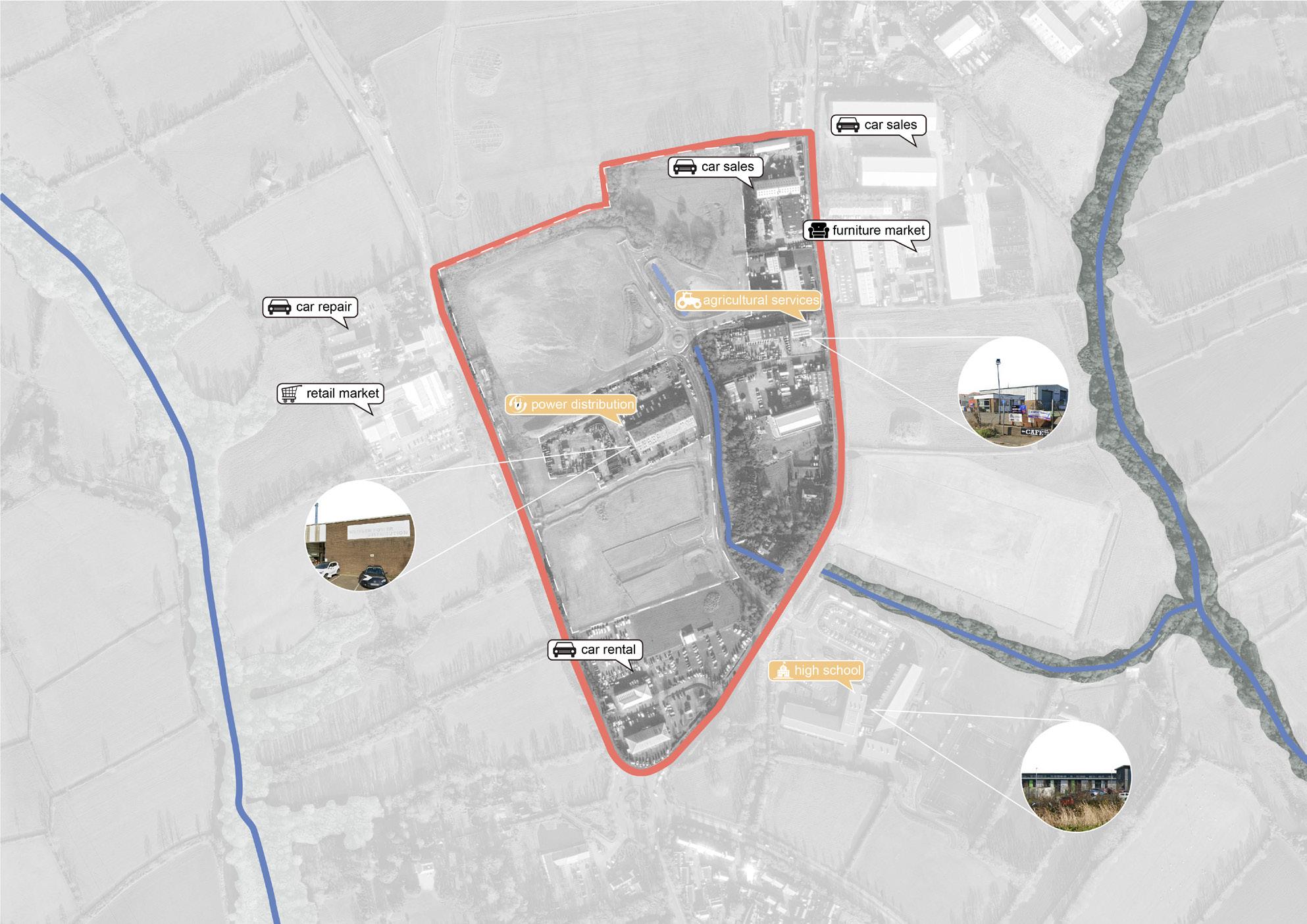
66 67 [5.1 Initial idea of food park] [5.2 Site analysis] Significant monetary investment Low profits & small farms Local food & Sustainable cultivation Puffin
Ltd
Park
Produce
Food
FIG5-1 inspiration of the proposal by Meike Lei
FIG5-3 Farming the future source:
FIG5-4 Site analysis by Meike Lei
FIG5-2 Field to table by Meike Lei
[5.3 Construction process and supporting policies]
The diagram below represents a model of how we envisage (based on preliminary analysis) food park would be built and operated. It includes what facilities are needed, ownership and funding.
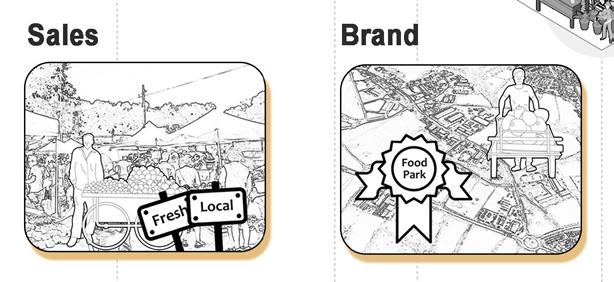

As the main source of funding for the project, processing workshop could be built first in order to allow all farmers, regardless of farm size, to have equitable access to the facilities. If necessary, they can hold discussions prior to the construction and trial operation after completion.
Also to prepare for later construction, temporary market can be set up in the workshop in advance. A policy on information and technology sharing could be implemented then.
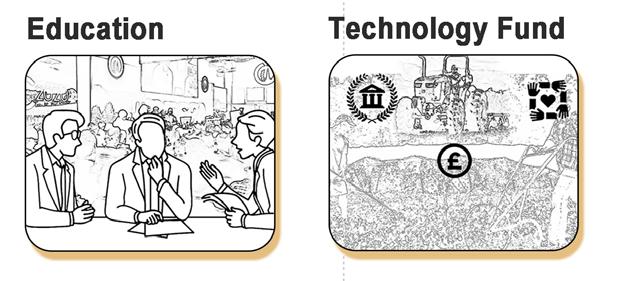
If they presume that expanding distribution channels and scale are needed, then markets and urban hubs can be built , part of the fields might be set up along with the market, they could establish their own brand and make sales locally as much as possible.
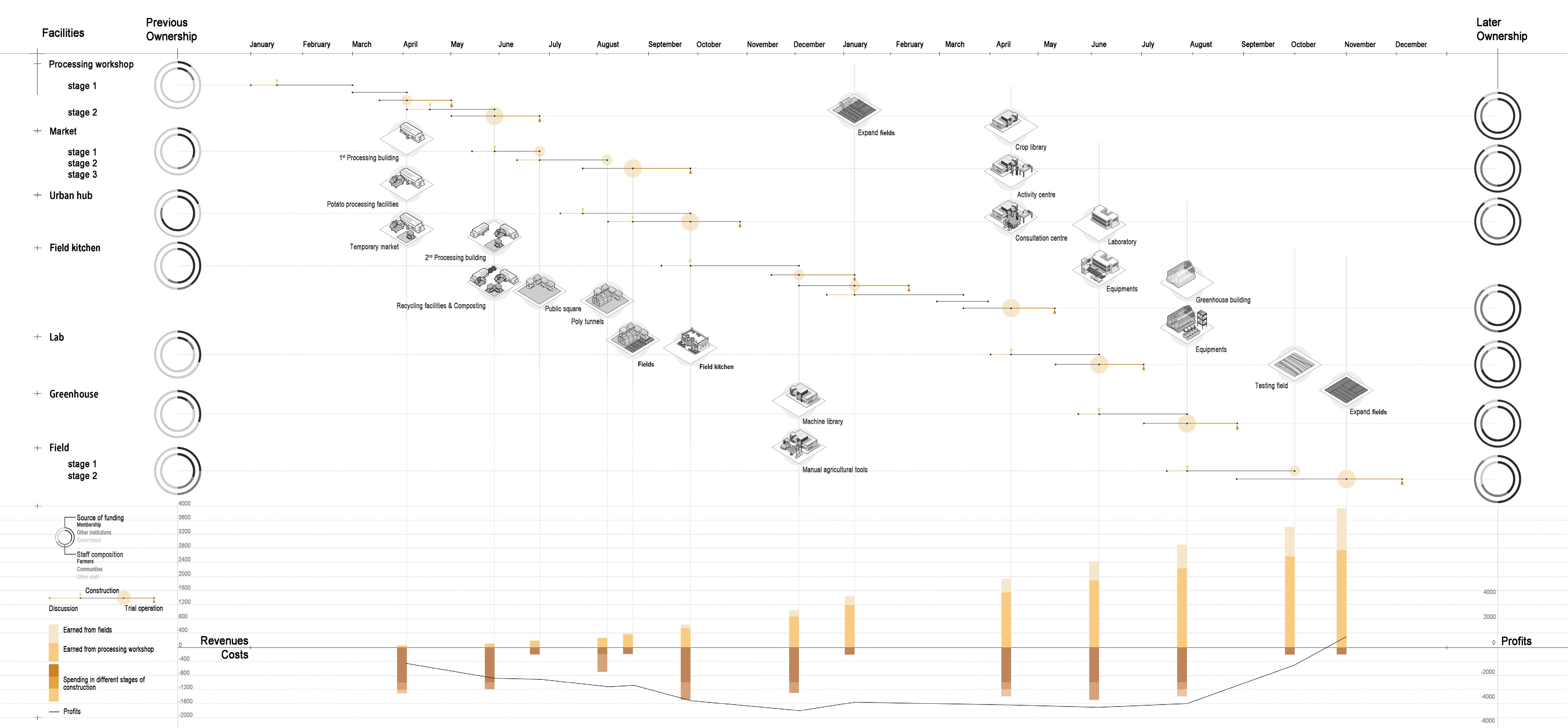
When enough money has been raised, farmers can start building the field kitchen, as well as the further expansion of the field, this will require technical support for sustainable cultivation and appropriate educational policies.

As there is no profit-making function, the laboratory and testing field could be built last.This will not only require the support of relevant experts, but also the transparency of data and information.The fields in the park need to be supported by education and environmental policies.Initially, funds are mainly come from government and organisations, but as it develops, ownership of the park could gradually revert to the members.
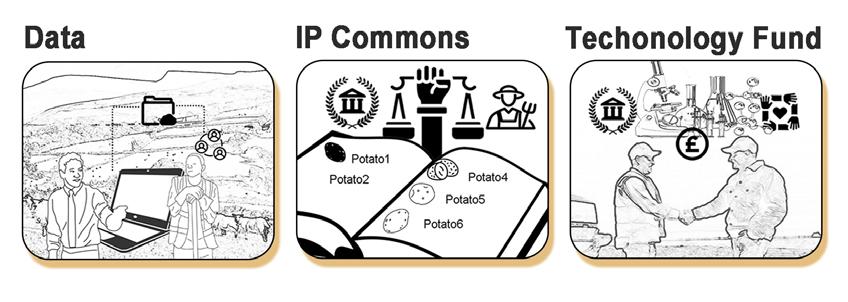
The food park is being built near the Pembrokeshire border to provide facilities for farmers and communities.
To address the lack of technical support, facilities, and labour for small farmers, the local community is assisting in the construction and operation of the food park, with small farmers primarily responsible for learning, using, and growing the park's facilities.
Farmers with large farms can also participate. The project aims to improve the improve the status of small farmers and enrich food culture with local characteristics, as well as to create a more sustainable agricultural landscape.
FIG5-5 Scheduel of management and fundings by Jiamin Hu

[5.4 Plan
1 2 2 3 3 4 5 6 7
of food park]
1 Processing workshop
2 Farmers market
3 Field kitchen
4 Fields
5 Crop library
6 Test fields
7 Laboratory
This is the plan of the food park with three main entrances, the processing workshop, the field kitchen and the farmers market, all adjacent to the park entrance for the transportation of goods and visitors. Two fields each occupy the north and south ends of the park, the crop library is scattered across one of the fields and the test field is close to the laboratory.
FIG5-6 master plan of food park by Jingru Yang, Meike Lei
[5.5 Reference]
1. Puffinproduce."Puffinproduce."https://www.puffinproduce.com/ our-growers/.
2. Pembrokeshire."Pembrokeshire."https://www.pembrokeshire.gov. uk/
3. Rob Booth, Farming the future:Transforming the ownership of food systems research and data 2021.
4. Pembrokeshire Food Park, Withybush, Haverfordwest."Pembrokeshire Food Park, Withybush, Haverfordwest."https://www.pembrokeshire.gov.uk/property-detail/ pembrokeshire-food-park-withybushhaverfordwest
72 73
DESIGN AND STRATEGIES 06
OBJECTIVES
The specific strategies and designs aim to solve detailed problems in a visualized way. Based on the policy supports and master plan, theories related to farming and community are put into practice in scenarios and sections, laying a solid foundation for the implement of the project.
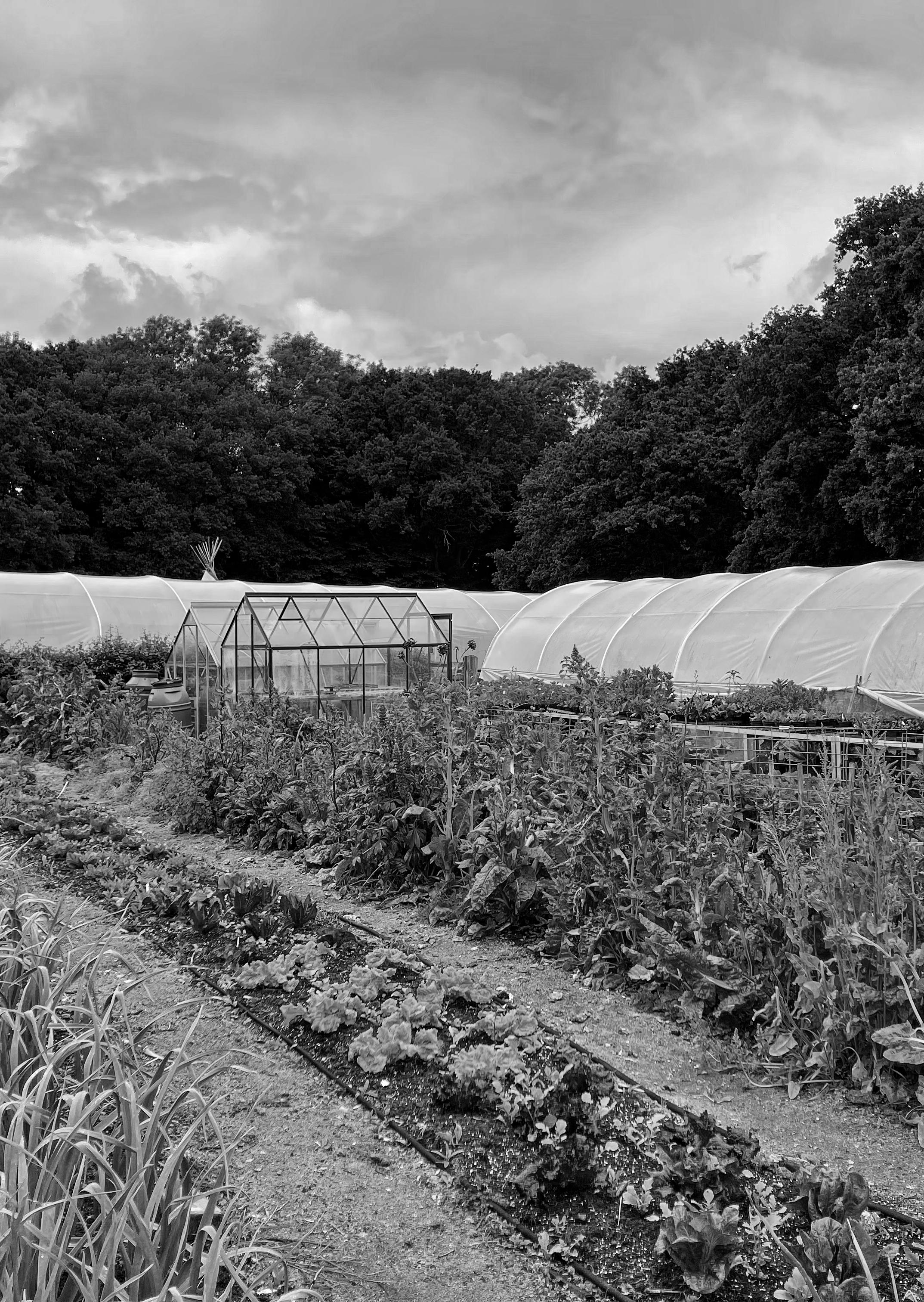
CONCLUSIONS
In this way, small farmers will have access to equipment they previously lacked or could not afford, and will be able to effectively understand the condition of the soil, and the larger farmers involved will be able to place greater emphasis on sustainable production methods. The surrounding community has access to a wide range of fresh food and delicious, nutritious dishes. Consumers' diets become richer and a new food culture slowly grows.
75
[6.1 Manual and policy on facilities]
To combine designs and stratgies with existing policy supports, we divide them into four types of categories. In this way, each kind of policies could match well with facilities and activities, as well as its operating its methods. The processing workshop, laboratory, library and field kitchen are the three main representative architecture in our food park.
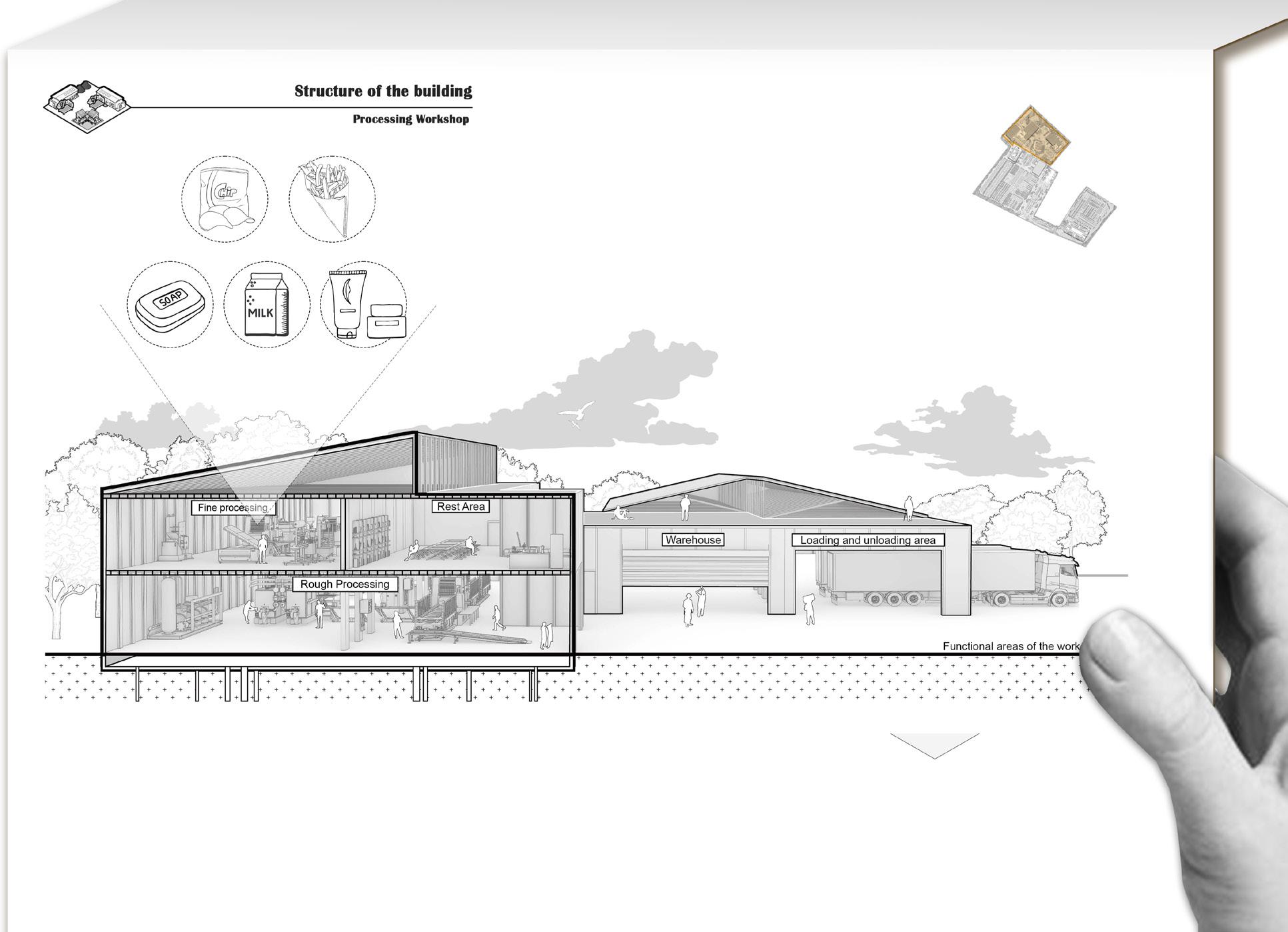
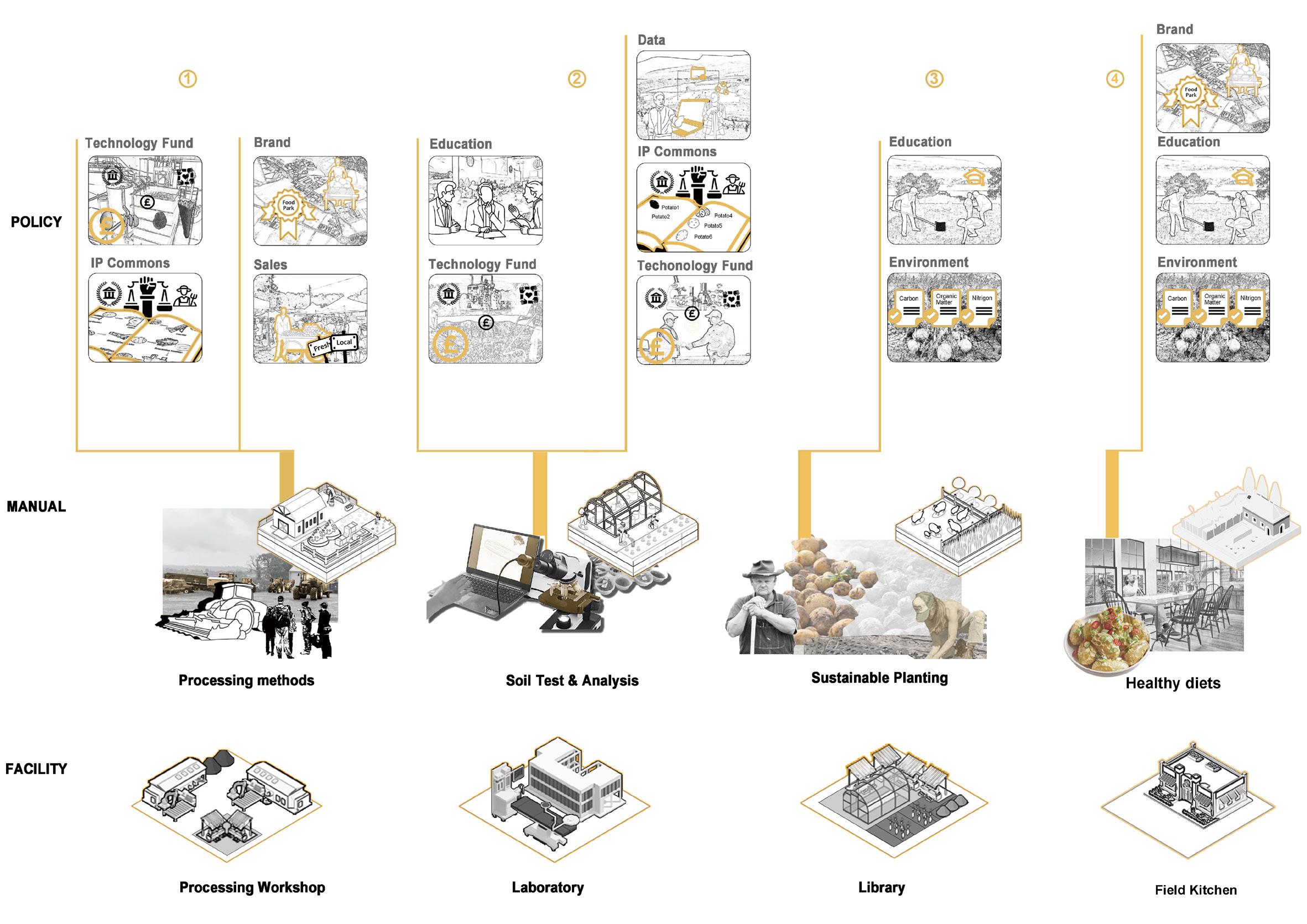
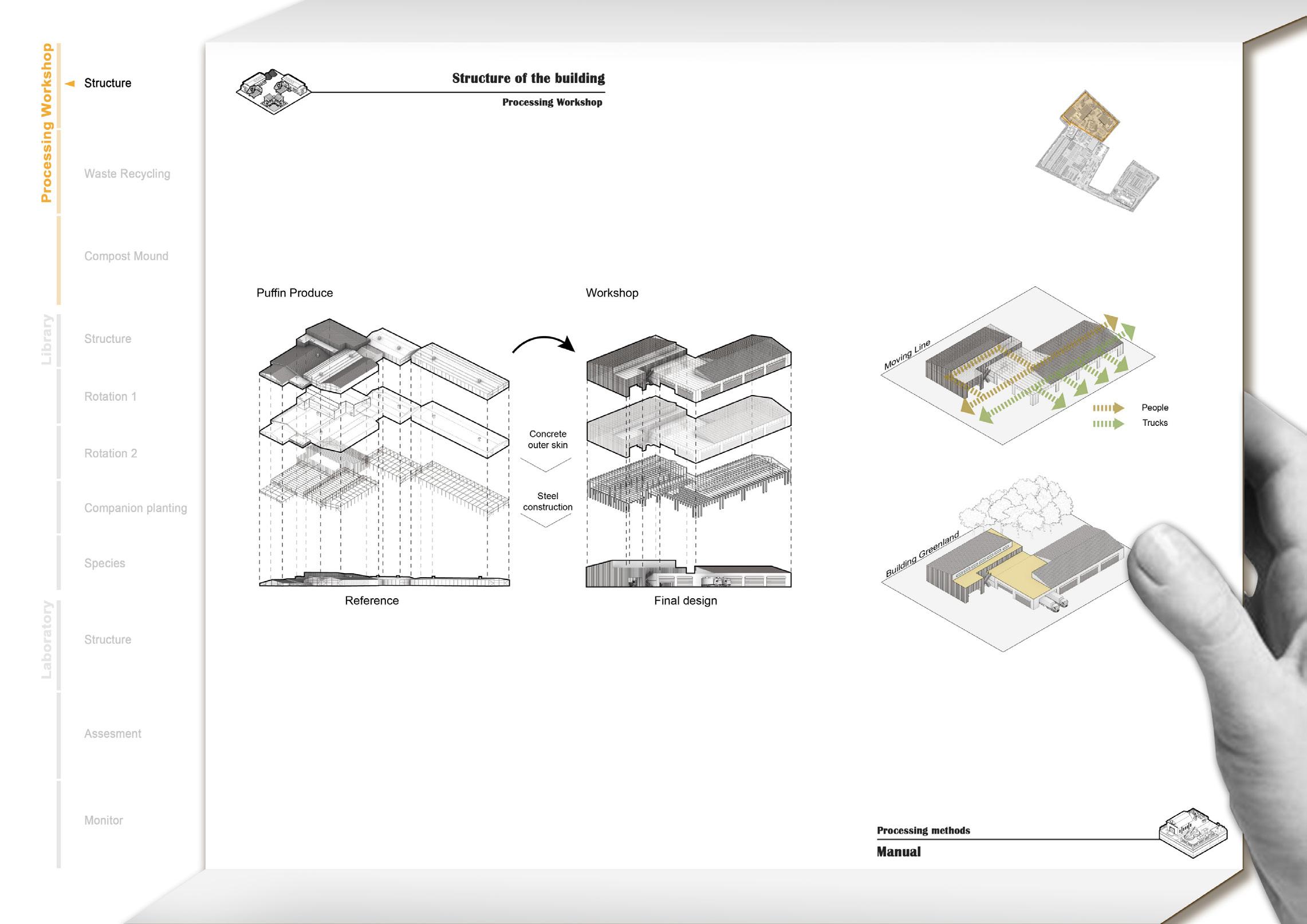
[6.2 Processing workshop]
The structure of the processing workshop is based on the local factory Puffin Produce. The processing workshop also acts as a gift shop where, in addition to processed potatoes such as chips, customers can also buy potato soap, potato milk and potato beauty products. In the future, there is the possibility of opening the workshop for young people to experience making processed potato products.
76
FIG6-1 policies, Manual and corresponding facilities by Jiamin Hu, Jingru Yang
FIG6-2 structures of processing workshop by Chenxu Chen
6.2.1 Structure 6.2.2 Function
FIG6-3 functions of processing workshop by Chenxu Chen
6.3.1 Structure
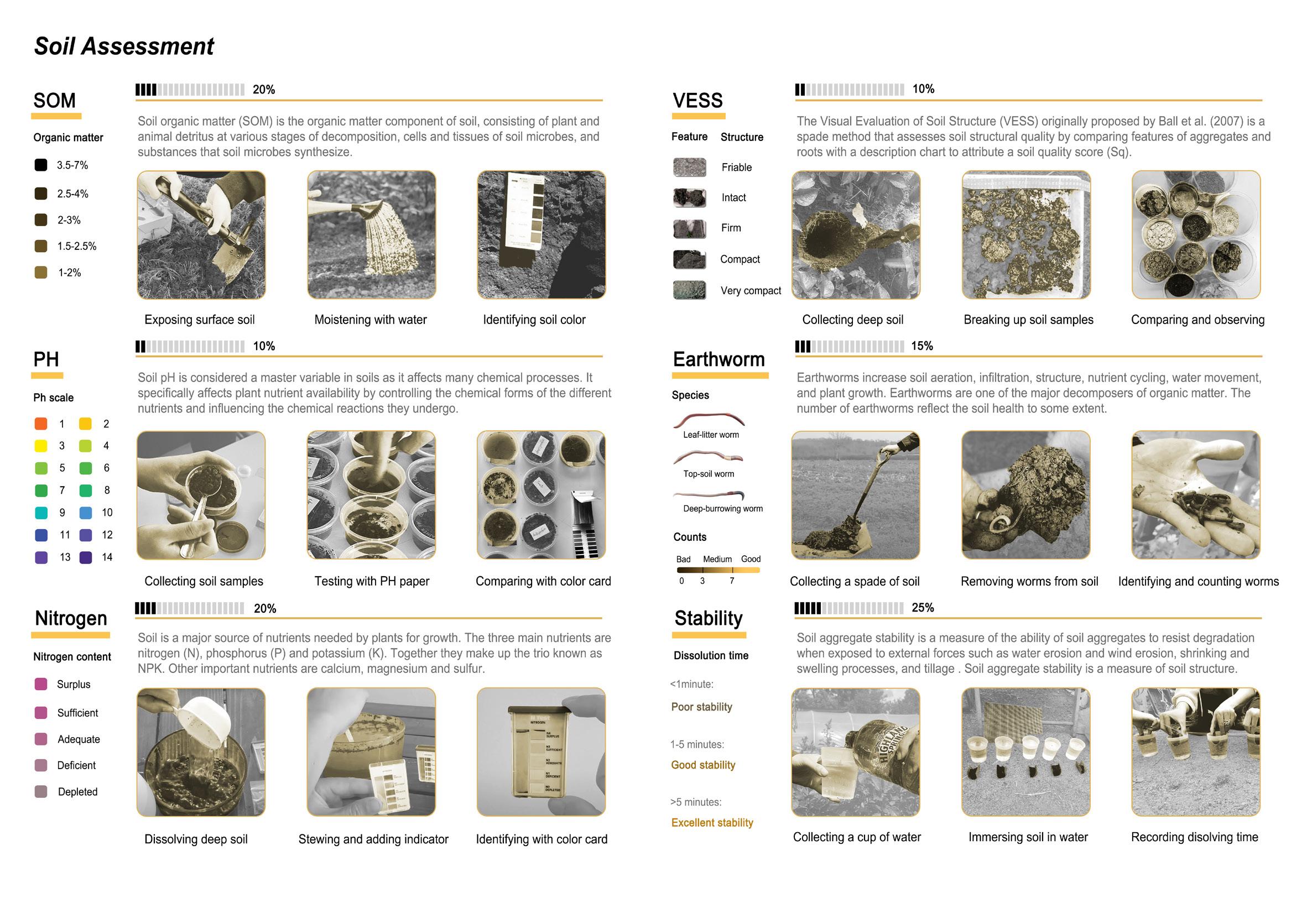
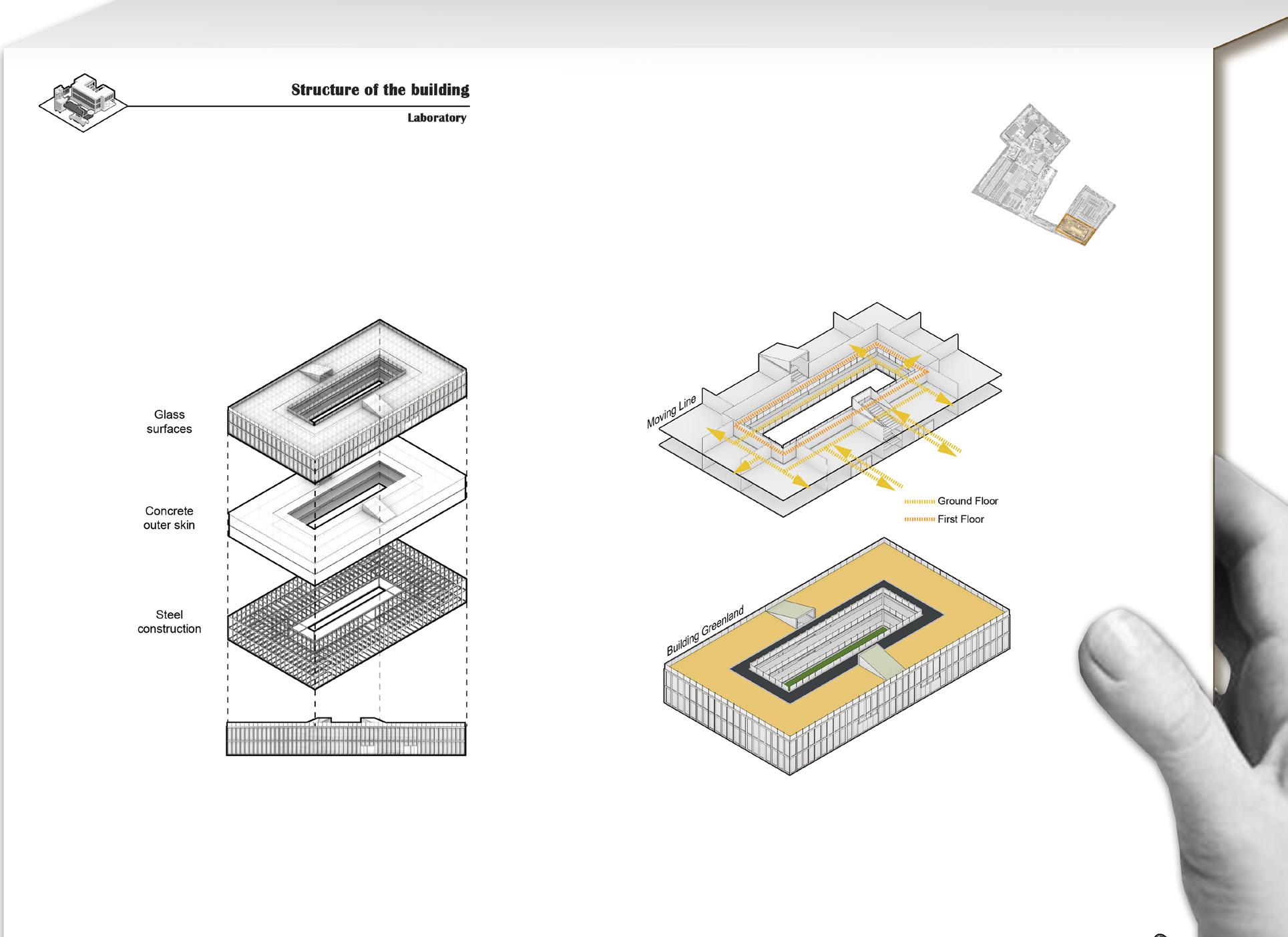
The structure of the processing workshop is based on the local factory Puffin Produce. The processing workshop also acts as a gift shop where, in addition to processed potatoes such as chips, customers can also buy potato soap, potato milk and potato beauty products. In the future, there is the possibility of opening the workshop for young people to experience making processed potato products.
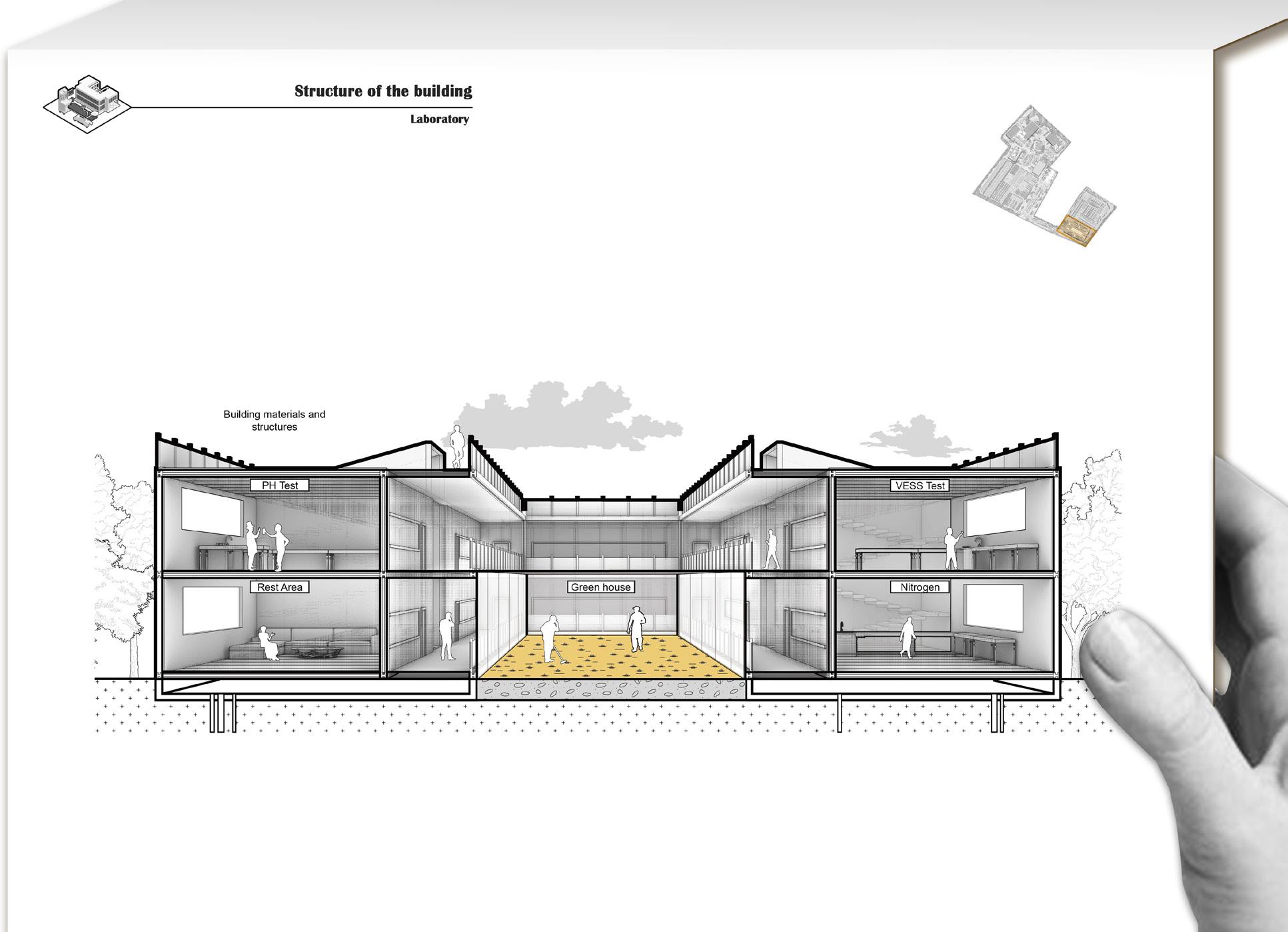
6.3.2 Function
There are mainly six criteria for farmers to assess soil quality, which are soil organic matter(SOM), visual evaluation of sol structure(VESS), potential of hydrogen(PH), earthworm counts, nitrogen measurement, and stability experiment. The six assessment methods doesn't require too much expertise, which is friendly to farmers and visitors. So visitors can take soil from both fields for testing and compare the results to get a better idea of the damage done to the soil by industrial farming methods.
These are microscopic observations of industrial and organic soils. As you can see, the industrial potato fields are less vibrant, you can hardly find fungi and organicmatters in the industrial soil.



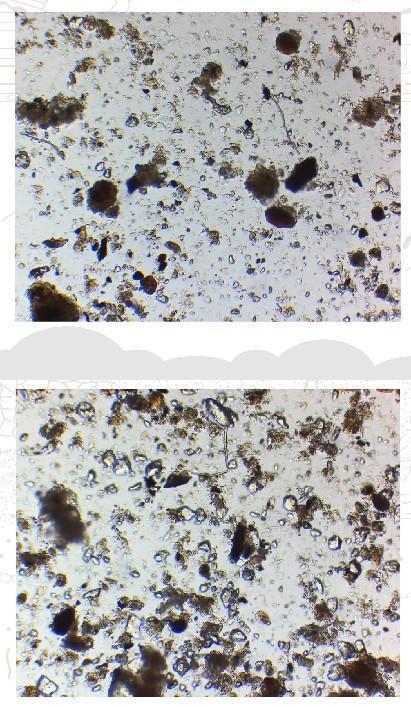
78 [6.3 Laboratory]
FIG6-4 structures of laboratory by Chenxu Chen
FIG6-5 functions of laboratory by Chenxu Chen
FIG6-6 soil assessment by Meike Lei, Yihan Gu
FIG6-7 microscopic soil observations by Team
[6.4 Field kitchen]
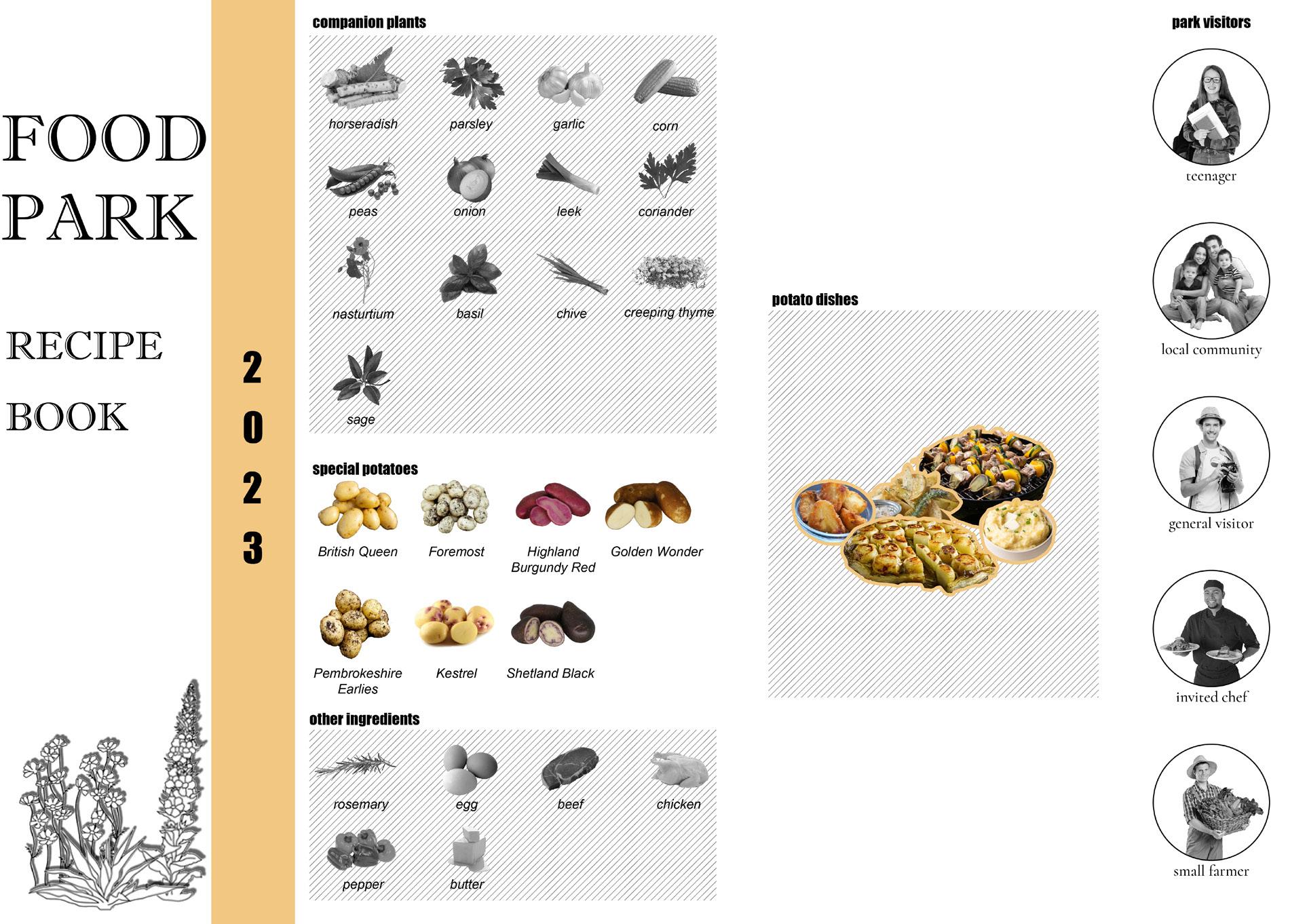
The field kitchen consists of two parts, the building on the left is mainly open to children and the building on the right is more like a restaurant.
It is in partnership with the high school on the south east side of the site and children can regularly learn how to cook healthy and tasty dishes with ingredients from the crops grown in the food park. They can also grow and learn about crops in the indoor garden. The first floor is a place for kitchen enthusiasts to work on new recipes using crops from the park.
The building in the right side welcomes visitors to sample creative and amazing potato dishes and also invites chefs and surrounding residents to host food festivals on the premises. A prominent part of the first floor is a great viewing platform, and downstairs is a walking corridor along the small lake. There are also recycled tyres from the surrounding car sales as containers for growing potatoes.
The role of field kitchen is to connect the farm to the table, to enrich the community's table with companion plants and a wide variety of potatoes, to inspire young people to take an interest in farming, to feed the small farmers who farm at food park and to shape a unique and living Pembrokeshire food culture.
 FIG6-8 field kitchen section by Meike Lei
FIG6-9 food park recipe book by Meike Lei
FIG6-8 field kitchen section by Meike Lei
FIG6-9 food park recipe book by Meike Lei
At least 7 types of potatoes are grown in the fields. They have different needs for soil and sunshine, so it's necessary to create the right growing environment for each species. First I had farmland, next, put in windbreaks and buildings, which provided shade. Then there are swales ditches along the contours which, together with the water channels on the site, make the soil nearby more moist. Finally, the whole field is divided into shaded, full sun, wet and dry zones and potatoes are located in right zones.
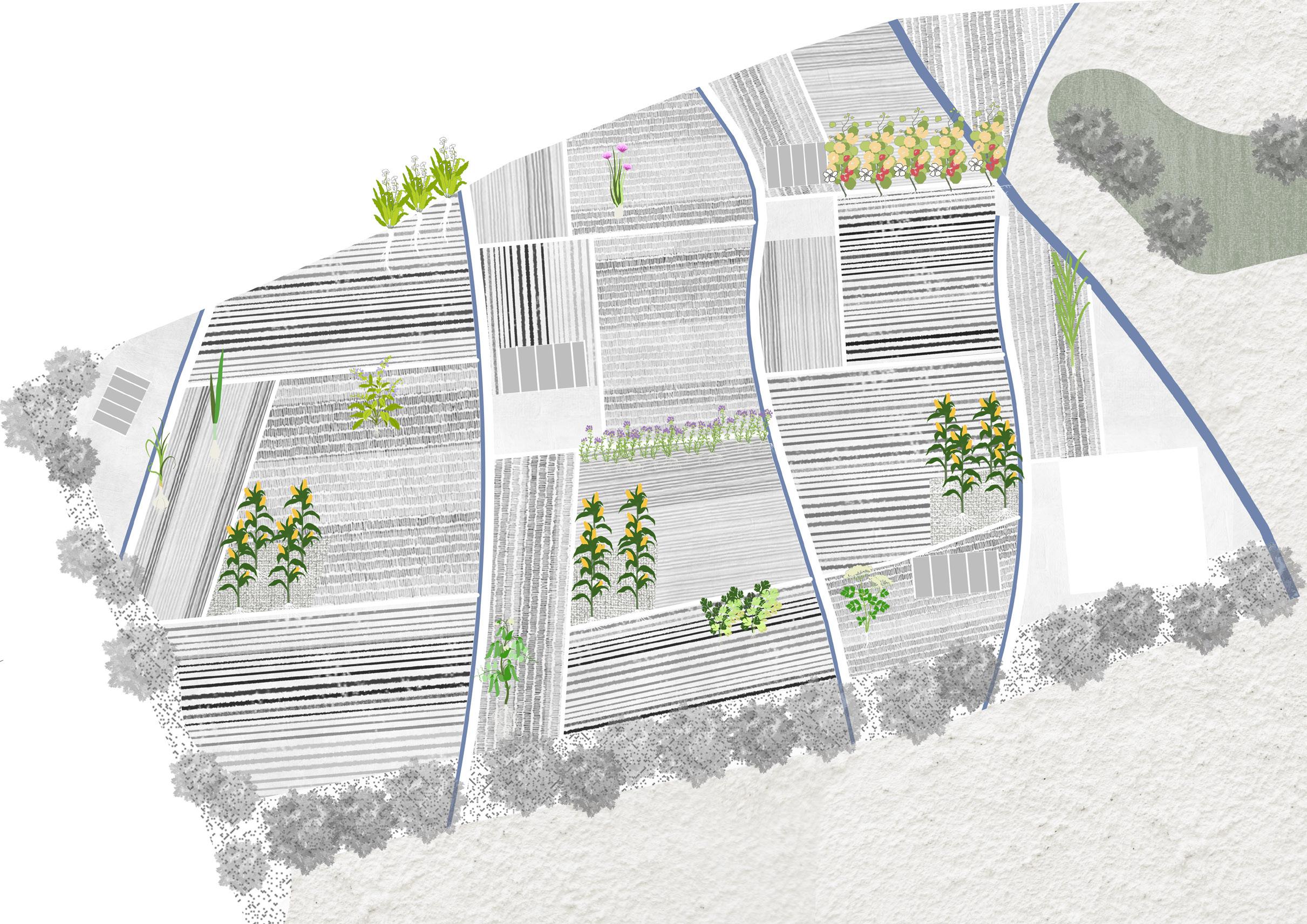
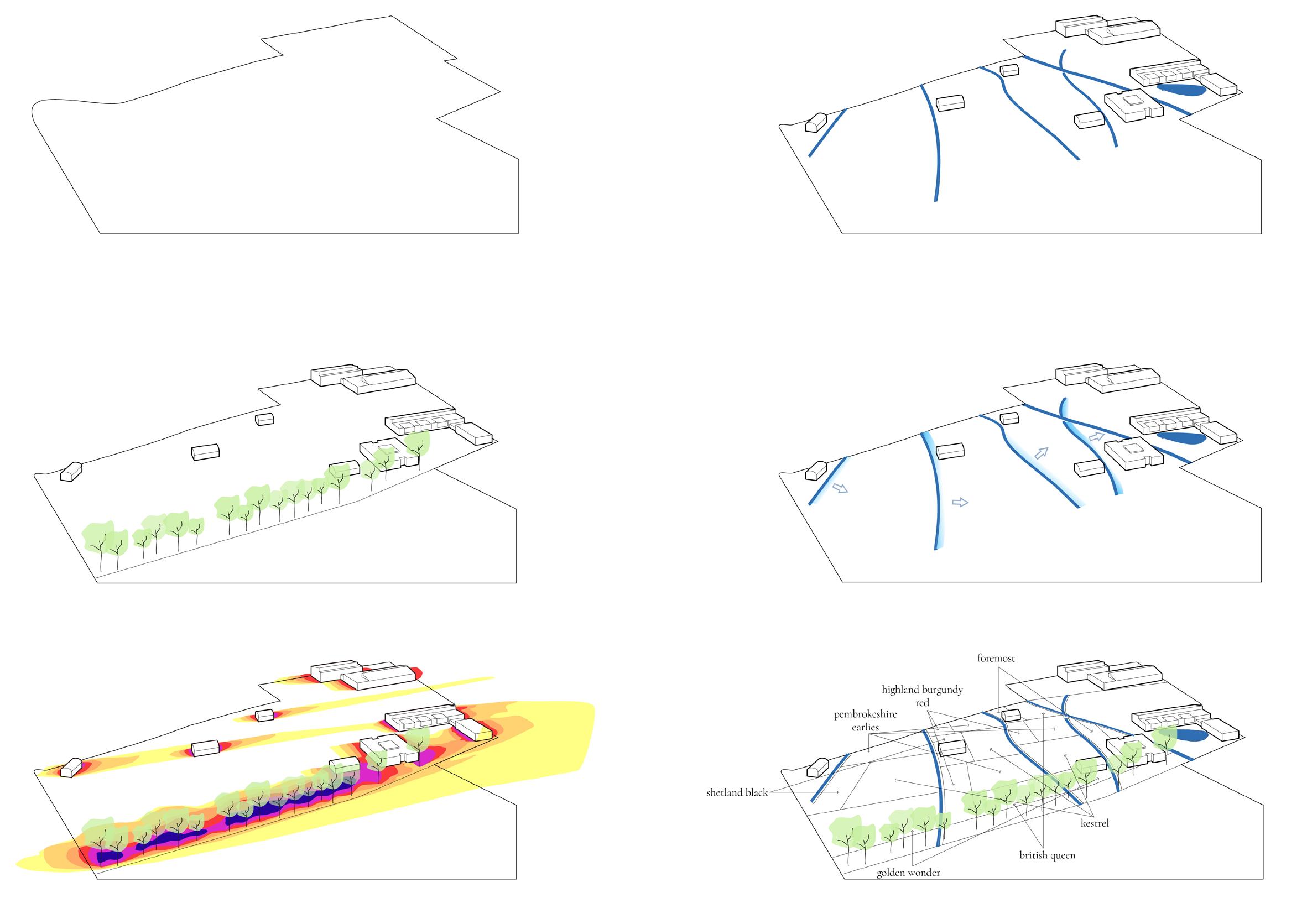
6.5.2 Companion plants
Likewise, consider the growing needs of the companion plants and decide on the combination of companion plants and potatoes, taking into account the culinary characteristics of each variety of potato.
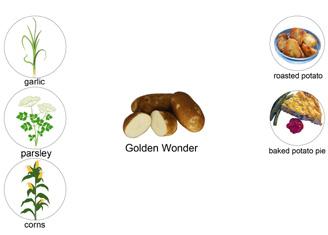

These are schemes of companion plants and potatoes, which are grown in different plots and are cooked together to make a delicious potato dish. So each potato field can produce a unique potato dish.
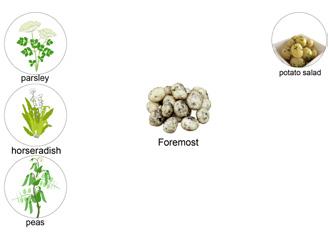

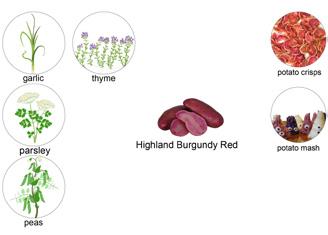
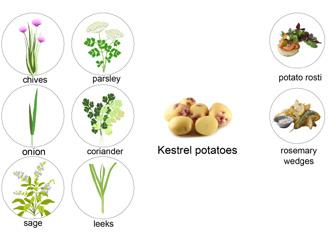
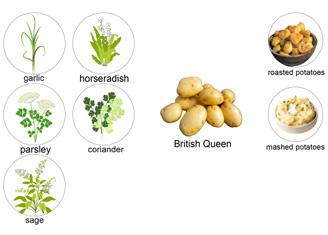
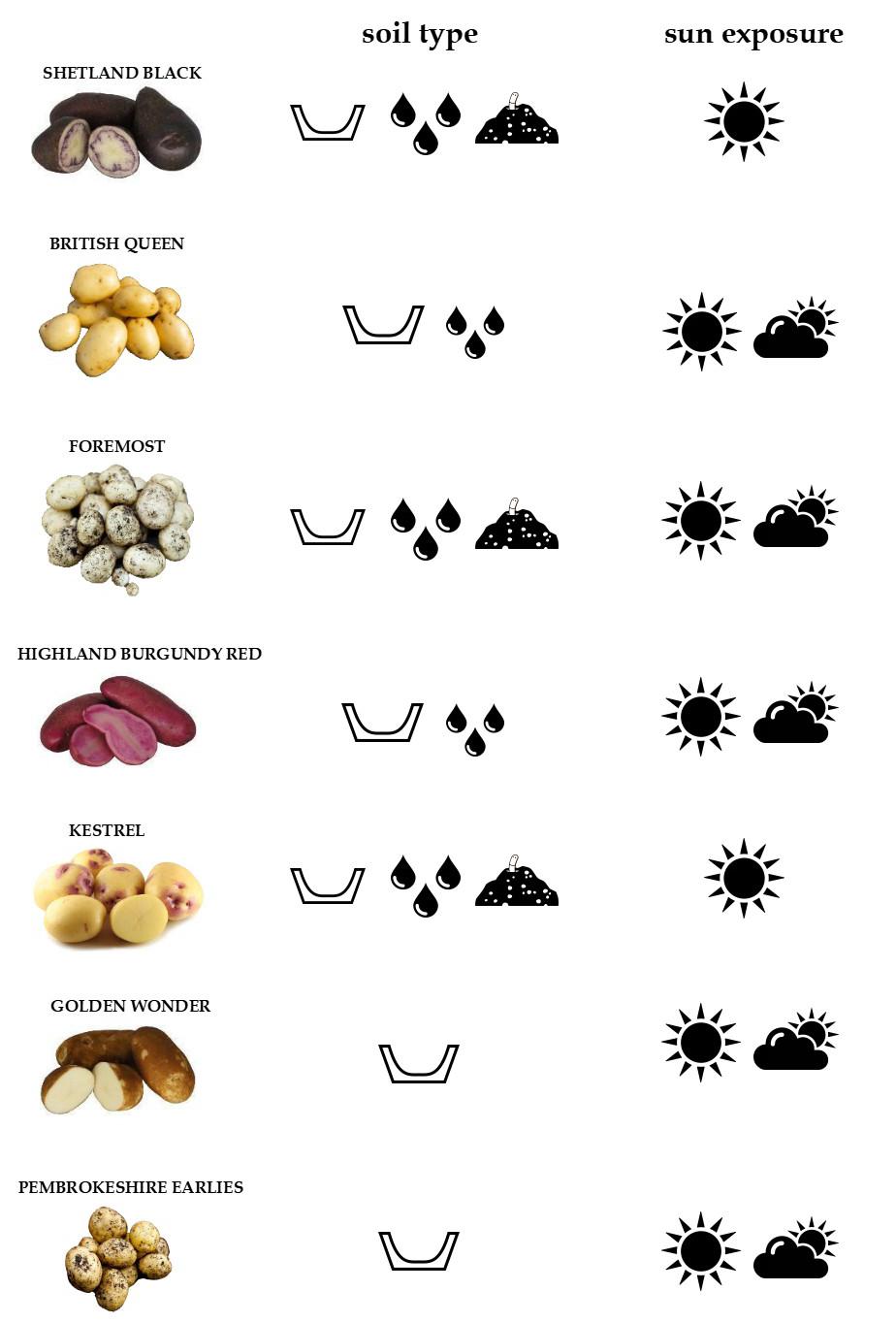

[6.5 Fields] 1 4 2 5 3 6 6.5.1
Generation
FIG6-10 Fields generation by Meike Lei
FIG6-11 Growing conditions for different potato varieties by Meike Lei
1 4 7 7 7 2 5 3 6 6 6 5 5 5 4 4 3 2 1 1 2 2 3 3 3 3
FIG6-12 companion plants and potatoes allocation by Meike Lei
6.5.3 Seasonal changes
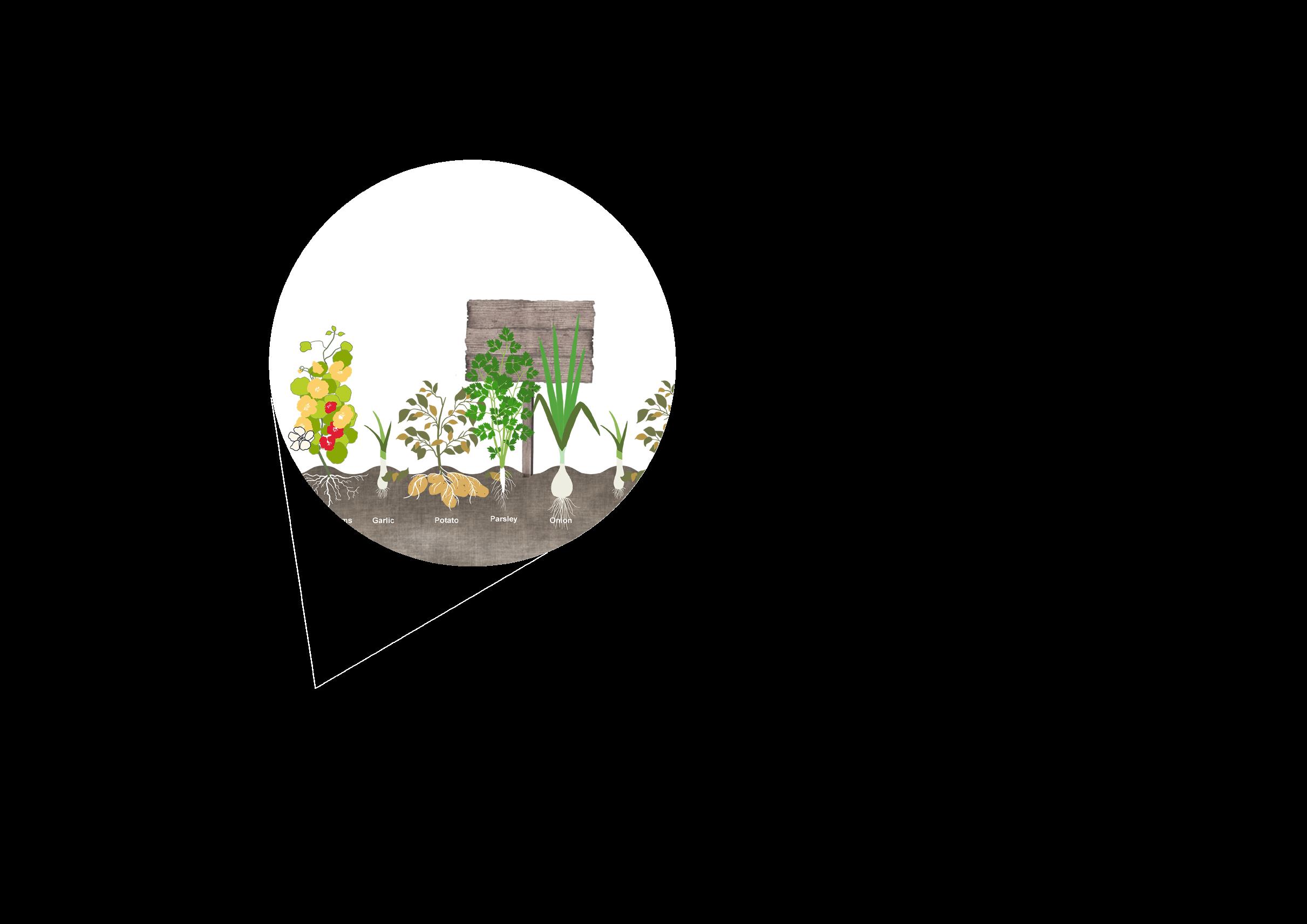
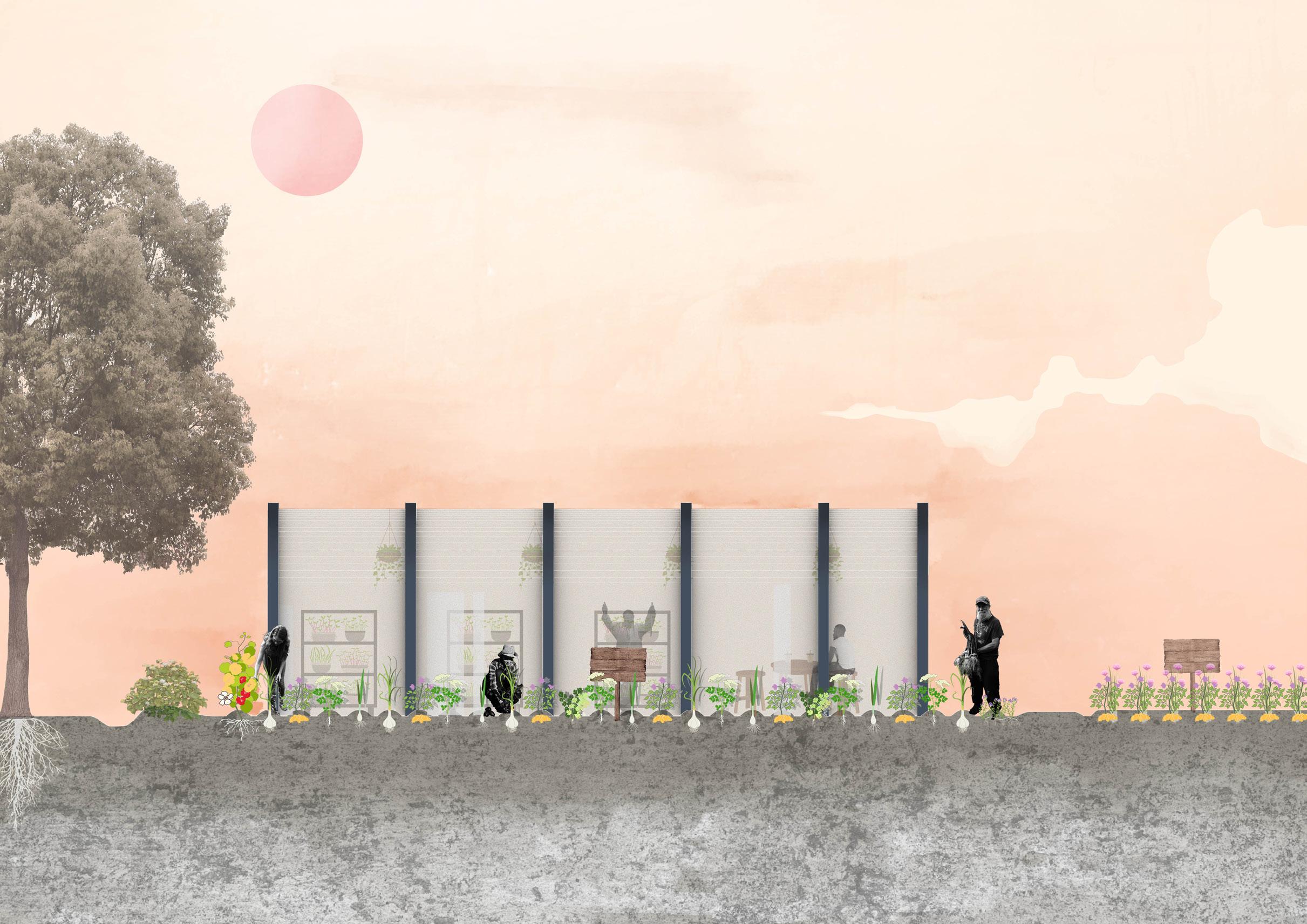

Boxelders and scotch rose act as windbreaks. The bio-swales in the field create an underground reservoir which could attract microorganisms and make the soil more active and fertile. The compost mounds are at the edge of the field.The companion plants act as natural insecticides for the potatoes. Natsurtiums attract insects that are beneficial to the potatoes, basil and parsley dose not compete with the potatoes, garlic and horseradish repel pests. The wood board shows what dishes can be made from the plants in the field.
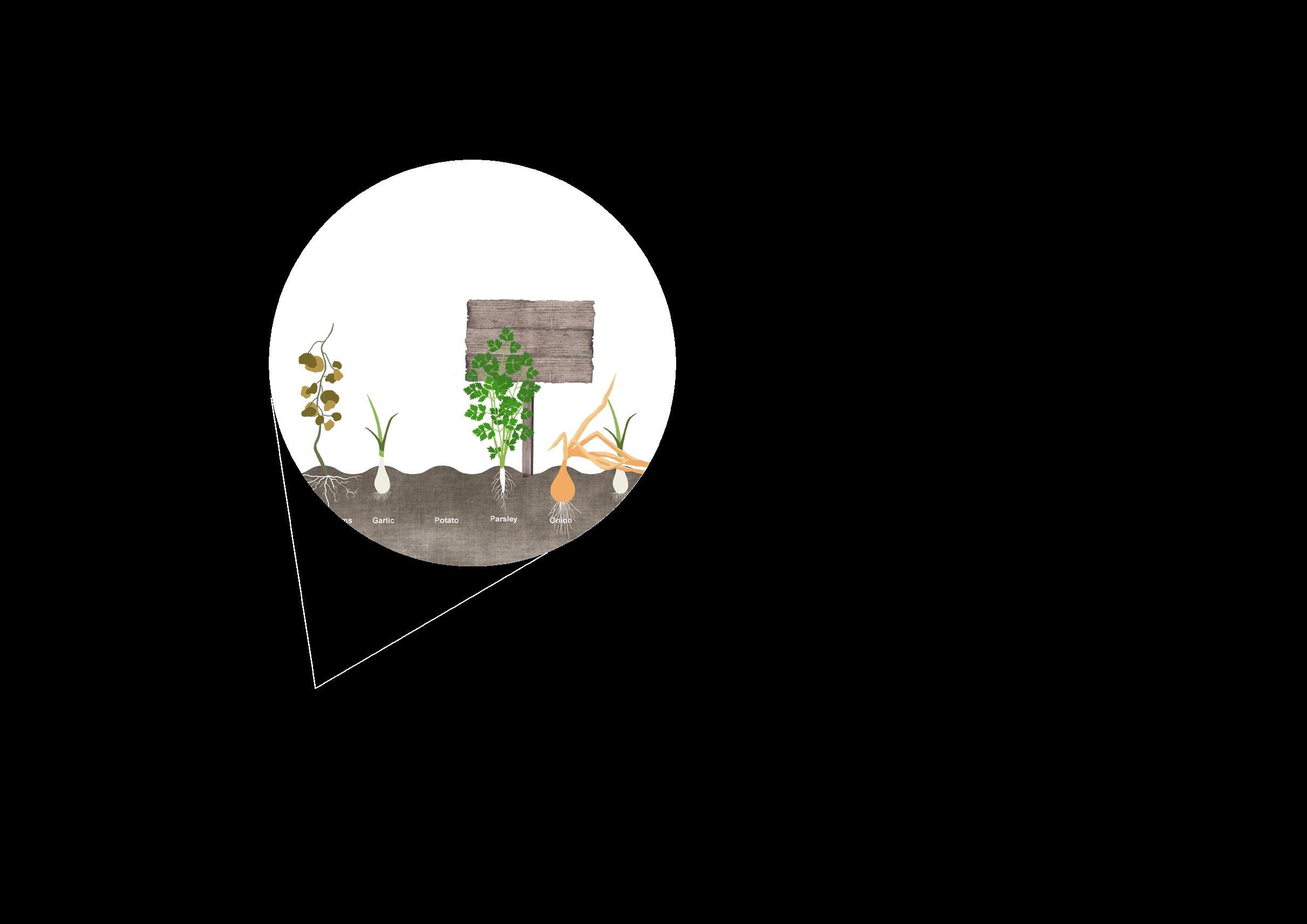
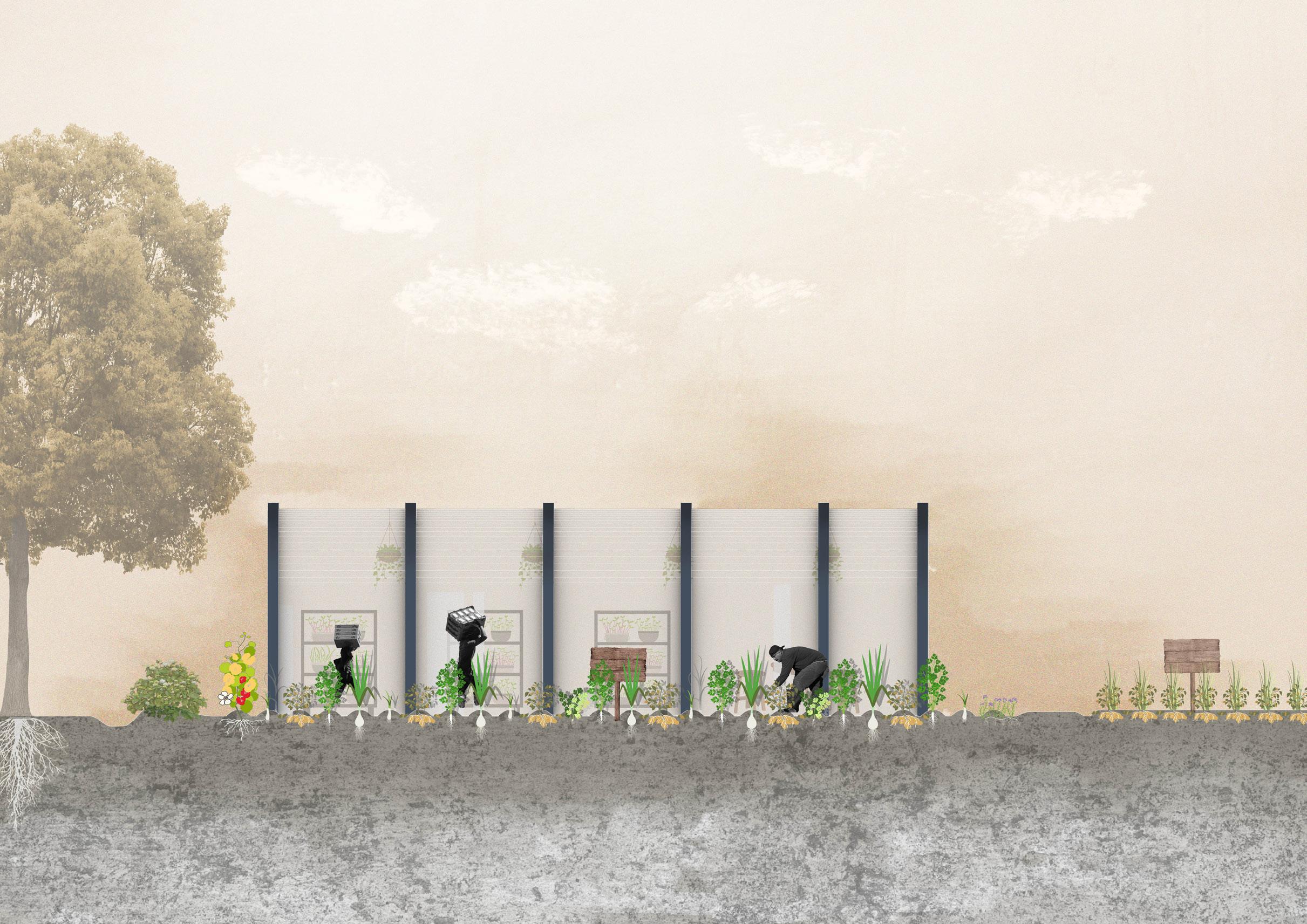

Unlike industrial potato fields where only potatoes are grown, these companion plants make for a lively and colourful farmland landscape that changes with the seasons.
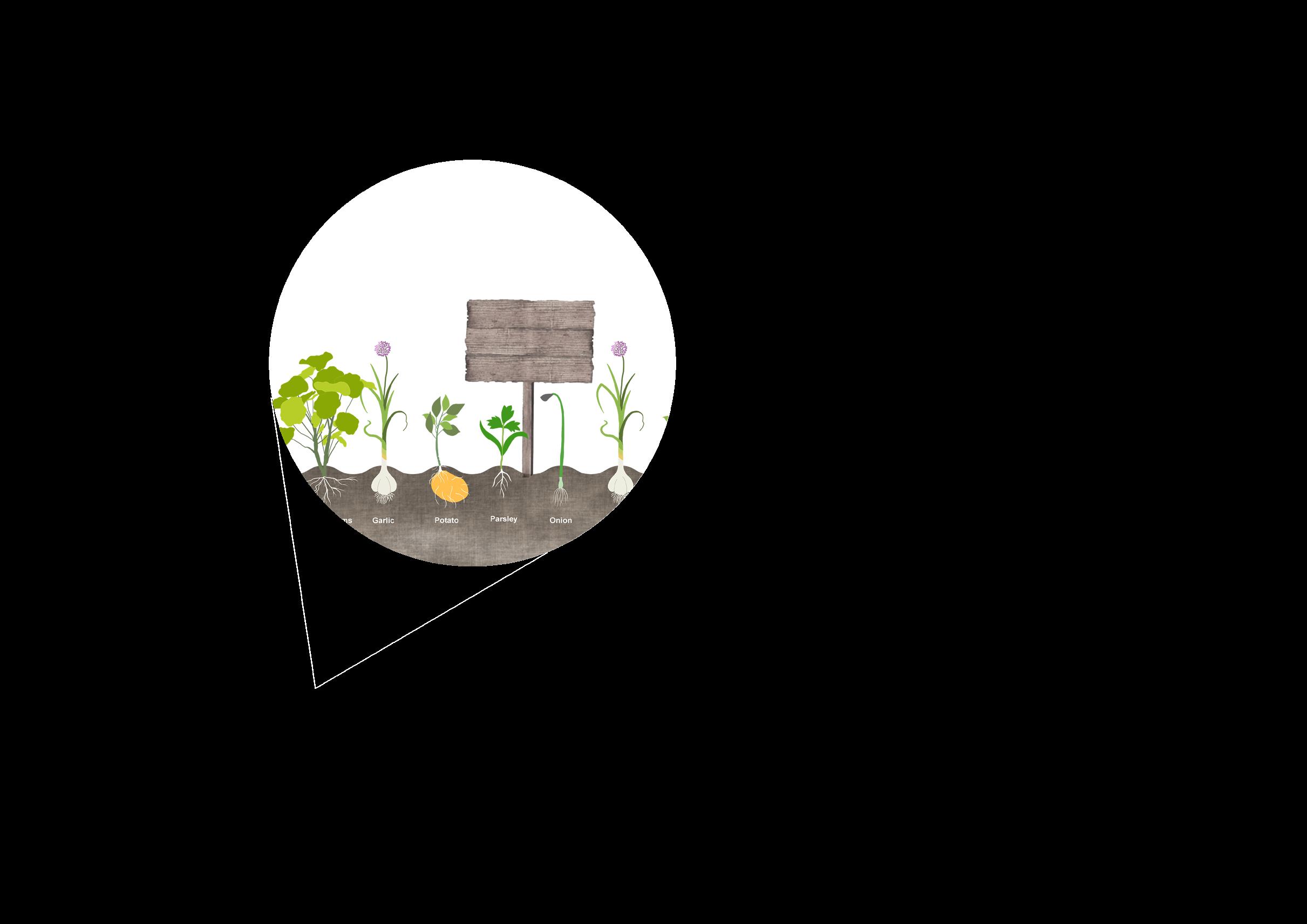 FIG6-13 fields in spring by Meike Lei
FIG6-13 fields in autumn by Meike Lei
FIG6-13 fields in summer by Meike Lei
FIG6-13 fields in spring by Meike Lei
FIG6-13 fields in autumn by Meike Lei
FIG6-13 fields in summer by Meike Lei
in
FIG6-13 fields
winter by Meike Lei
In spring, farmers can use the recycled waste into fertilizer and compost it, in preparation for cultivation in the fields.

During winter, farmers can experiment varieties all year round in the lab and can try out with some other type of planting to enrich local food in the greenhouse.

[6.6
Overview sections]
FIG6-14 overview section in spring by Jiamin Hu
FIG6-14 overview section in winter by Jiamin Hu
In the summer and autumn, the fields and markets would be filled with activities, where different varieties of potatoes can be grown and harvested. In the testing field, farmers are even able to try out other planting methods.

 FIG6-14 overview section in summer by Jiamin Hu
FIG6-14 overview section in autumn by Jiamin Hu
FIG6-14 overview section in summer by Jiamin Hu
FIG6-14 overview section in autumn by Jiamin Hu
FIG6-6 AgEdLibrary, "Understanding Soil Color." June 12, 2022. https://www.senecahs.org/pages/uploaded_files/Soil%20Color%20 E%20Unit.
FIG6-11 Rasa, Tabula. 2022. “Potato – Foremost.” Tabula Rasa. March 13, 2022. https://tabularasa.org.uk/2022/03/13/potato-foremost/.
“Jamieson Brothers.” 2022. Jamieson Brothers. 2022. https:// www.jamiesonbrothers.com/golden-wonder-seed-potatoes.
“Potatoes ‘Golden Wonder.’” n.d. En.edunclub.ru. Accessed January 20, 2023. https://en.edunclub.ru/recipe/60948-potatoesgolden-wonder/.
“Pembrokeshire Early Potatoes - Great British Chefs.” 2015. Www.greatbritishchefs.com. June 25, 2015. https://www. greatbritishchefs.com/features/pembrokeshire-early-potatoes.
Green, Timothy. 2016. “Highland Burgundy Red Potato Crisps.” Morghew Park. August 22, 2016. https://morghew.com/ highland-burgundy-red-potato-crisps/.
FIG6-12 https://www.gardenersworld.com/ https://www.rhs.org.uk/ Hailey, Logan. 2022. “32 Companion Plants to Grow with Potatoes.” All about Gardening. August 22, 2022. https://www. allaboutgardening.com/potato-companion-plants/.
90 91 [6.7 Reference]
FUTURE VISIONS 07
OBJECTIVES
This chapter is a vision for the future development of the food park and needs to consider the impact of the food park on farmers, communities, changes to the food system, landscape and how the food park could be extended to other areas in the future.
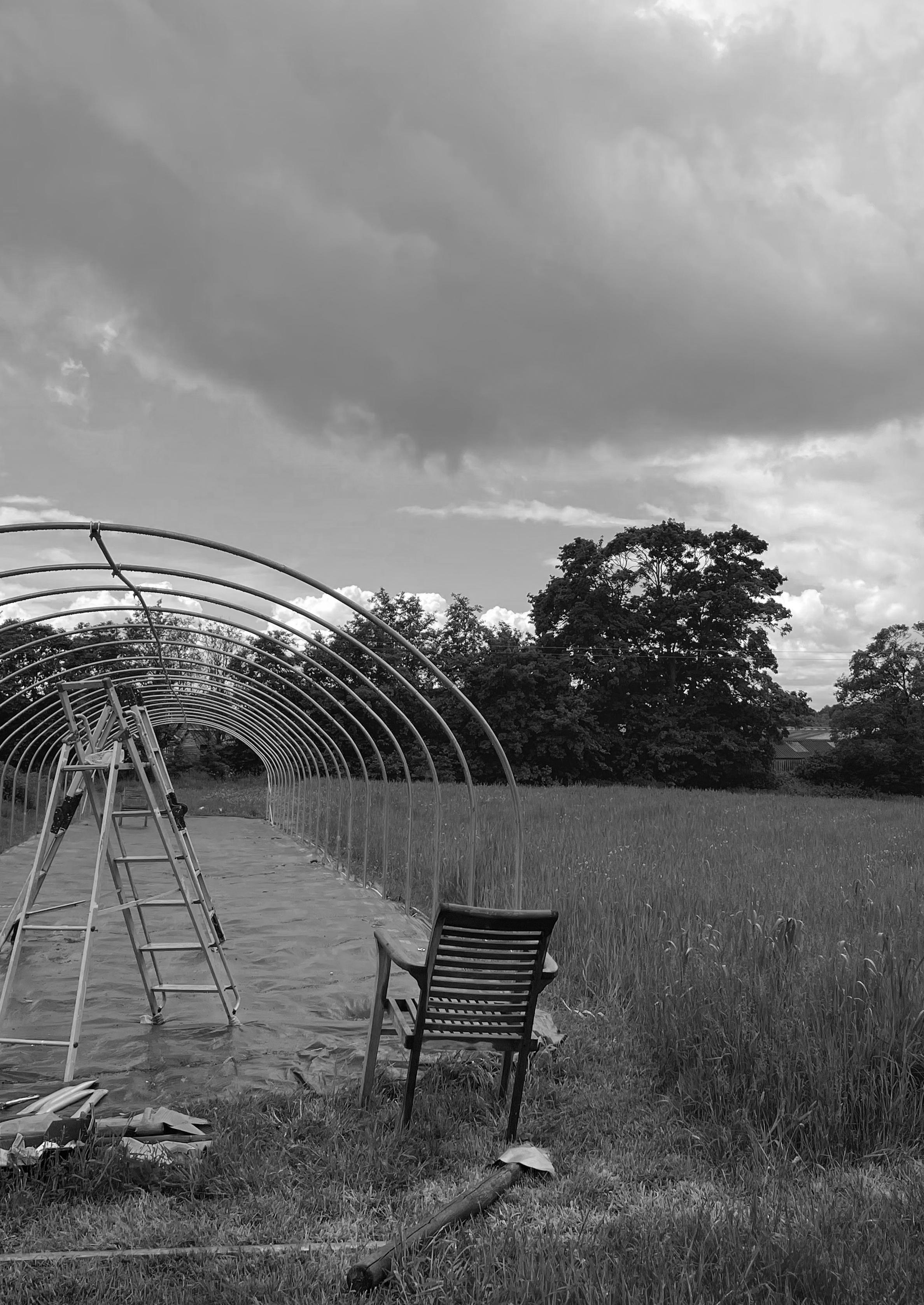
CONCLUSIONS
A food park can become a food hub for a region. For small farmers, food parks are places that provide them with equipment, technology and help with trade; for consumers, food parks are places to visit and places to meet, taste and buy new foods. In the future, food parks will be a source of influence to change the farm landscape and regional food culture, gradually expanding across the country.
93
new complementary food system]
Rather than replacing supermarkets, food parks provide an additional trading channel for both farmers and consumers, giving them the opportunity to trade away from the control of giant food companies. This model also shortens the production chain and small farmers can make higher profits from a shorter production chain.
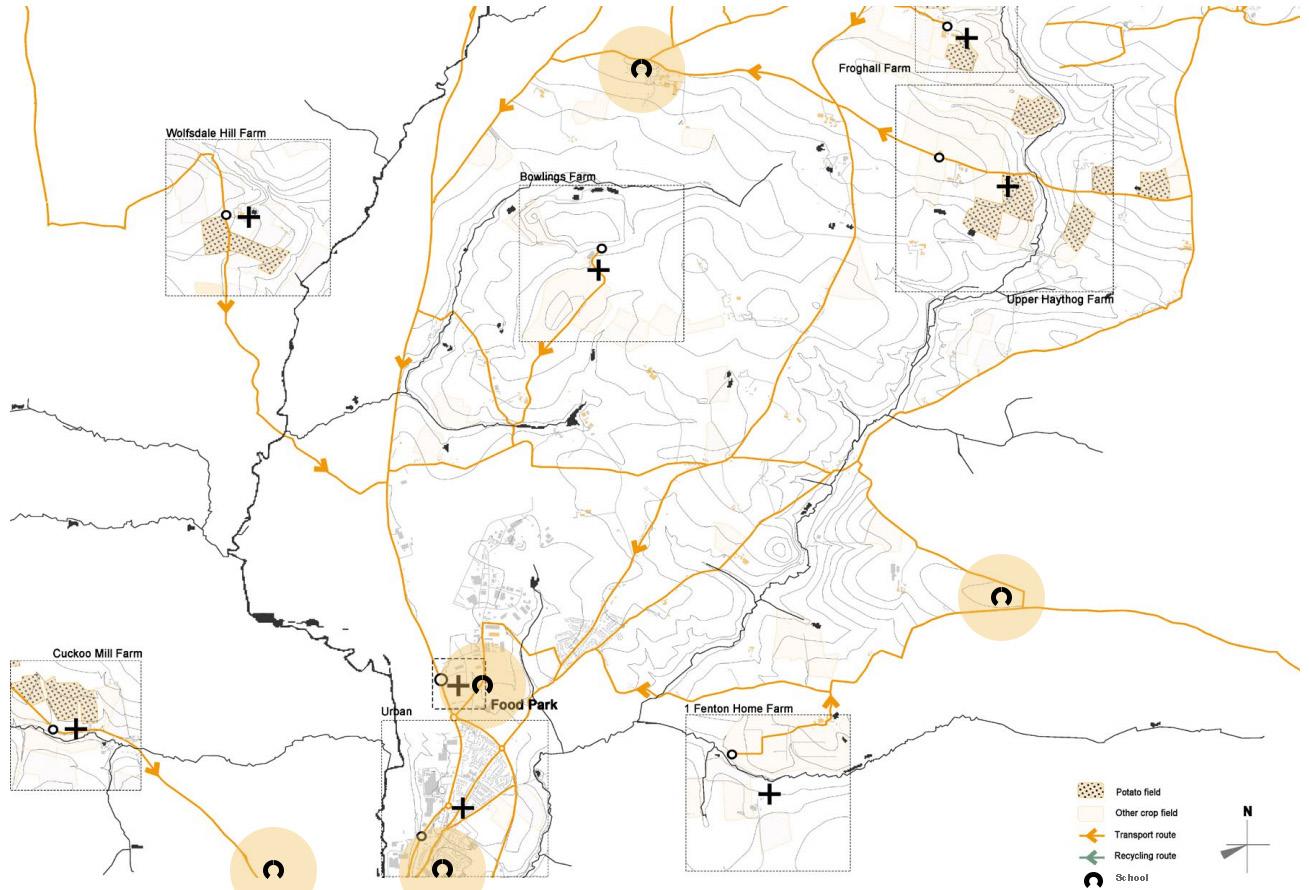

[7.2 Regional influences]
The Food Park has a regional reach, building a network of partnerships with surrounding farms to process and sell their potatoes; it is also a kitchen and market for the surrounding community, gradually changing local eating habits; and it has partnerships with schools where young people learn to grow crops and prepare healthy and innovative food.
94 95 [7.1
A
FIG 7-1 a new complementary food system by Jingru Yang
FIG 7-2 regional influences of food park by Jiamin Hu
The Food Park will be rolled out gradually across the UK, starting with Pembrokeshire. Firstly, within Pembrokeshire, the Food Park will link up with more farms and increase local sales through hubs in urban areas.
Land use rights can be rationalised once more with the support of more organisations, institutions, farms, and government policies.
Farmers also have more control over production and marketing channels and are no longer forced to sell their products to supermarkets. Land can also be reformed.
Farmers have more channels through which to communicate with one another and receive cutting-edge information and equipment. Local food culture can also be promoted, and the local economy can be improved to some extent.
Food Culture
In this stage, new food parks with different components could be built in different regions of Wales, if enough funds and support were provided. Also, their own brand would be started with the help from the constructed ones.


The sharing of benefits with other food parks, the promotion of various local food cultures in various regions, the exchange of local food cultures between different regions, the improvement of regional ties, the steady emergence of more diverse local brands, and the better promotion of local cultures.
During the final scale there might be more food parks established across the country, accompanied by unique local food culture. Local, affordable food is no longer limited to distribution in rural regions. Local retailers are gradually establishing themselves in the closer-transported sales channels between cities and villages, with farmers speaking for a greater concern for the soil environment and sustainable farming methods. Local food cultures are also being exchanged and integrated more, representing various regional lifestyles and gradually enhancing the environment.

96 97 [7.3 Promotion]
Brand Mutual Aid System United Kingdom
Pembrokeshire Reform Land Land Use & Property Sales Locally Wales
FIG 7-3 promotional process in Pembrokeshire by Jiamin Hu
FIG 7-4 promotional process in Wales by Jiamin Hu
FIG 7-5 promotional process in UK by Jiamin Hu
Food chains controlled by corporations rob farmers and confine producers and consumers alike to narrow boxes, witnessing the flattening of food culture. Food parks connect the field to the table, uniting farmers and consumers and returning their food sovereignty. And, by implementing sustainable farming and promoting creative food, food parks will gradually change the local landscape and food culture.
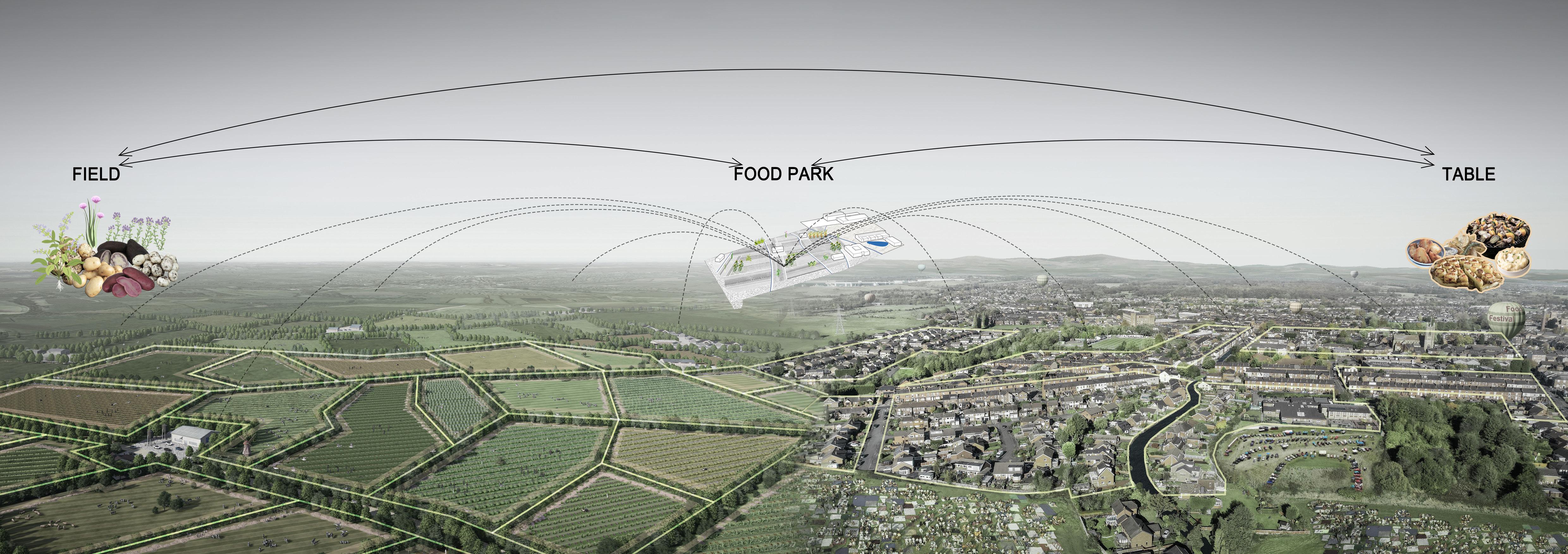
98 99
[7.4
The future vision]
FIG 7-6 the future vision of food park by Yihan Gu
1. “Field to Fork, Potato Harvest Reduced by Half: Food Waste.” n.d. ScienceDaily. Accessed September 5, 2022. https://www.sciencedaily.com/ releases/2015/10/151023105848.htm.
2. “Soil Nutrient Balances UK, 2020 - Statistics Notice.” n.d. GOV.UK. Accessed September 5, 2022. https://www.gov.uk/government/statistics/uk-and-england-soilnutrient-balances-2020/soil-nutrientbalancesuk-2020-statisticsnotice.
3. University of Sheffield. 2017. “New Land Cover Atlas Reveals Just Six per Cent of UK Is Built onLatest - News - the University of Sheffield.” Sheffield.ac.uk. November 8, 2017. https://www.sheffield.ac.uk/news/nr/land-cover-atlasuk-1.744440.
4. “Where Are Cereals Grown and Processed in the UK? | AHDB.” n.d. Ahdb.org.uk. https://ahdb. org.uk/knowledge-library/where-are-cereals-grown-and-processedin-the-uk.
5. “Current Issues Facing UK Farms and Farmers.” n.d. Www.agrirs. co.uk. https://www.agrirs.co.uk/blog/2021/07/current-issuesfacing-uk-farms-and-farmers.
6. “Food Sovereignty: The Struggle for a Fair Global Food System | War on Want.” n.d. Waronwant. org. https://waronwant.org/news-analysis/food-sovereigntystruggle-fair-global-food-system.
FIG7-3, 4, 5 Vocal for local."Vocal for local."https:// landworkersalliance.org.uk/vocal-for-local/.
Isabella Thompson, Rebecca Laughton, and Tony Little The Landworkers’ Alliance, Why regional food systems are the future , 2021.
A people's food policy."A people's food policy."https://www. peoplesfoodpolicy.org/
Jennifer Heim and Mike Perry, The Plunkett Foundation: Making Local Food Work , 86.
Monty Don, foreword to CPRE’s From field to fork: the value of England’s local food webs report ,2012.
Growing Manchester(s) Veg People."Growing Manchester(s) Veg People."https://www.mountalexander.vic.gov.au/Files/DESD/ Growing_Manchester.
100 101 [7.5
Reference]
1.FIG1-2 food sovereignty movement. reference. “Food Sovereignty.” Wikipedia, Wikimedia Foundation, 1 Feb. 2019, en.wikipedia.org/wiki/Food_sovereignty.
2.FIG1-5 food sovereignty movement in UK. reference."Food Sovereignty Now!" Foodsovereigntynow.org.uk, foodsovereigntynow.org.uk/. Accessed 21 Apr. 2022. Heath, Yali Banton.
"Why We Need a UK Food Sovereignty Movement." Landworkers Alliance, 16 June 2021, landworkersalliance.org.uk/why-we-need-a-uk-food-soveriegntymovement/. Accessed 21 Apr. 2022.
"A New Movement Is Born: Food Sovereignty in the UK." Global Justice Now, 12 July 2012, www.globaljustice.org.uk/news/ a-new-movement-is-born-food-sovereignty-in-the-uk/. Accessed 21 Apr. 2022.
3.FIG2-1 potato history. reference. Digimap, http://digimap.edina.ac.uk/. Wikipedia Contributors. 2019. “History of the Potato.” Wikipedia. Wikimedia Foundation. April 4, 2019. https://en.wikipedia.org/wiki/History_of_the_potato.
4.FIG2-2 potato dishes of different periods. reference. Byron, May. 1914. Pot-Luck. Dawson, Thomas, and Maggie Black. 1596. The Good Housewife’s Jewel. Lewes, East Sussex: Southover Press. May, Robert, and W W. 1600. [the Accomplisht Cook ... ]. London. More, Hannah. 1795. The Cottage Cook; Or, Mrs. Jones’s Cheap Dishes, Etc. [Signed: Z., I.e. Hannah More.].
Wooley, Hannah. 1670. The Queen-like Closet; Or, Rich Cabinet; Stored with All Manner of Rare Receipts for Preserving, Candying, and Cookery.
5.FIG2-5 consumption of fresh and processed potatoes in UK. reference. Department of Environment Food and Rural Affairs (2020). (DEFRA) Family Food Datasets. GOV.UK.
6.FIG2-6, 10, 11 potato cultivation in 1600s/ table and attitude in 1600s, 1700s. reference. The museum of the home, London.
7.FIG3-1 how the modern food system works. reference. "Calculating the Cost of Growing Spuds," Farmers Weeky, Cctaber 16,2012htos:/wwwfw.c.ukiarablelcalculating-the cost of gixxing ots. "Potato Costs Set to Rise by 30%," w.armninglfe.com,February 17,2012, inds)www.faming lie comicountyand-famingpotato-costs-set-oriseby-30.3572327.
8.FIG3-2 potato supply chain. reference. Digimap, https://digimap.edina.ac.ukl .Rufus Pilgrim, The Future of the UK Potato Industry (AHDB Potatoes, 2017). Yell, https://www.vell.com/s/potato+suppliers-uk.
9.FIG3-3 planting potatoes. reference. “A Potatoes Journey: From Field to Fork.” n.d. Robert Lindley Ltd. https://www.robertlindleyltd.co.uk/a-potatoes-journey-from-field-to-fork/. Digimap, https://digimap.edina.ac.uk/. Grimme, https://www.grimme.com/uk/products/kartoffeltechnik.
“A Potatoes Journey.: From Field to Fork "Robert Lindley Ltd, n.d., https:/lwww. robertlindley'td.co.uxd/a-potatoes-journey -from-feld-o-fore.
10.FIG3-5 processing and selling potatoes. reference. ETH Zurich."Field to fork, potato harvest reduced by half: Food waste."ScienceDaily. www.sciencedaily.com/ releases/2015/10/151023105848.htm(accessed June 12,2022). https:/Awww.fwi.co.uk/prices-trends#/.
11.FIG3-7 resources consumption and outputs. reference. ETC Group. Who Will Feed Us? 3rd ed., 15 Aug. 2017, etcgroup.org/whowillfeedus.
12.FIG3-8 market share of giant companies. reference. War on Want. Food Sovereignty Report. 11 Jan. 2011, www.waronwant.org/resources/food-sovereignty-report.
13.FIG3-9 global control. reference. Digimap, https://digimap.edina.ac.uk/.
“Cargill Worldwide | Cargill.” Www.cargill.com, www. cargill.com/page/worldwide.
“Our History | Bunge.” Bunge.com, 2015, www.bunge.com/whowe-are/our-history.
“A Journey through the History of Bayer.” Www.bayer.com, www.bayer.com/en/history.
“Our Heritage and Story at LDC || Louis Dreyfus Company.” Global, www.ldc.com/who-we-are/about-us/heritage/.
14.FIG3-10 violations of food sovereignty. reference. Jordan, et al. “Cargill: The Company Feeding the World by Helping Destroy the Planet.” Unearthed, 25 Nov. 2020, unearthed.greenpeace.org/2020/11/25/cargilldeforestationagriculture-history-pollution/.
Hertzler, Doug. “Important Victories against Agribusiness
Land Grabs in Kenya.” ActionAid USA, 31 Aug. 2016, www.actionaidusa.org/blog/important-victoriesagribusiness-landgrabs-kenya/. Accessed 20 Apr. 2022.
15.FIG3-13 food waste and hunger. reference. Digimap, https://digimap.edina.ac.uk/.
The Food Security Information Network (FSIN)
16.FIG3-17 dissappearing potato growers. reference. Potato Council,"United Kingdom | PotatoPro,"October 13,2013, https:/www.potatopro.comlunited-kingdom/potato-statistcs.Luffness mains, https://luffnessmains. com/farmingl.
Poskitts, https:/www.poskittcarrots.co.uk/.
17.FIG4-1 the map of special potatoes. reference. Digimap, https://digimap.edina.ac.uk/. maghera. 2017. “Old-Fashioned Potato Varieties.” Maghera Heritage Centre. July 15, 2017. https://www. maghera-heritage.org.uk/tag/old-fashioned-potato-varieties/.
18.FIG4-2 conditions of Pembrokeshire. reference. Digimap, https://digimap.edina.ac.uk/. "Pembrokeshire Food Park".https://www.pembrokeshire.gov.uk/property-detail/pembrokeshire-foodpark-withybushhaverfordwest.
19.FIG 4-10 organisations. reference. "Southernfarmers".https://southernfarmers.co.uk/ "Biodynamic Land Trust".https://biodynamiclandtrust.org.uk/ "The Community Farm".https://www.thecommunityfarm.co.uk/ ''Made In Hackney''.https://madeinhackney.org/ "The Great British Food Hub".https://thegreatbritishfoodhub.com/
20.FIG6-6 soil assessment. reference. AgEdLibrary, "Understanding Soil Color." June 12, 2022. https://www. senecahs.org/pages/uploaded_files/Soil%20Color%20E%20Unit.
21.FIG6-11 companion plants and potatoes allocation. reference. Rasa, Tabula. 2022. “Potato – Foremost.” Tabula Rasa. March 13, 2022. https://tabularasa.org.uk/2022/03/13/potato-foremost/.
“Jamieson Brothers.” 2022. Jamieson Brothers. 2022. https://www.jamiesonbrothers.com/golden-wonderseed-potatoes.
“Potatoes ‘Golden Wonder.’” n.d. En.edunclub.ru. Accessed January 20, 2023. https://en.edunclub.ru/ recipe/60948-potatoes-golden-wonder/.
“Pembrokeshire Early Potatoes - Great British Chefs.” 2015. Www.greatbritishchefs.com. June 25, 2015. https:// www.greatbritishchefs.com/features/pembrokeshire-early-potatoes.
Green, Timothy. 2016. “Highland Burgundy Red Potato Crisps.” Morghew Park. August 22, 2016. https:// morghew.com/highland-burgundy-red-potato-crisps/. https://www.gardenersworld.com/ https://www.rhs.org.uk/
Hailey, Logan. 2022. “32 Companion Plants to Grow with Potatoes.” All about Gardening. August 22, 2022. https://www.allaboutgardening.com/potato-companion-plants/.
102 103 [7.6 Appendix]
1. “What Is Food Sovereignty? | Food Sovereignty Now!” n.d. Foodsovereigntynow.org.uk. https:// foodsovereigntynow.org.uk/foodsov/.
2. “Via Campesina.” Wikipedia, 17 Mar. 2022, en.wikipedia.org/wiki/Via_Campesina#cite_noteMembers-1. Accessed 19 Apr. 2022.
3. Maitreuweb. “DECLARATION of NYÉLÉNI - Nyeleni - via Campesina - Newsletter, Bulletin, Boletin.” Nyeleni.org, nyeleni.org/spip.php?article290.
4. Wikipedia Contributors. “Food Sovereignty.” Wikipedia, Wikimedia Foundation, 1 Feb. 2019, en.wikipedia.org/wiki/Food_sovereignty.
5. Robert Smith (cook. 1725. Court Cookery: Or, the Compleat English Cook.
6. Earle, Rebecca. 2020. “Feeding the People,” June. https://doi.org/10.1017/9781108688451.
7. William Buchan, 1797.
8. “What Is Food Sovereignty? | Food Sovereignty Now!” n.d. Foodsovereigntynow.org.uk. https:// foodsovereigntynow.org.uk/foodsov/.
9. “Five Reasons Why a Portion of Potatoes Helps the UK Economy.” n.d. CHAP. https://chapsolutions.co.uk/blogs/five-reasons-why-tucking-into-a-portion-of-potatoes-helps-the-ukeconomy/.
10. Goffart, Jean-Pierre, Anton Haverkort, Michael Storey, Norbert Haase, Michel Martin, Pierre Lebrun, Daniel Ryckmans, Dominique Florins, and Kürt Demeulemeester. 2022. “Potato Production in Northwestern Europe (Germany, France, the Netherlands, United Kingdom, Belgium): Characteristics, Issues, Challenges and Opportunities.” Potato Research, January. https://doi.org/10.1007/s11540-021-09535-8.
11. “A Potatoes Journey: From Field to Fork.” n.d. Robert Lindley Ltd. https://www. robertlindleyltd.co.uk/a-potatoes-journey-from-field-to-fork/.
12. EIT Food. 2020. “Potato Loss and Waste in the UK Supply Chain and at Home.”
13. Gould, Ptrick. 2020. “The Potato Wasters: A Sociological Study of the UK Potato Industy.” THE UNIVERSITY OF MANCHESTER.
14. Thompson, Isabella, Rebecca Laughton, and Tony Little. 2021. “Vocal for Local: Why Regional Food Systems Are the Future.” The LANDWORKERS’ ALLIANCE.
15. ETC Group. Who Will Feed Us? 3rd ed., 15 Aug. 2017, etcgroup.org/whowillfeedus.
16. Lawrence, Felicity. 2011. “The Global Food Crisis: ABCD of Food – How the Multinationals Dominate Trade | Felicity Lawrence.” The Guardian. June 2, 2011. https://www.theguardian.com/ global-development/poverty-matters/2011/jun/02/abcd-food-giants-dominate-trade. War on Want. Food Sovereignty Report. 11 Jan. 2011, www.waronwant.org/resources/foodsovereignty-report.
17. “United Kingdom | PotatoPro.” 2013. PotatoPro. October 13, 2013. https://www.potatopro. com/united-kingdom/potato-statistics.
18. Green, Author Liana. 2020. “Types of Potatoes - Know Which Potato Varieties to Use When!” Liana’s Kitchen. September 1, 2020. https://lianaskitchen.co.uk/types-of-potatoes/.
19. Puffinproduce."Puffinproduce."https://www.puffinproduce.com/our-growers/.
20. Pembrokeshire."Pembrokeshire."https://www.pembrokeshire.gov.uk/
21. Rob Booth, Farming the future:Transforming the ownership of food systems research and data 2021.
22. Pembrokeshire Food Park, Withybush, Haverfordwest."Pembrokeshire Food Park, Withybush, Haverfordwest."https://www.pembrokeshire.gov.uk/property-detail/pembrokeshire-food-parkwithybushhaverfordwest
104 105 [7.6 Appendix]

106






























 FIG3-2 potato supply chain by Meike Lei, Jiamin Hu, Yihan Gu
FIG3-2 potato supply chain by Meike Lei, Jiamin Hu, Yihan Gu


















































































 FIG6-8 field kitchen section by Meike Lei
FIG6-9 food park recipe book by Meike Lei
FIG6-8 field kitchen section by Meike Lei
FIG6-9 food park recipe book by Meike Lei

















 FIG6-13 fields in spring by Meike Lei
FIG6-13 fields in autumn by Meike Lei
FIG6-13 fields in summer by Meike Lei
FIG6-13 fields in spring by Meike Lei
FIG6-13 fields in autumn by Meike Lei
FIG6-13 fields in summer by Meike Lei



 FIG6-14 overview section in summer by Jiamin Hu
FIG6-14 overview section in autumn by Jiamin Hu
FIG6-14 overview section in summer by Jiamin Hu
FIG6-14 overview section in autumn by Jiamin Hu






